Tusaayaksat
Kyle Kuptana
Kyle Kuptana
National Aboriginal Role Model
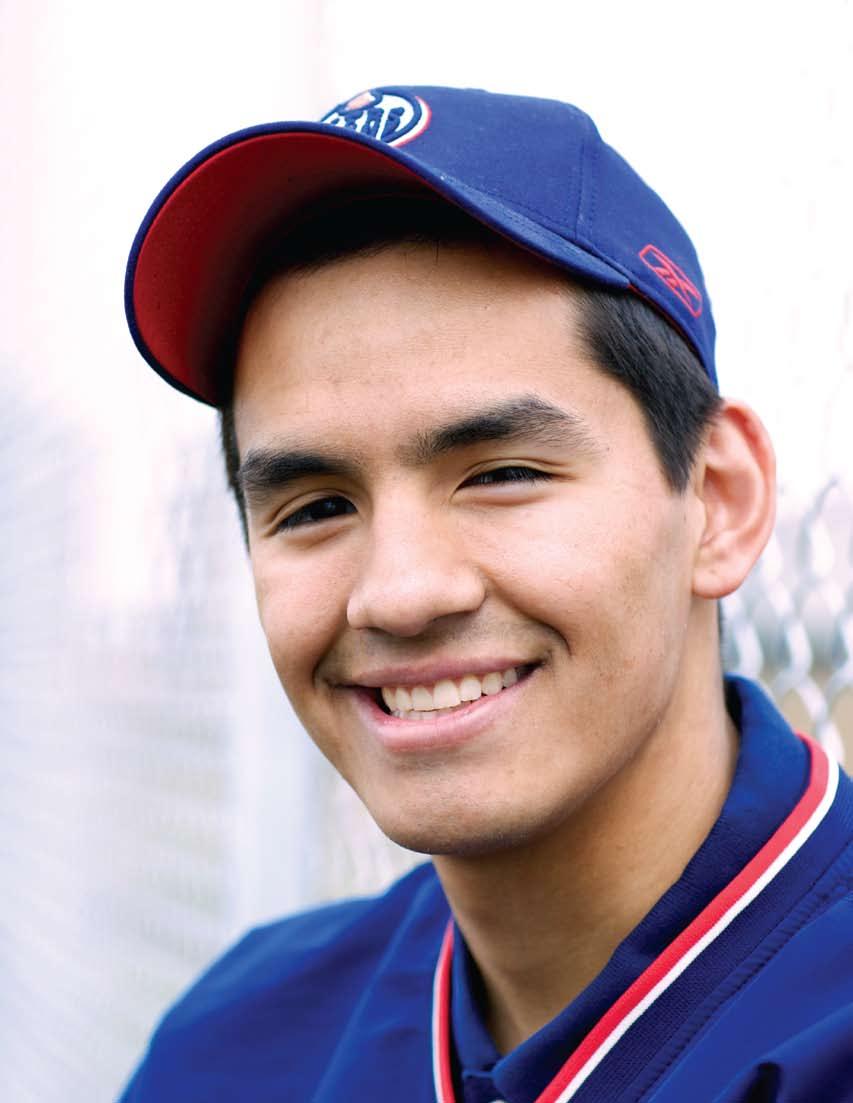
ISR Graduates!
Governor General Visits Inuvik + Tuk
Climate Change discussion on the Amundsen
DREAM BIG!
Volume 22 Number 3 SUMMER 2008 $4.00 Inuvialuit News + Culture
Tusaayaksat


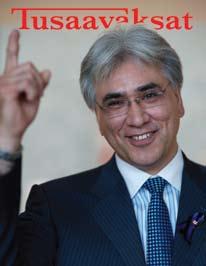
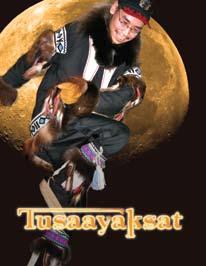
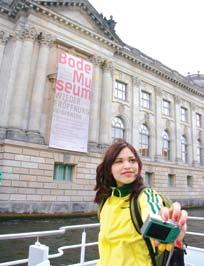
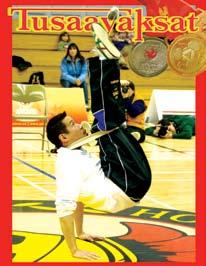
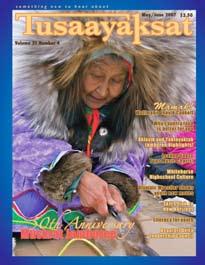

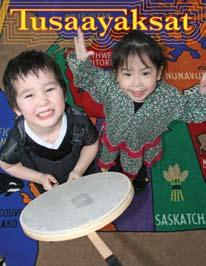
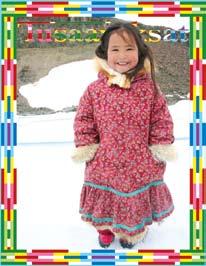
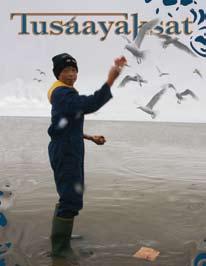
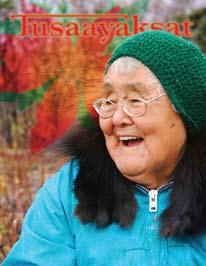
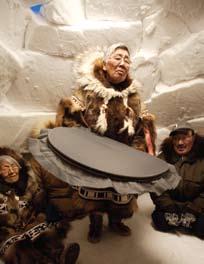
2008 Quyanainni Volume 21 Number 6 September/ October 2007 $2.50 something new to hear about horton river builds character new mexico soccer gold andy carpenter & cope ivvavik inspires northern fashion show inuvialuit professionals Volume 22 Number 1 November/December 2007 $2.50 something new to hear about NWT Premier Floyd Roland O N TOUGH LOVE Elders Helping Scientists STOKES POINT CLEAN UP Jessie Colton: RENEWING TRADITION Literacy Lives Here Curfew in Inuvik Capacity Building FOR RESIDENTIAL SCHOOL SURV VORS YOUTH MONITORING CARIBOU something new to hear about Volume 21 Number 2 January/February 2007 $2.50 Paulatuk Moonlight Dancers Mary Evik Ruben Canada Winter Games Caribou Workshop Beluga Harvest Venturing For th: Dez Lo een Esther Wolki Children’s Contest! Inuvialuit RCMP Volume 21 Number 5 July/August 2007 $2.50 something new to hear about From the Arctic to Germany! GraduationSalutations! NelliePokiak:Collegeisforallages! Bushcamps Past and Present Inuvialuktun Language Immersion Ulukhaktok Kingalik Jamboree something new to hear about Volume 21 Number 3 March/April 2007 $2.50 Going for Gold Inuit Games at the Canada Winter Games Edward Lennie, Father of the Northern Games IRC Native Hockey Cup Edmonton Special: Achieve Your Dreamz Moving South for a Change Larga Home Away from Home Sachs Harbour Environmental Monitoring Course Caribou Summit Inuvialuit Guardian Angels Ulukhatok Revives Printshop Lila Voudrach Phillip Jacobson something new to hear about Volume 20 Number 2 March/April 2006 $2.50 something new to hear about Volume 20 Number 3 May/June 2006 $2.50 MUSKRAT JAMBOREE 2006 AGNES FELIX LOVE POINTERS SELF-GOVERNMENT YOUNG MUSKRAT TRAPPER REPORTS KURT WAINMAN THE GREAT NORTHERN CIRCUS MAKTAK STIR-FRY IRYC PICS! AWG WINNERS HAPPY BIRTHDAY EMMA DICK! & Lots More! something new to hear about Volume 20 Number 4 July/August 2006 $2.50 NELLIE ON TRADITION & CHANGE REINDEER UPDATE DRIMES TRADITIONAL ARTS INUVIALUIT DAY YOUTH RAP TO BUTT OUT JAMBOREE IN TUK, AKLAVIK & ULUKHAKTOK PETROLEUM SHOW & CLASS OF 2006 GRADUATION! something new to hear about Volume 20 Number 5 September/October 2006 $2.50 Beaufort Delta Residential School Reunion Mary Simon's Vision for Inuit Great Northern Arts Fest Jordin Tootoo visits Edmonton Jacob Archie on Trapping New Legislation for Tuktoyaktuk Hunters Tony Alanak to teach Fiddling Cindy Voudrach + Confidence Lanita Thrasher Flies High Top of the World Film Festival something new to hear about Volume 20 Number 6 November/December 2006 $2.50 Emma Dick "It's Good to Wake Up in the Bush!" Christmas Greetings from the ISR What do we want? Safe Homes! Iqalukpik Jamboree Margaret Lennie Inuvialuktun Writing System CN Rail Memories Kendyce Cockney "John John" Stuart & The Tuk Youth Center The Bomber Pages! Children’s Story & Contest Inside! Volume 22 Number 2 SPRING 2008 $4.00 Inuvialuit News + Culture Tusaayaksat Ulukhaktok drum dance reunion Sachs Harbour muskox harvest Nellie’s commitment IRC Hockey Cup highlights Good news for Ulukhaktok Artists For advertising and subsription inquiries, please email us at tusaayaksat@ northwestel.net or call 867 777 2320. Tusaayaksat o ur goal: to celebrate and showcase the voices of Inuvialuit across Canada, bringing you the best coverage of our news, vibrant culture, and perspectives. Thank you for your supporT. Please support us by advertising with us. We offer advertising discounts to Inuvialuit businesses.
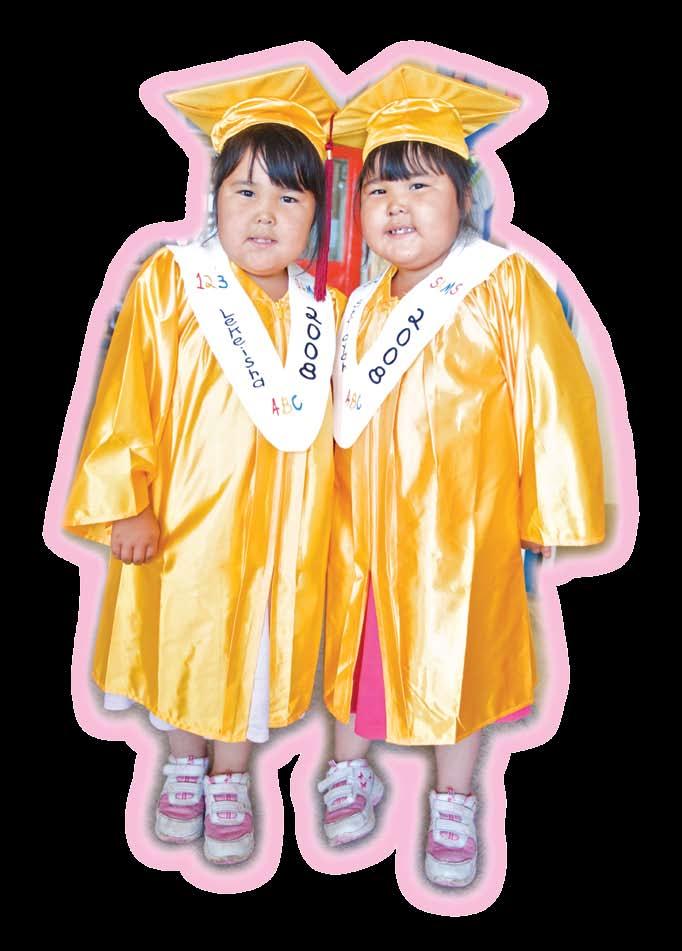
3 Publisher Topsy Cockney Inuivaluit Communications society, Executive Director Editor/Writer/ Creative Dir. Zoe ho Tusaayaksat {is Inuvialuktun for “something new to hear about”} Inside: Contributors anne Crossman Markus siivola Lindsay Trevelyan pat Dunn simon routh adam k. Johnson Proofreading simon routh Photography David stewart Zoe ho Design, Illustration, Layout & Typography Zoe ho Translation LIllian Elias ICS Board of Directors President foster arey, aklavik Vice-President Joanne Eldridge, sachs harbour Secretary-Treasurer sarah rogers, Inuvik Directors stan ruben, paulatuk Joseph sr. kitikudlak, ulukhaktok Jimmy komeak, Tuktoyaktuk 10 {Special Feature Nuitaniqsaq Quliaq} Content Highlights ISR Graduates! In The News Tusaayaksani 70 ResidentialCanada’sApologyto School Survivors In The News Tusaayaksani 52Ottawa Bureaucrats Meet the North In The News Tusaayaksani 24 ClimateChangePolicy MeetingonAmundsen 30 50thAnniversary ofInuvik SpecialFeatureNuitaniqsaqQuliaq 62 GovernorGeneral BringsMagictoISRSpecialFeatureNuitaniqsaqQuliaq We acknowledge the financial support of the Government of Canada through the Canada Magazine Fund toward our editorial costs. Printing Quality Color Identical twins Lekeisha and Shayala Elias graduated together from SAM School’s kindergarten program!
Kyle Kuptana is definitely going to remember this year’s Aboriginal Day. His day began in Ottawa, where the Governor General of Canada, in partnership with the National Aboriginal Health Organization, presented him with a National Aboriginal Role Model award. Kyle is one of twelve recipients chosen from among Inuit, First Nation and Metis youth all over Canada to receive this award.
James Makokis, spokesperson for the Aboriginal Role Model Program, and National Aboriginal Achievement Award winner said, “First Nations, Inuit, and Métis youth are choosing to lead healthy, active lives and succeeding in all areas, including the arts, humanities, commerce, politics, sports, science, and technology. Role models are authentic individuals who are true to their identities. They give others the courage to push beyond their own potential, opening the door to new possibilities.”
Kyle was nominated by his peers, as were the rest of the award winners. “I’d like to thank the person who nominated me,” he said. “I never thought I’d be chosen. I've always thought of myself as just another person to pass on the wisdom. Now that I’ve won, I won’t change anything; I will continue to do what I do.”
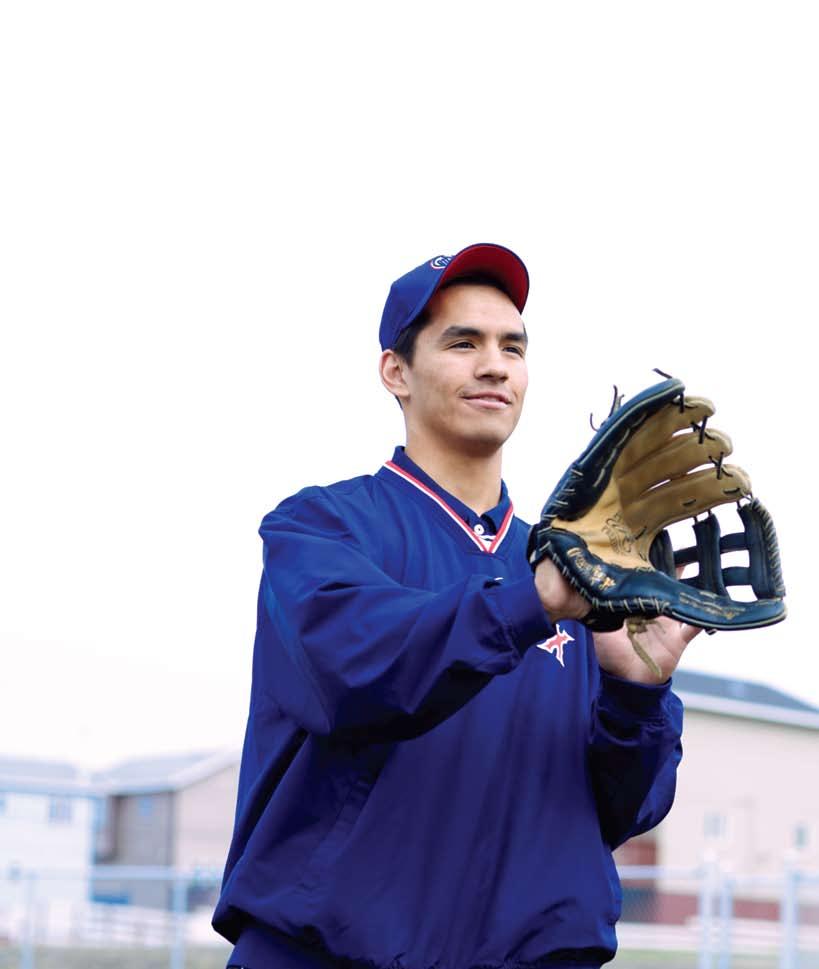
TUSAAYAKSAT SUMMER 2008 4
As a strong athlete who has won numerous awards in sports such as arctic games, soccer, baseball, and hockey, including national awards. Kyle is generous with his time when it comes to helping other young people get active. His generous spirit means that young people learn to play like him, for the love of the game, and not only for the sake of winning. Last year, Kyle coached a team of about twenty youth from Tuktoyaktuk, Aklavik, and Fort McPherson in minor baseball. He found the youth responded better to his guidance, as he knows them and is close to their communities.
“They usually respect and listen to me,” he said of the youth he coaches, “They know that if I was not there, there is nobody else to coach them in baseball. Also, many of them are my brother’s friends, they come over to my house all the time.”
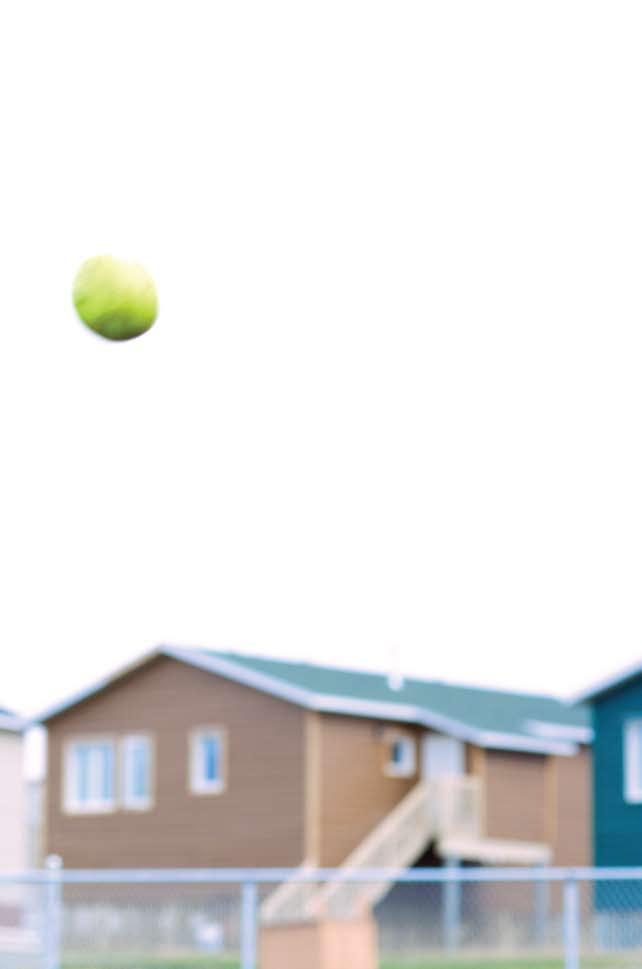
This summer, you will continue to see him coaching young people in baseball and soccer on the small community field in Inuvik. He will also be assistant coach for Team NWT at the North American Indigenous Games held this August in Cowichan, British Columbia. The head coach is his father, Donald Kuptana. It was Donald who had encouraged Kyle to start coaching.
After his graduation from Samuel Hearne Secondary School, Kyle is now pursuing a Natural Resources Technician Program at Aurora College in his hometown.
“It’s a fun course. We learn about botany, combining traditional and scientific knowledge,” he said. “I hope to work for ENR (Ministry of Environment and Natural Resources).” He is interested in this career path as he loves the outdoors. Born and raised in Inuvik, Kyle is not thinking about leaving.
“I want to stay here and contribute to the community. I like it in a small town, there’s no panic to get anywhere, you know everyone and I feel safe here,” he said. “I hang out with a lot of people who don’t like staying in town, but I don’t see what the problem is. We have more freedom here than people living in cities, we can go out to nature, which is calm and soothing, such as fishing in Husky Lakes.”
It is especially Kyle’s ability to stay strong in the face of peer pressure that makes him vital as a role model. When asked what he thinks about drugs and alcohol, the substances that young people often abuse due to peer pressure, he said, “I’ve no use for it. I’ve never tried.”
The life of a young aboriginal person is not an easy ride, especially in a small town. There are tragedies and circumstances outside of their control that cause some to turn to substance abuse. Kyle too has to deal with loss, but he said, “Many people drink or do drugs to deal, but we [he and his girlfriend] keep busy. I like playing baseball better than having a beer any day.”
Words and photography by Zoe Ho
“ Youth Speak Up Nutaqat Uqaqtut
Kyle practicing at Inuvik’s Ruyant Ball Field.
The 21st of June is the day of the summer solstice. It was a perfect day to celebrate under the midnight sun.
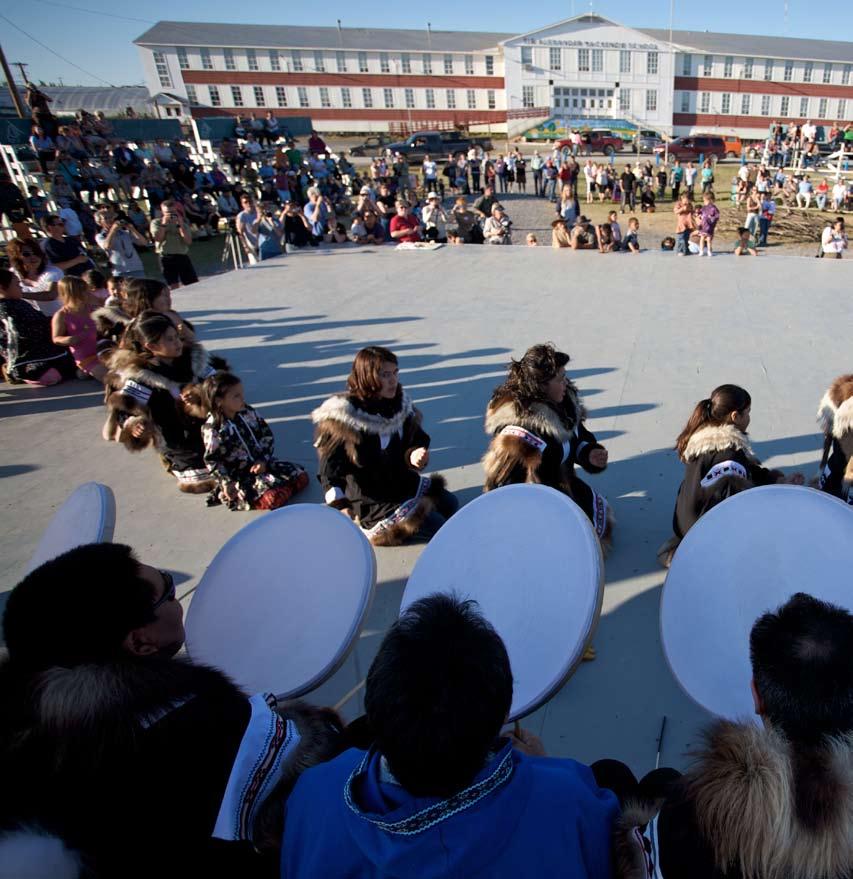
TUSAAYAKSAT SUMMER 2008 6
The Inuvik Drummers and Dancers took advantage of the large stage at Jim Koe Park to give an outstanding performance to a full audience.
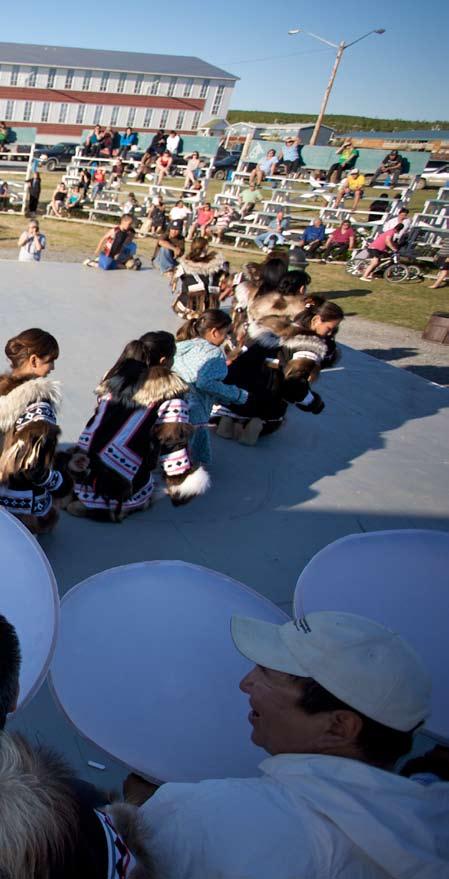
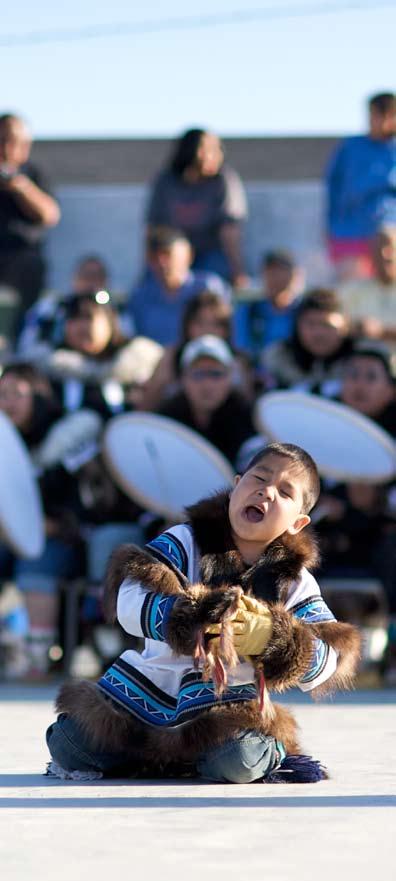
Special Feature Nuitaniqsaq Quliaq
Aboriginal Day 2008
Photography by David Stewart
Itwas a time to celebrate culture by dancing and making music. Youth, children, and adults all joined in. Elders square danced, played guitar, and sang their hearts out. There was also a feast, with country food such as roasted fish and muskrats.
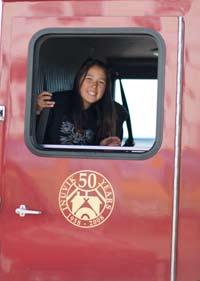
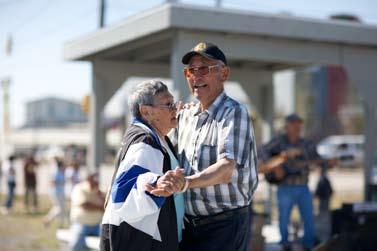
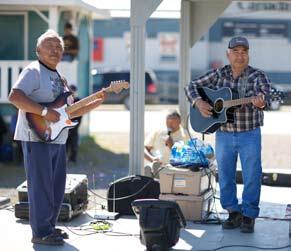
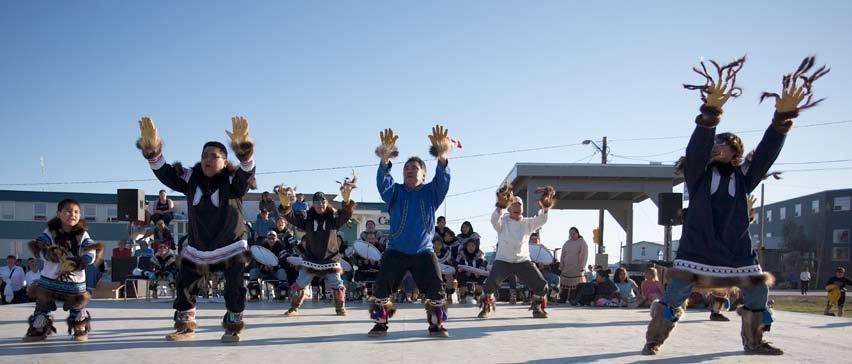

TUSAAYAKSAT SUMMER 2008 8 Special Feature Nuitaniqsaq Quliaq
Children lined up for fire engine rides around town.
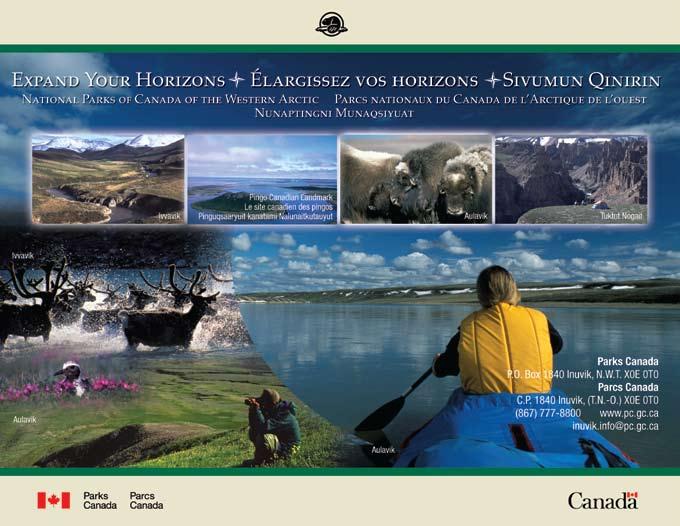

9
Graduation, Here we come!
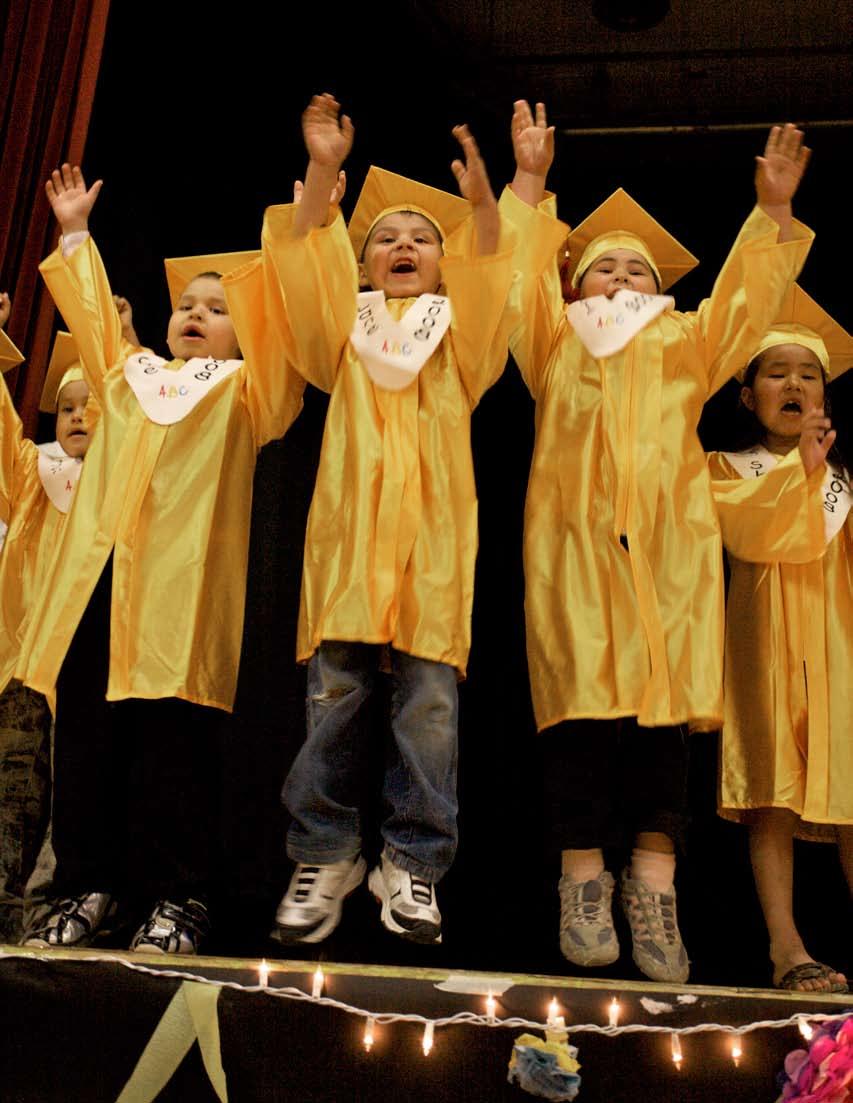 Jumping for joy: Cole Elias, Lane Voudrach, Isabelle Hendrick, and Skyla Kagyut are part of the kindergarten graduates who sang a song about how fun it was to be going from kindergarten to grade one.
Words by Lindsay Trevelyan
Photo by Zoe Ho
Jumping for joy: Cole Elias, Lane Voudrach, Isabelle Hendrick, and Skyla Kagyut are part of the kindergarten graduates who sang a song about how fun it was to be going from kindergarten to grade one.
Words by Lindsay Trevelyan
Photo by Zoe Ho
Grad glamour: Aklavik graduates chose a Hollywood theme that is echoed in many of the graduation celebrations around the Inuvialuit Settlement Region.
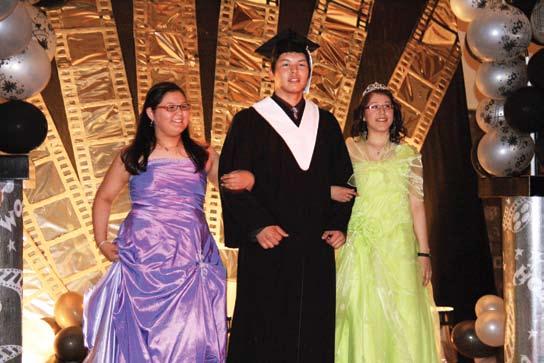
ats amuel h earne s econdary s chool
in Inuvik the graduates were eagerly hanging stars from the ceiling, and creating star-budded decorative trees awash in sparkles and balloons –the air was thick with anticipation. Every detail would be tended to, cared for, and made perfect. In Ulukhaktok, floors were waxed, speeches written, and food prepared. In p aulatuk, the gym was meticulously beautified to toast the achievement of their two graduates with a visit from n ellie Cournoyea, Chair of the I rC. a savoury ham, turkey and roast dinner topped it all off. In s achs h arbour at Inualthuyak s chool k indergarten Graduation and awards Ceremony, a blue and purple cap and gown was worn by each little graduate with pride. s imilarly, s ir a lexander Mackenzie s chool graduates in Inuvik wore gold caps and tassels, a detail made possible by the dedicated fundraising of the recycling club. In a klavik at Moose kerr s chool, graduation every inch was old h ollywood; arches of black and silver balloons, miniature film cameras, stars and pillars lining the graduate's official red carpet, all accented with a disco ball to set the sparkling tone.
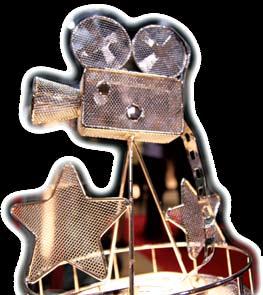
Watching and learning: Pre-school children are entralled by the photo slideshow of SAM School graduates.
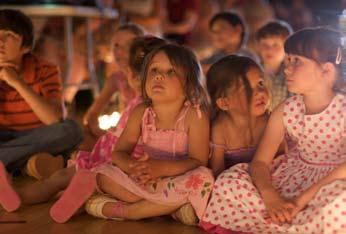
Throughout the Inuvialuit s ettlement region (I sr), June and July is the time for graduation ceremonies, each rewarding the diligence and dedication of the graduates. n one was sweeter than the graduation of Jonathan kudlak, u lukhatok’s sole graduate. h is advice to his peers and his twelve-yearold sister aiming for similar accomplishments: “keep getting up in the morning, go to school everyday, and work hard.” Each graduate interviewed gave very similar advice and there is no question that it has paid off. When asked about his upcoming graduation, Jonathan said he was speechless – but he was far from speechless come graduation day, where he delivered an address to the proud audience, among them his elders, his teachers, mother, father, grandmother, and his kindergarden teacher, all of whom played a key role in his success.
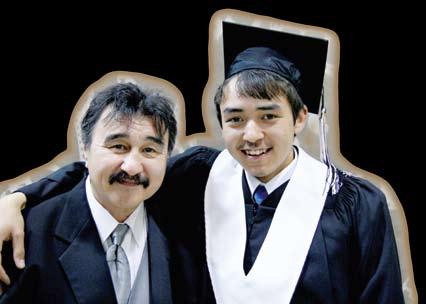
11
This is the face of graduation in the North: excitement, happiness and the culmination of hard work, and deserved celebration. Ranging in size from a single graduate to 40 accomplished students, each of these graduations mark a very special day.
Special Feature Nuitaniqsaq Quliaq TUSAAYAKSAT SUMMER 2008
Photo by Chris Yapp
Photo by Zoe Ho
Photo by Chris Yapp
Below: Richard Tardiff Sr. and his son, Richard Tardiff Jr.
Celebrating with family: Kristin Elias, Cindy Stewart, Chelsea Elias (SAMS grad), and Lillian Elias.
The level of formal education and highschool graduates has been steadily increasing across the n orthwest Territories. In 2005, the graduation rate exceeded 50% for the first time ever, and the strongest growth in graduation rates in the last twenty years have happened in the n orthwest Territories.
u nderstanding upgrading and higher education as crucial for shaping their futures, and the future of the n WT, many of the graduates of 2008 intend to keep learning, applying to schools and colleges across the country or closer to home.
In
The graduates from aurora College exemplify this, celebrating the completion of programs ranging from Management studies and Certificates in Traditional Arts to Office Administration Management and Early Childhood Development. The Campus in Inuvik had 18 female graduates in 2008, marking an incredible example of the strength of women graduates and the importance of higher learning.
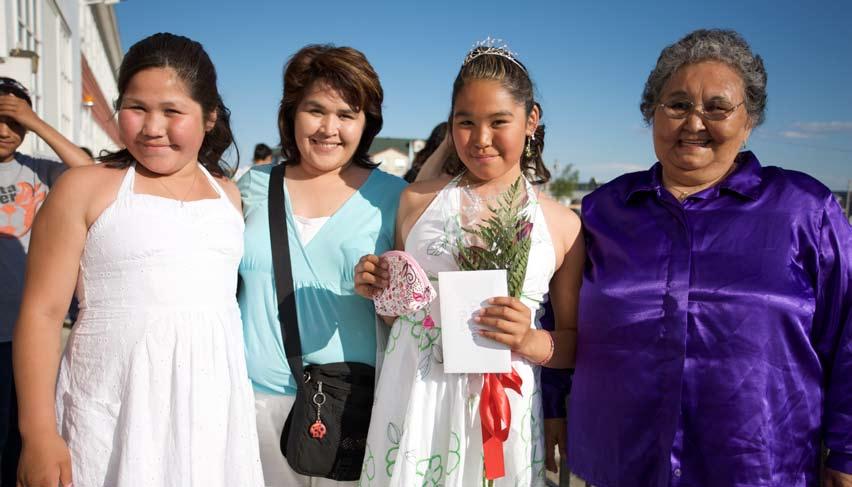
s ince 1996 the rate of female graduation has surpassed that of the male population. s heree McLeod, a graduate at s amuel h earne
s econdary s chool (shss) in Inuvik, is certainly part of that trend. awarded h ighest academic female and The Cliff k ing award, given to the graduate who made the most effort towards the graduation, s heree has a lot to be proud of. When asked whether or not she understood herself as the future of the n WT, she responded that though she is going south for schooling she will return to Inuvik in the future and hopes that more people will learn the languages and traditions of the n orth. “I don’t want anybody to forget our culture,” she says. a nd though she has no plans to be in politics, she will promote this through her work in art and technology.
s amuel h earne graduate Lawrence s ittichinli says school is a learning process. h e wasn’t always a good student but with guidance and determination he changed his ways. h e could not be happier.
a nother shss graduate, C.J. h aogak whom s achs h arbour principle Linda h all champions as a role model for all his peers, agrees that school requires diligence, with exams being the hardest part. he said he will not miss high school, but is looking forward to future learning in Edmonton.
a s s heree points out, the challenges of school are not limited to hard work and exams; bullying and the common pressures of adolescence are ever present. s heree credited much of her success to the support of her family and her older sister.
Next Page: Some of the graduates from Sir Alexander Mackenzie School.
1.Matthew Skinner, Mrs Stringer
2.Brandi Larocque, Mr. Deering
3.Jozef Semmler, Mr. Deering
4.John Gruben, Mr. Murphy
5.Keaton Cockney, Mrs. Stringer
6. Trevor Thrasher, Mr. Murphy
7. Trent Gordon, Mr. Murphy
8. Robyn Rinas, Mrs. Stringer
TUSAAYAKSAT SUMMER 2008 12
the wake of the formal Canadian apology to aboriginals for a history of residential schooling, many speakers, graduates, and attendees alike see a mission of education as central to the healing owed to the future generation. Graduates were encouraged to stay focused on objectives and goals and understand that learning is for life.
Photo by Zoe Ho
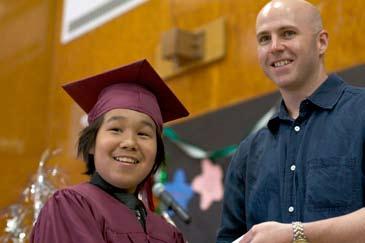
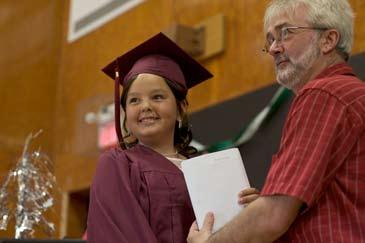
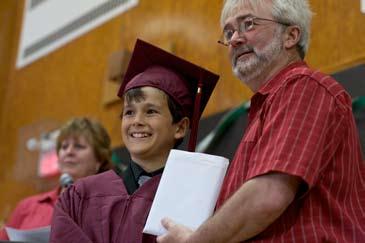
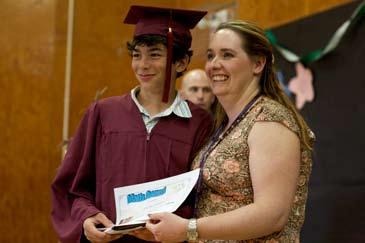
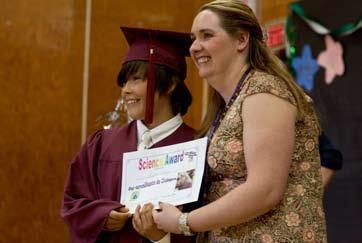
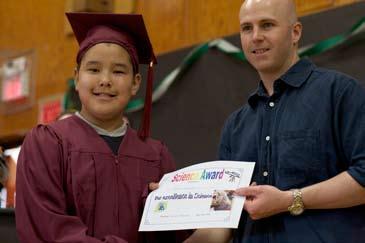
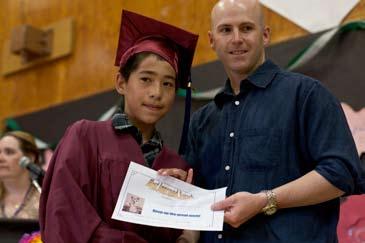
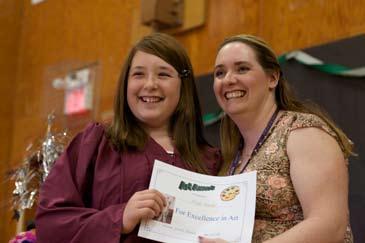
Special Feature Nuitaniqsaq Quliaq
Photos by Zoe Ho
What’s next for our grads?
Whatever he does, r ichard Tardiff Jr., a Moose kerr graduate, emphasized the importance of land preservation: “I want to do something for the land to save it. We have a rich culture here from hunting caribou to trapping and life on the land.”
a lso from Moose kerr, s heera a rey will work for a year and go to school in Edmonton for Business Management. s am McLeod will study to become a mechanic.
After a summer of fishing and potential work at the Hamlet, Jonathan kudlak of u lukhaktok plans to go to college, with the hopes of working in the mines or on an oil rig.
Photos by Chris Yapp
from shss , s heree McLeod and C.J. h aogak plan to continue their studies, and Lawrence s ittichinli, though currently working for h orizon n orth, has big plans to travel the world, starting with a ntarctica, (going to somewhere cold for a change!), Mexico and beyond! h e also intends to upgrade and continue his education at aurora College.
Whatever they do, we wish all our graduates congratulations and the best of luck in their bright futures!
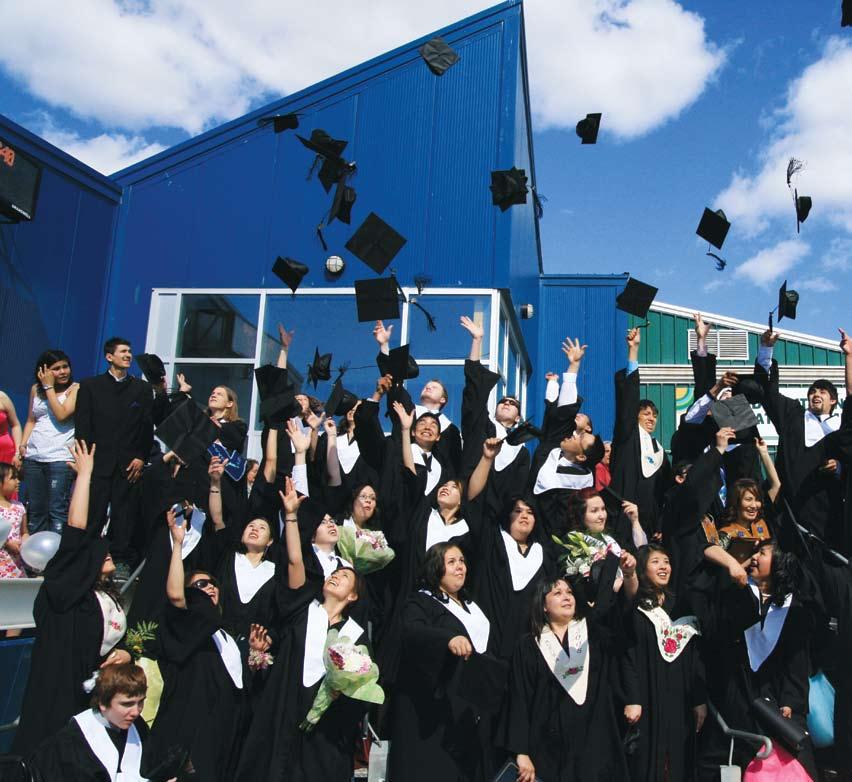
TUSAAYAKSAT SUMMER 2008 14
Nuitaniqsaq Quliaq Special Feature
Hats off to the grads: Samuel Hearne School graduates tossed their hats high into the air.
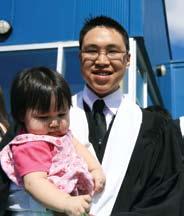
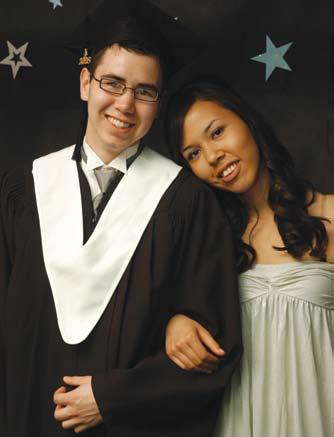
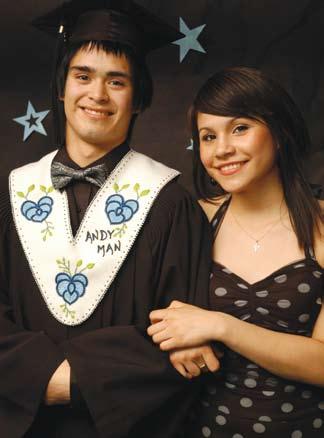
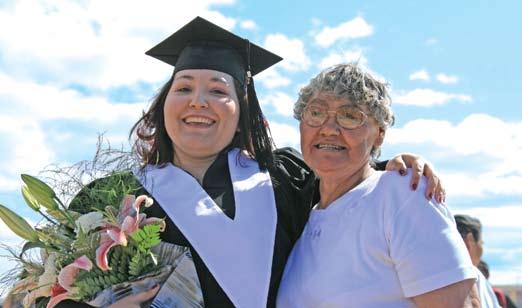
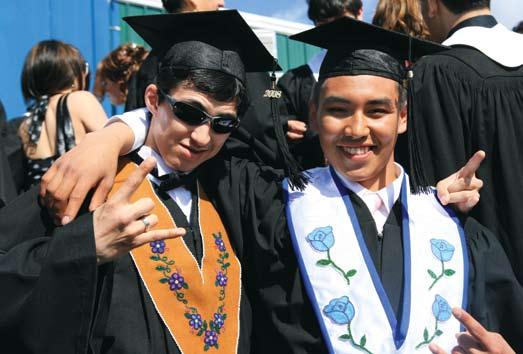
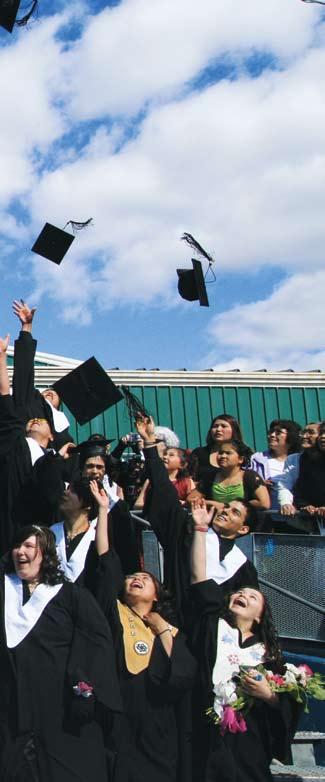
15
Andy Robertson and Shayna Allen
Doug Price and Haleigh Pielak
C.J. Haogak
Allan Roberts and Peter Lennie
Esther McLeodand her granddaughter, Sheree.
Photos by Maia Lepage
Our Time at SAMS
Elementary School Memories from Graduates
neta a llen and a ngel k alinek are both excited. n eta is searching for the perfect pair of shoes (flats, because she is twelve and does not care about heels) to go with her sky blue dress, and a ngel is looking forward to wearing her beaded slippers. Tuesday June 24th is their graduation day from elementary school in Inuvik.
n eta, who was so advanced in her kindergarten class that she was the only child to read chapter books, said there were times when getting through elementary school was hard.
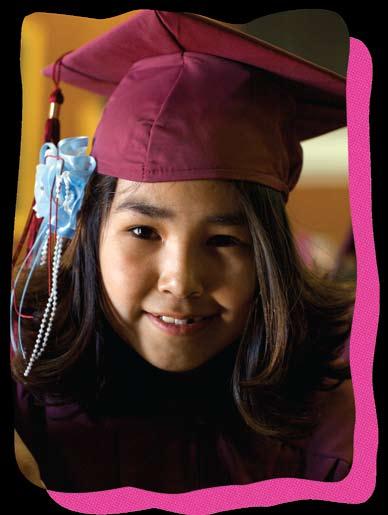
“ s cience class is hard,” she said, but she managed to pass all her grades. In fact, she scored the third highest mark in her class this year. “I love Maths. It’s my favourite subject,” said n eta. a ngel agrees that it is the best subject.
“I was at s ir a lexander Mackenzie s chool (sa M s) for 7 years. My favourite class in art. The most fun thing I did was to join the Delta Demons wrestling club.”

a ngel likes being part of k arry’s club. “We go to preschool to help the kids there with reading, and we go swimming, play at the park together, and go sledding in the winter.”
Both girls said they enjoyed school, especially all the traveling and cultural activities.
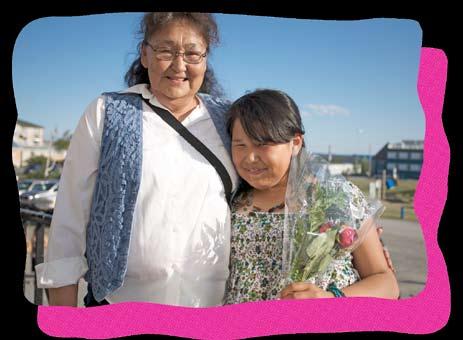
They went with the school to r achel reindeer Camp, to see the pingos in Tuktoyaktuk, to sa M s n unami Camp, and n eta even went as far as yellowknife and Calgary with the Delta Demons.
The girls are thankful for the help they had with their final exams. “o n my aaTs (a lberta achievement Test), my mum and my teacher Mrs. stringer helped me,” said neta.
"I’m very excited about high school,” said n eta, “because you can experience harder things.” a ngel is looking forward to woodshop in high school. s he likes making art, because she gets to work with her hands.
n eta is looking as far ahead as university. “I want to go to the u niversity of Calgary,” she said. s he had a tour of the university when she went there for a Wrestling tournament. “They have all kinds of things there – wrestling, dancing, nannies (students babysitting for pocket money), and gymnastics!”
In the meantime, the a boriginal Day weekend is all about anticipating their graduation. “It’s going to be a beautiful moment, graduation,” said neta. “There’s a song called Friends Forever that we get to sing when we graduate.”
“Rachel Reindeer camp was so much fun. We got to go sledding and don’t forget, the fishing!” said Angel. “And I got my first fish ever,” added Neta.
Angel Kalinek and her grandmother Renie on graduation day.
Neta Allen just graduated from elementary school, but is already thinking ahead to university.
Helen Kalvak SchoolUlukhaktok
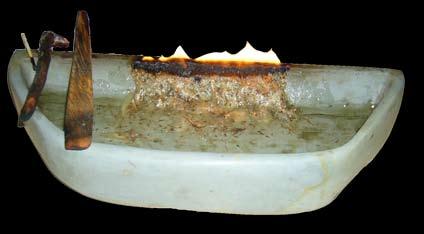
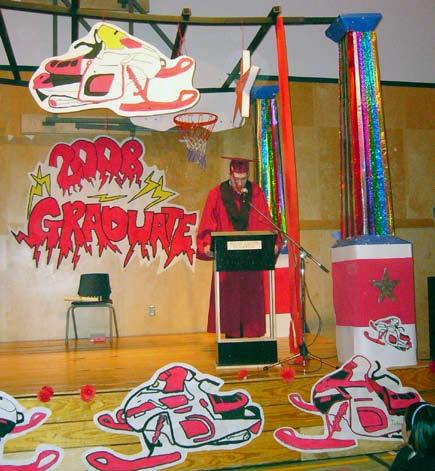
The one who inspires: Jonathan Kudlak, Ulukhatok’s sole graduate, advises his peers and his twelve-year-old sister to “keep getting up in the morning, go to school everyday, and work hard.”
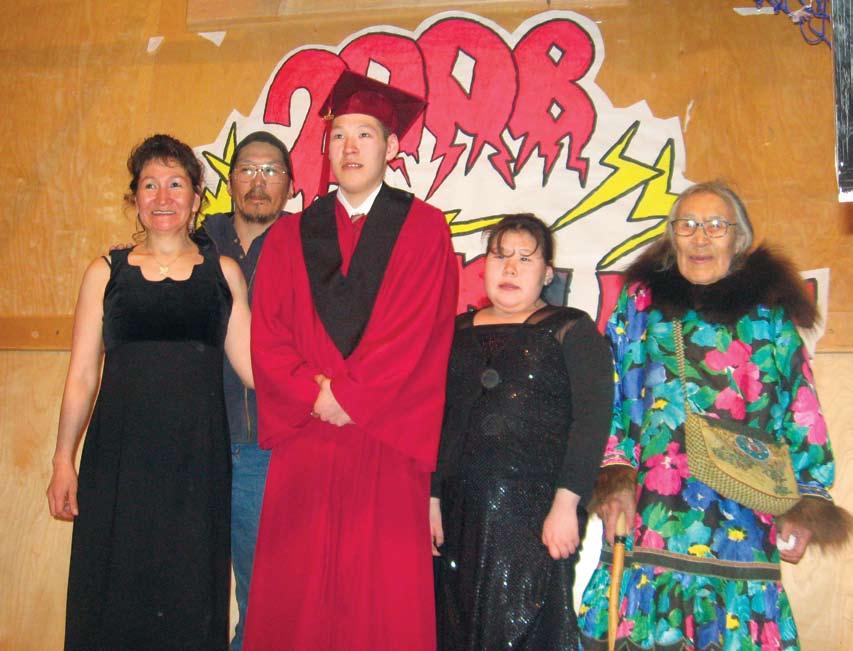
Special Feature Nuitaniqsaq Quliaq
Photos on this page by Chelsea Olifie (She also took the hockey photos of the McPherson Team and the Tuktoyaktuk team in the last issue!)
Photo courtesy of Emily Kudlak
Aurora College - Inuvik Campus
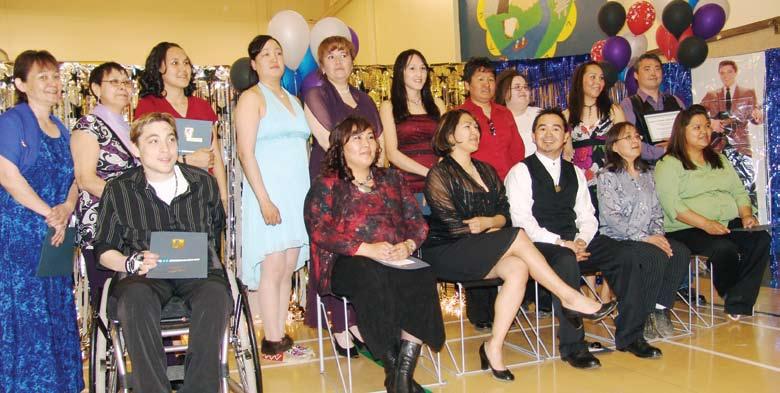
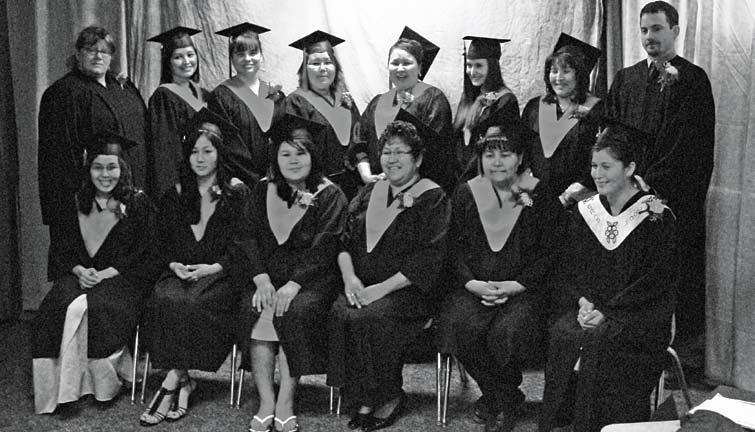
Aurora College Learning Center
TUSAAYAKSAT SUMMER 2008 18
Graduation Season 2008
Special Feature Nuitaniqsaq Quliaq
Top (L-R): Mary Ohkeena, Vera Ovayak, Lorianna Elanik, Sandra Gordon, Marjorie Baetz, Amanda Lennie, Esther Ipana, Sara Gardlund, Katherine Lennie, Russell Andre. Bottom (L-R): Devin Brodhagen, Jennifer Thrasher, Janice Elaink, Patrick Joe, Georgina Ohokak, Jodi Snowshoe.
On their way to good things: graduates from Aurora College.
Learning Center Graduates throw a retro party
Photos by Chris Yapp
An Inuvialuit Leader in the Making: Richard Payne
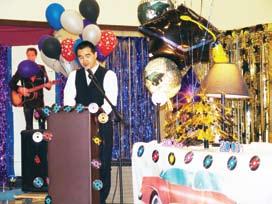
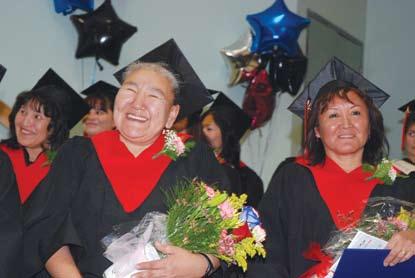
Richard Payne got to know the whole town of Fort Smith by the time he completed his Management Studies Diploma at the Aurora College Thebacha Campus. “I drove a cab all over town after school during the second year of my studies. It was better than struggling financially from week to week,” he said.
During his teenage years, Richard had gone to a private boarding school in Yellowknife. In Grade 8, he had the chance to visit Tuktoyaktuk and decided he wanted to “run away to Tuk.” Attempts by his father to get him back to the all-boys private school were rejected by Richard. It was eight years after Richard had left his high school studies before he decided it was worthwhile to give school another try. The deciding factor was family.
Richard had begun a lovely family with his wife Roseanne and their three children, Delanie Bucket, Cole James, and Ashton Jett. He wanted to give his children a better life. He was then living and working seasonally for EGT Transport and NTCL in Tuktoyaktuk.
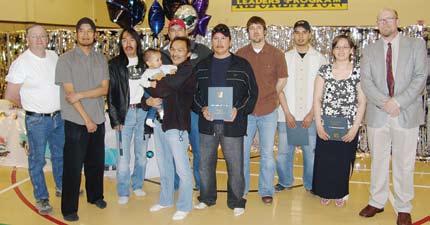
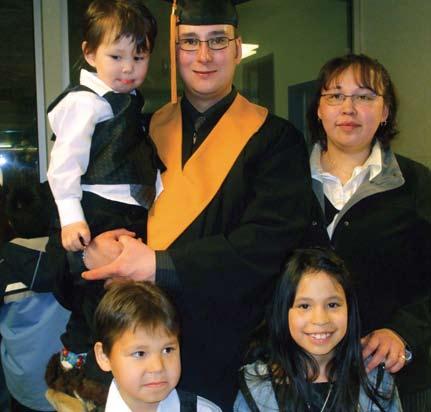
“I decided to go back to school after my son Ashton was born,” he said, “so that I could eventually find a full-time job that pays me enough to support my family.”
“At first I wasn’t sure if I would be able to get back into the whole school routine again, but I am really glad and proud that I did and graduated.” Even though it was challenging to balance getting his diploma and driving a cab part-time, Richard was determined to stay on track. He cites the support of his family as crucial to his success. Right after graduating, he accepted an office manager position with NTCL in Inuvik. He is now practicing his newly learned accounting and management skills.
“I chose Management Studies because I can see myself in a leadership role in the future; hopefully with an Inuvialuit company or with the Inuvialuit Regional Corporation,” he added.
“I have been traveling all over but have always returned home to Tuktoyaktuk. I am proud to be Inuvialuit and glad to be part of such a successful and organized group of people. I feel that the people of IRC and IDC and all the other parts that represent the Inuvialuit people have done great, and hope to one day join them in leading the Inuvialuit people.
Graduation Season 2008
Richard Payne and his family.
Verna Arey and Annie Buckle are happy adult learners!
Trades Access Program graduates.
Patrick Joe making a graduation speech.
Photo courtesy of R. Payne
Angik School - Paulatuk Angik School - Paulatuk
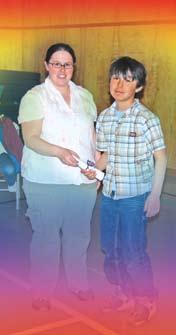
Kindergarten Graduates
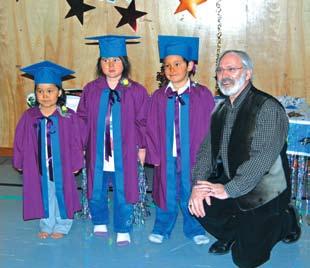
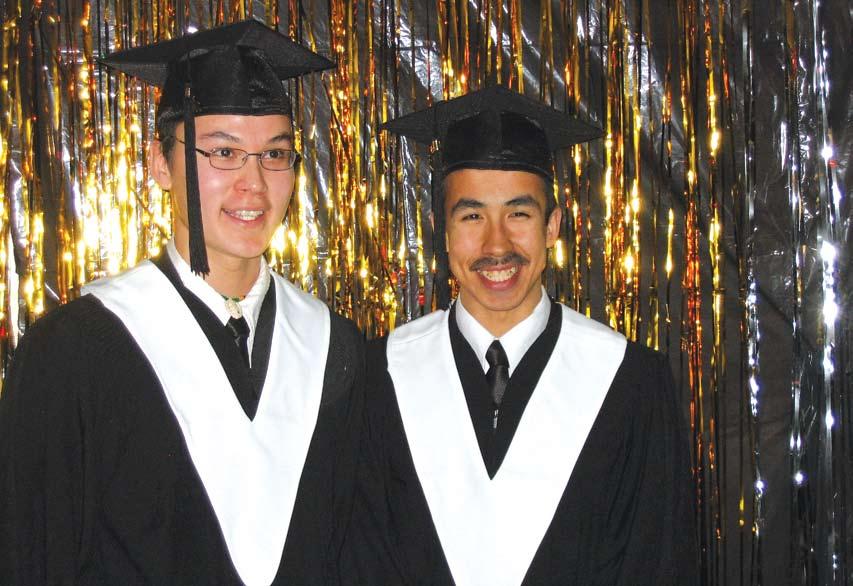
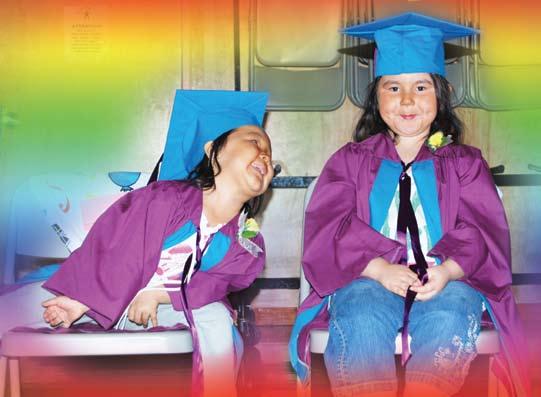
Cheyenne Haogak
Meagan Kolola
Rosanne Lennie
Caleb (Ry Ry) Lucas

Grade 9 Leaving
Tyson Esau-Raddi
Steven Lucas
Selene (Tessa) Lucas
Inualthuyak School- Sachs Harbour
Proud smiles: Angik School graduates Aaron and Stacy beam for the camera.
Photo courtesy of Jessica Schmidt
Photos courtesy of Linda Hall
BIZ WHIZZES from Ulukhaktok
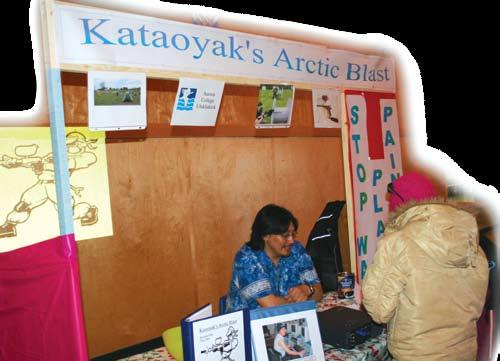
fred k ataoyak had so much fun playing paintball, a game where people wield guns loaded with balls of paint instead of bullets, that he was inspired to start his own paintball facility in Ulukhaktok. “I played for the first time when I was in Edmonton. I didn’t want to stop but it was too expensive to play any longer,” he said. To make his dream come true, fred enrolled and has just graduated from the aurora College s mall Business Development program at the u lukhaktok Learning Center. There he met other like-minded local entrepreneurs who had passions they wanted to turn into businesses.
Lori o vilok wanted to start a business with her painting skills, roberta Memogana had a rctic crafts to market, a nita wanted to show tourists how beautiful the north was, and Gillbert Olifie wanted to showcase her a rctic arts. o n May 13th, they all graduated from the small business development program, launching their businesses with trade booths at the h elen k alvak s chool gym. Visitors who came were treated to multimedia displays and celebratory drum dancing.
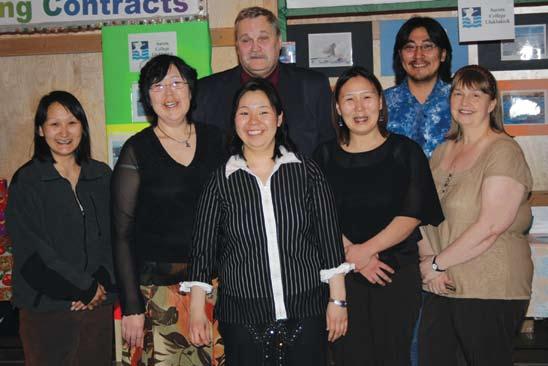
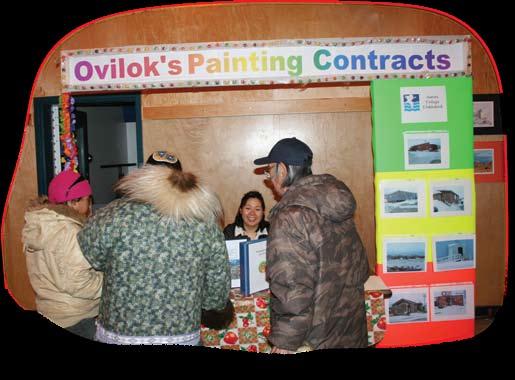
When asked which of his classmates’ idea he was most impressed with, fred said, “I think everybody’s ideas are good, all it takes now is for us to take the steps to register the businesses and to start running them. Before I started this course I didn’t know much about accounting and business laws. I have that knowledge now. I am happy I finally got to learn how to start up my own business.”
fred named his business ‘a rctic Blast.’ h e has some strategies for making it take off with a blast. “I am going to make getting into the game a bit cheaper, and if people want to play more, they’ll have to pay for the paintballs,” he said. “And it’s definitely a summer thing. If you played in the winter, the paintballs will be frozen, you will get pretty bruised,” he laughs. Good luck to all five new entrepreneurs from Ulukhaktok!
21
Graduates from the Aurora College Small Business Development Program at the Ulukhaktok Learning Center:
Roberta Memogana , Gillbert Olifie, Lori Ovilok, Anita Oliktoak, Diane Williams (instructor), back row Mel Pretty (instructor) and Fred Kataoyak.
Fred and his ‘Arctic Blast’ trade booth.
TUSAAYAKSAT SUMMER 2008 Special Feature Nuitaniqsaq Quliaq
Lori Ovilok and her Ovilok’s Painting Contracts display.
Photos courtesy of Diane Williams
Workplace Readiness Graduates
TheI rC Workplace readiness program celebrated its first six graduates this Spring, with a rousing ceremony at the Ingamo h all friendship Center. n ellie Cournoyea, Chair of the Inuvialuit regional Corporation expressed her pride in the graduates and her support for their program, which is designed to help unemployed young adults bridge their way into the work world. “Each and every one of you are very important to me and I am proud of you for overcoming difficulties and challenges to be here today. s ome people might say that this program only has a half success rate of graduates, but I will say that every one of you count and every graduate is a success.” a ll the graduates had excelled at their work placements and some have had their contracts extended beyond their practicum.
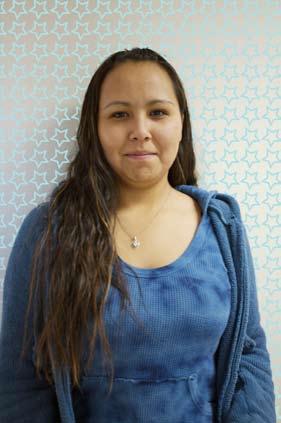
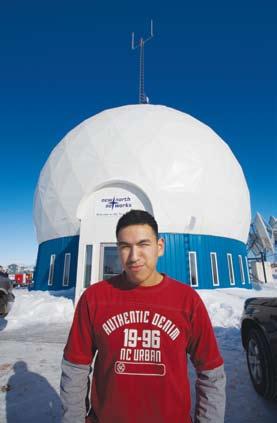
“I feel more confident after this program,” said Rena Gordon, a young mother who at first found it hard to juggle her training and family duties. She admitted the thought of quitting passed her mind, but the program became more interesting as it progressed.
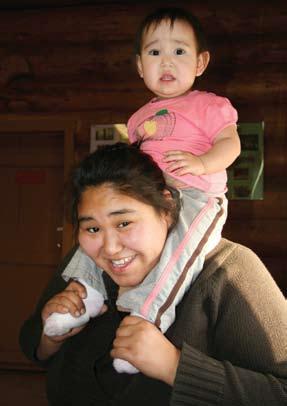
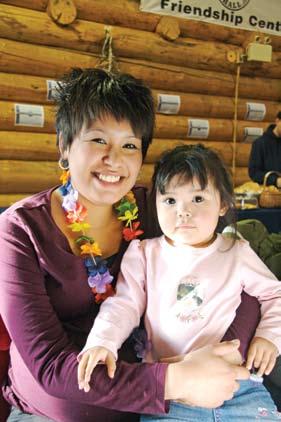
“I’ve learnt a lot and my job at Aurora College is my first job. I guess I am ready for the work field now. I would like to thank everyone at the college for their warm welcome to me when I arrived, and for their patience.” rena hopes to work towards starting her own business one day.
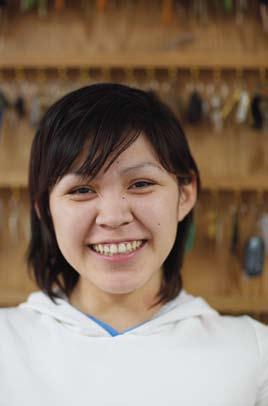
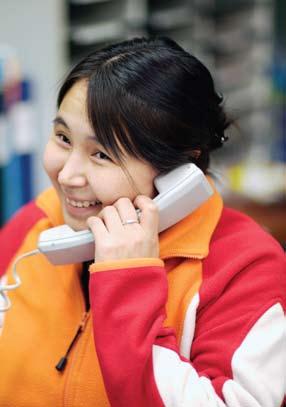
22
TUSAAYAKSAT SUMMER 2008 Special Feature Nuitaniqsaq Quliaq
The graduates completed their work placements mainly with companies in Inuvik. s arah k aglik worked at n orthwind Industries, Debbie a ngasuk at Inuvik Gas/ Matco, a manda Wolki at the Joint s ecretariat, russell s mith at n ew n orth n etworks, rena Gordon at aurora College and priscilla Taylor at Canadian n orth in yellowknife. Gloria o mingmak was able to begin working in her home community, u lukhaktok, after participating in this program. The participants’ familes, children and friends applauded their success and hard work as each received their joint-certificate from the Inuvialuit Regional Corporation and Bow Valley College.
russel s mith said, “This course has taught me how to focus better.” h is interest in photography has been nurtured in this program, and working at n ew n orth n etworks had allowed him to learn more about technology. russel is always fascinated by aircrafts and had made one of his program assignments into an opportunity to take photos of pilots.
s arah k aglik had prepared a valedictorian speech but unfortunately had to miss the graduation when her child was sick. We include here an extract of what she wanted to say:
I now have a job that you - such very kind people - helped me to achieve. I thank each and every one of you for joining us tonight, and especially for your help in finding such great, kind instructors and coordinators who love to help others. I’d like to mention some memorable moments that we all have shared together but throughout the program there has been many... Did anyone bring their digital story?
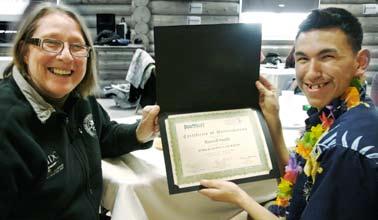
n obody? Well, that was a memorable month, the month when we learnt to use computers, sound and visuals to tell stories. We also learnt many other skills, preparing mentally and ability wise for work in the real world. I had some pretty hard times attending this program, due to me being a single working mom, but with the help of family and the instructors here, I managed to keep going strong, and I was determined to find what I was looking for in life: A full time job, and the many friends that I’ve made and will make.
IRC Provides Largest Distribution Payments To Date
The lobby of the Inuvialuit Corporate Centre was bustling as of 8:30am on May 7th, 2008. The Inuvik Community Corporation (ICC) was distributing beneficiary cheques for beneficiaries aged eighteen and over, and many had come by to pick up their cheques before going to work. The Inuvialuit Corporate Group reported a net income of $35.2 million in 2007 and shared its success with beneficiaries with distribution payments of $1,001.09 each. A total of 3,812 beneficiaries received payments.
“It’s going well,” said Gayle Gruben, office manager of the Inuvialuit Regional Corporation (IRC) as she checked off the name of a beneficiary. k atherine Lennie, who is a student at aurora College, welcomed the extra income. “My cheque and my boyfriend’s cheque are going right on the Visa. We are also going to Calgary this friday,” she said. “It helps us out.”
Elder Edward Roland believes the payments will serve practical purposes, “This will help a lot of people who are going out on the land. It will provide food to young kids, it makes everybody happy because some people don’t work and live on social assistance. This payment will come in handy somewhere down the line as long as it’s spent wisely.”
I rC subsidiaries – Inuvialuit Development Corporation, Inuvialuit Investment Corporation, Inuvialuit Land Corporation and Inuvialuit petroleum Corporation –contribute to the distribution. The I rC Distribution Policy is based on a formula that ensures sufficient reinvestment of profits to guarantee the preservation and growth of the landclaim capital for future generations of Inuvialuit. These reinvestments fund programs aimed at enhancing education, as well as the social and cultural development of the Inuvialuit.
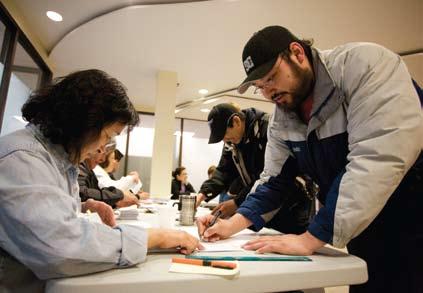
n ellie J. Cournoyea, Chair and CEo of I rC said, “The distribution to our Inuvialuit beneficiaries is the largest to date. We are pleased to share our financial success with the beneficiaries, and look forward to its continuation in the years ahead.”
Beneficiary Dez Loreen reflected, “We are well represented by our corporation. It helps us be better off than most aboriginal groups.”
Photos page left: (L-R) Sarah Kaglik worked at Northwind Industries, Debbie Angasuk at Inuvik Gas/ Matco, Amanda Wolki at the Joint Secretariat, Russell Smith at New North Networks, Rena Gordon at Aurora College and Priscilla Taylor at Canadian North in Yellowknife.
In The News Tusaayaksani
This page: Inuvialuit leader Nellie Cournoyea and Russell Smith show us Russell's hard-earned certificate.
Logan Bullock signs in with Mary Inuktalik of ICC to get his cheque.
CIRCUMPolAR INUIT
Climate Change Policy Workshop abroad the Amundsen
Theicebreaker Amundsen is currently sitting in a flaw lead in the a rctic ocean,near the Inuvialuit communities of s achs h arbour and p aulatuk. The scientists conducting oceanographic studies on the research vessel are convinced of the urgency to mitigate the effects of climate change, and are making full use of their time on this International polar year research initiative.
This a pril, the Inuit Circumpolar Conference (ICC) held a Circumpolar Inuit Climate Change policy Workshop aboard the a mundsen. a rctic leaders from the circumpolar region had the chance to meet the scientists and to observe and ask questions about how the research applies to the needs of their people. The leaders came away impressed by the scope of the research, but national Inuit leader Mary s imon did note that it was hard to see immediately the relevance of scientific research to traditional Inuit knowledge and needs.
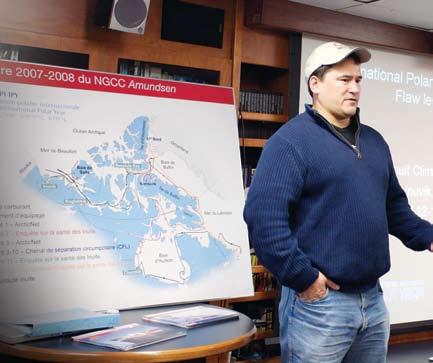
The delegates from each ICC region reported on the effects of climate change in their area, as well as on the adaptation of their people. a lthough their stories are told in different languages, the thread of commonality amongst the climate change symptoms observed from a laska, Chutkotka, Canada and Greenland was astonishing. We could see the connection between the suffering reindeer herders of Chutkotka, and the ones in the Inuvialuit s ettlement region. n ew species of insects are being observed, and shorelines are eroding at accelerating rates. Inuit are the people on earth most affected by climate change, experiencing a myriad of symptoms brought on by global warming that is affecting adversely the animals they harvest and the land and sea ice they rely on.
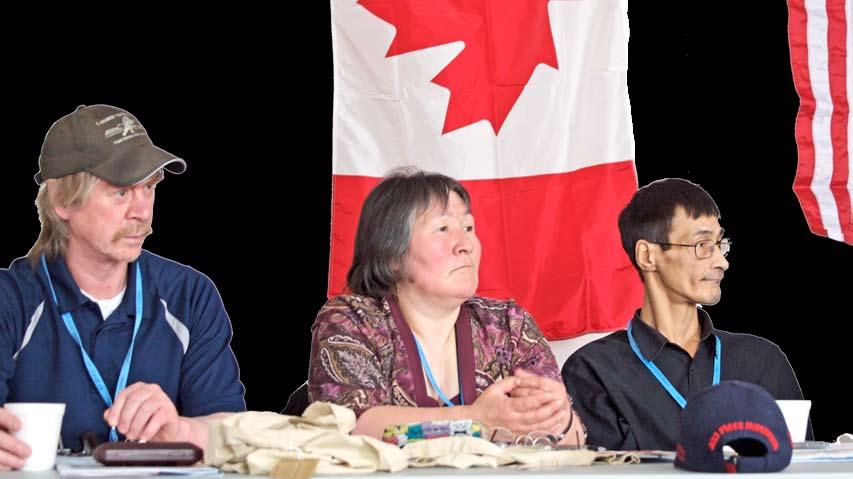
TUSAAYAKSAT SUMMER 2008 24
The leaders concluded that it is imperative to continue their cooperation and to escalate their efforts, to make sure the indigenous perspective is placed on the table at global decision–making levels. At the political level, the leaders also said it was important to take climate change into account when making infrastructure and socioeconomic decisions.
Joey Carpenter, Margaret Kanayok, and Ruben Ruben are on the Inuit Navigating A Changing Climate in Canada Panel.
ICC President Duane Smith stressed the urgency of mitigating climate change impacts.
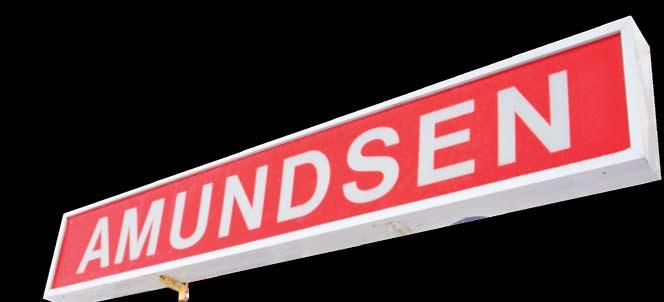
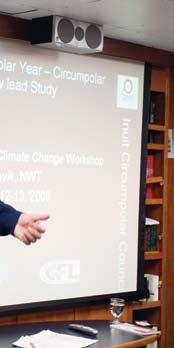
Stephanie Meakin (ICC support staff) and NWT premier Floyd Roland learn from a scientist about living organisms on the bed of the
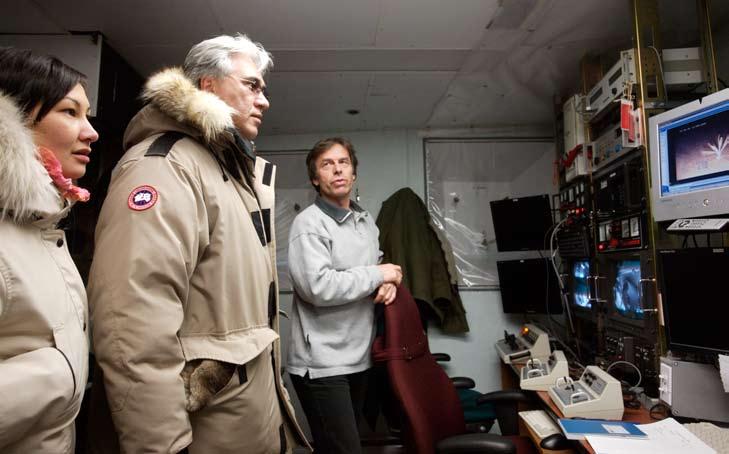
The problem of climate change is thus not isolated, and the pressure for change to improve the situation for these Inuit who are connected becomes exceedingly obvious given the evidence they have observed. o ne of the components of the Circumpolar flaw Lead system study (C f L) will focus on “Two ways of knowing.” Led by Team 10 of the C f L study, and a Traditional k nowledge steering committee made up of Inuit community members, this component hopes to integrate Inuit traditional knowledge with the findings by the other teams, with the vision of achieving research objectives that respond to community needs.
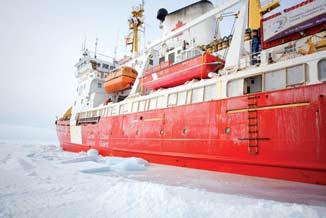
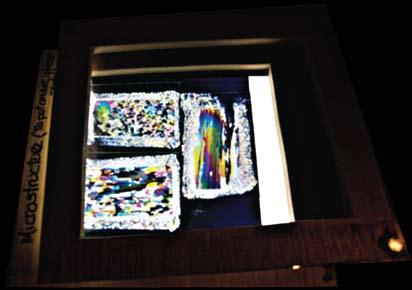
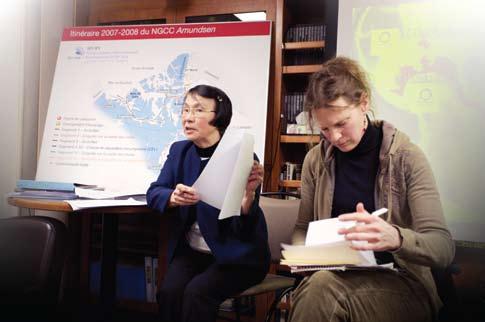
In The News Tusaayaksani
Amundsen, the ice-breaker research vessel.
Tatayna Achirgina (left), ICC member from Chutkotka, reports on impacts to reindeer herders and shorelines.
arctic ocean.
Ice cores are taken from the sea ice, shaved into millimeter-thin slices and analyzed. >>
EN v IR o NMENTA l IST
This summer, James Kuptana will be coming to your communities to conduct research for Team 10 of the Circumpolar Flaw Lead System Study. The Trent University student brought a youth perspective on climate change to the Circumpolar Inuit Climate Change Policy Workshop, and chats with us about his role in the project.
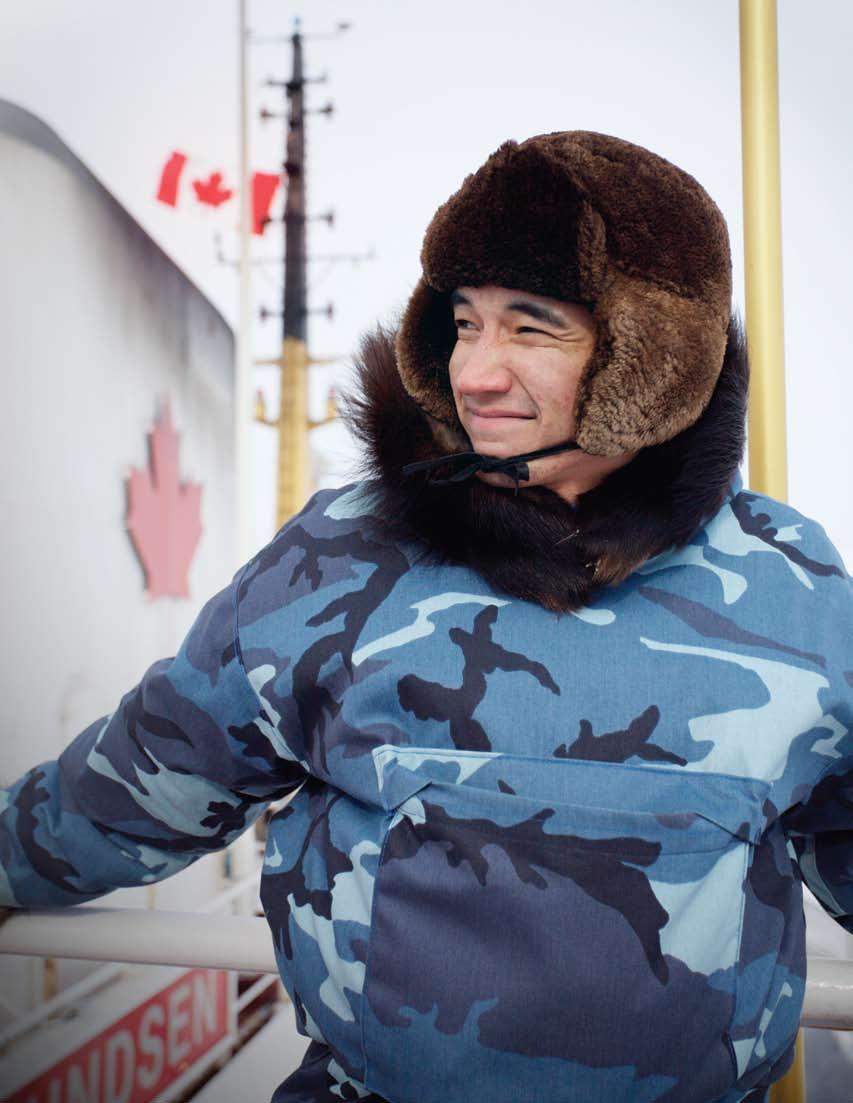
yo UTH
James on the deck of the Amundsen.
Tell us about your chosen field.
James: I am currently in the field of Indigenous Environmental Studies; it is an arts degree, which focuses on human ecology but there is also a science component to the program.
What is your role on this trip?
James: I will be meeting with other key stakeholders involved in the Circumpolar Flaw Lead System Study. My obligation, to my understanding, is to bring a youth perspective to Team 10 and also to gather traditional Inuvialuit Knowledge about the flaw lead.
What was it like to communicate with elders on Team 10?
James: It was just like talking with any other person. They understand my message and where I am coming from. Elders have so much knowledge all you have to do is be around and active in your life to learn from them. You learn by watching and doing.
What did you hope to achieve with your presentation at the Climate Change Policy Workshop?
James: I just wanted to bring a young person’s perspective to the table. My main point was regarding education; uneducated, unaware people need to know what is happening and how the world is changing. I used the past winter as an example; much of Canada received record snowfalls and many naive people said: so much for climate change...Climate change is much more than just global warming; it can result in changing precipitation patterns, altering sea levels, re-directing animal migrations, and much more.
Did being on the Amundsen add to, or change your perception of climate change in the north?
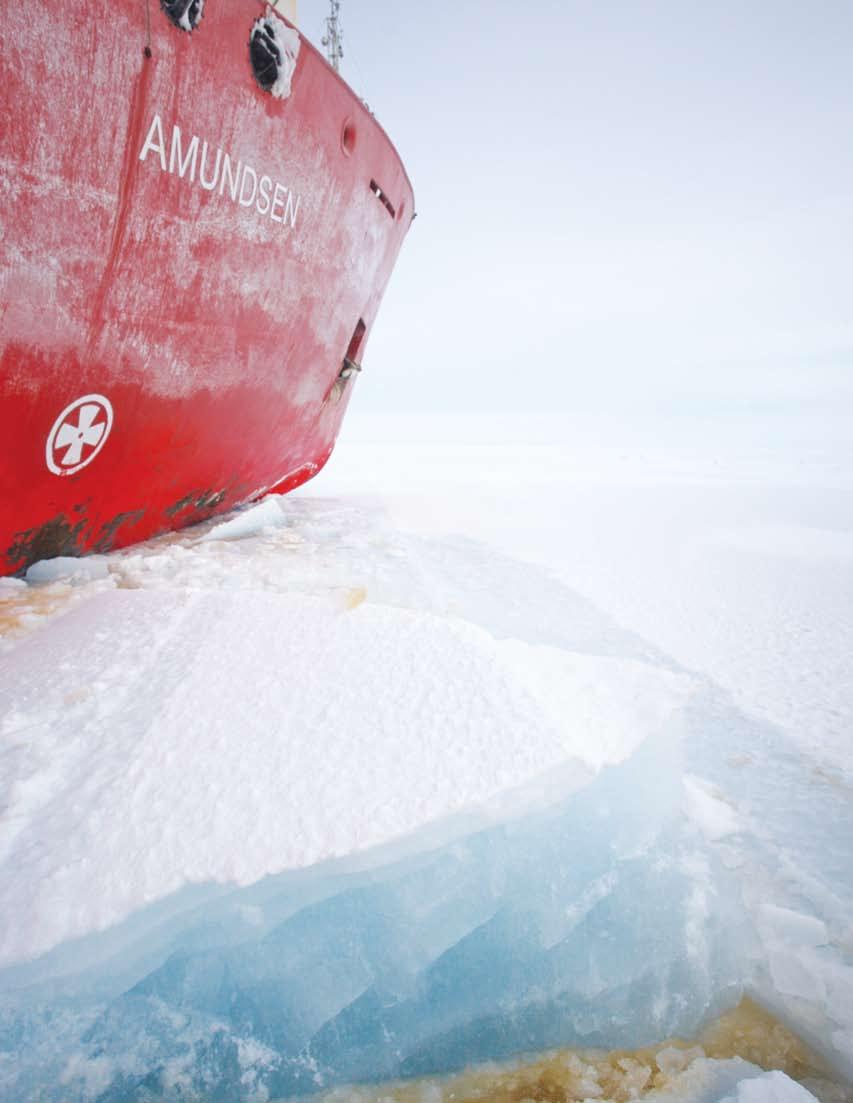
James: Being on the ship was an eye–opener, to see what scientists are doing to understand the science behind climate change. The research being conducted on the Amundsen has the potential to change our understanding of how the Earth's systems work and how they are changing. I think this trip to the Amundsen and Inuvik was beneficial because it gave me the chance to see what Inuit are doing about climate change and also what scientists are doing.
How do you feel about the North?
James: I LOVE THE NORTH. It is my second home, most of my extended family is in the North. I am by no means a ‘northerner’ as I have been born and raised in Ottawa but the time I have spent on Banks Island has
always reminded me of where I come from and helps to create where I am going. Being out on the land is very uplifting, physically, mentally, and spiritually; you get to be with family. I think that is really important, especially right now with all the changes taking place in the North. You need to know how to survive on the land and it is your family who can teach you these skills. Being Inuvialuk means I have the blood memory; I just need to find the ways and people to help me release it.
How often have you visited Sachs Harbour? What is your impression?
James: I have gone to Ikahuk nearly every summer since I was 2 years old, just a baby. My mom tells me I caught my first fish through the ice at 2 years old at Capron Lake during a snowstorm. My impression of Ikahuk is one of inspiration; I am inspired by the people and the things they do whenever I travel there. The stories I have been told and the knowledge I have gained in Ikahuk is indescribable.
In your opinion, how can youth in the North strive for opportunity or change?
James: For change to happen you must allocate as much broad–based support from as many parties as possible. This means being active in community-regional, and national–level politics and negotiation; Inuit have always been active in this area of politics and will have to continue to be if we want to strive for opportunity for our people.
Can you tell us about your future involvement with this IPY project?
James: Certainly, I have recently been selected to partake in the Students on Board program this summer. I will be collecting traditional Inuvialuit knowledge about the flaw lead and will join Inuit and researchers from other circumpolar regions and the international community. We will come together on the ship in earlymid July to discuss what we have learned so far and share our knowledge bases with one another.
Next fall there will be an opportunity to do some detailed mapping regarding traditional knowledge of the flaw lead and also an opportunity to lead some semidirected interviews with elders.
My main goal is to help to create this “Third Way of Knowing” to reach out and educate those who are still unaware of climate change and the implications it has for humans as a species. This project I feel is aimed at gathering broad–based support from the international community, many other circumpolar regions are participating in this project and it is a sign that the world is starting to come to terms with what is really happening to our environment. It is good to see a commitment between Canada and other nations to gather a comprehensive scientific and Inuk–science base which can be combined to instill change in policy and law regarding climate change on an international level.
TUSAAYAKSAT SUMMER 2008 27
Youth Speak Up Nutaqat Uqaqtut
ware because we care
The h IV/a IDs awareness program delivered in p aulatuk was the first of its kind in the North. The idea was sparked by Sam kerr, a nurse, as well as Jessica s chmidt and stephanie k inney, teachers at a ngik s chool in p aulatuk. The trio arranged funding and invited Lance hogue, a long-time h IV/a IDs specialist, to carry out a a two-phase health education program at the a ngik s chool.
so warns a rap song created by Lance hogue, s am kerr, and the students of a ngik s chool during an h IV/a IDs awareness program in March. The words convey the wisdom of being prepared for Human Immunodeficiency Virus (HIV), a disease that kills more than two million people annually.
It is a worthwhile cause, and the timing could not be better. Despite global advances in health care, evidence has suggested that the disease shows no sign of slowing down among the aboriginal people of Canada. In the n orthwest Territories there are around 20 known cases of h IV, intravenous drug use (injecting with needles) the most common form of
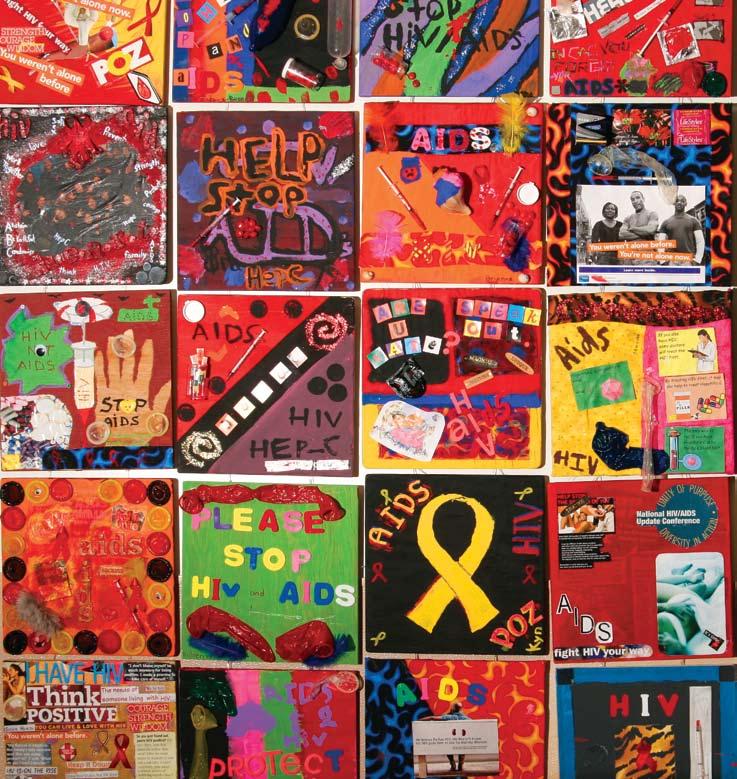
TUSAAYAKSAT SUMMER 2008 28
a“Listen up people –It ain’t if, it’s when, What will you do then?”
virus transmission. Due to diminished media attention and improvements in medication, many assume that h IV is no longer a serious threat. This is a false assumption. h IV is still a virus without a cure.
Modern treatment can save your life if started early. h IV attacks the human immune system, gradually stripping the body of its ability to defend itself. o nce the immune system has undergone serious degradation, HIV can reach its final stage, Acquired Immunodeficiency Syndrome (AIDS). From there on, cancers and infections may quickly populate the body, and render it defenceless. n ot everybody who has h IV will have a IDs . With the help of treatment, many people can continue having normal lives. It is important to get tested so medication can be administered as soon as possible.
for Lance hogue, a medical consultant living in Maryland usa , the program in Paulatuk was a challenge. It was his first time this far in the north, and there were a lot of unknown factors that cropped up. The program was being tried in a totally new environment. In phase one, the basics of h IV/a IDs and hepatitis C were taught to everybody in the school by the teachers. In phase two, Lance took over.
The bulk of the program was delivered through a student group called the health Education awareness response Team, h E arT, made up pf mostly older students at a ngik s chool. The h E arT team and Lance produced a colorful mural following the Global Peace Tiles initiative. They also filmed and edited an h IV awareness documentary. The documentary, featuring students as actors, was later shown to the community.
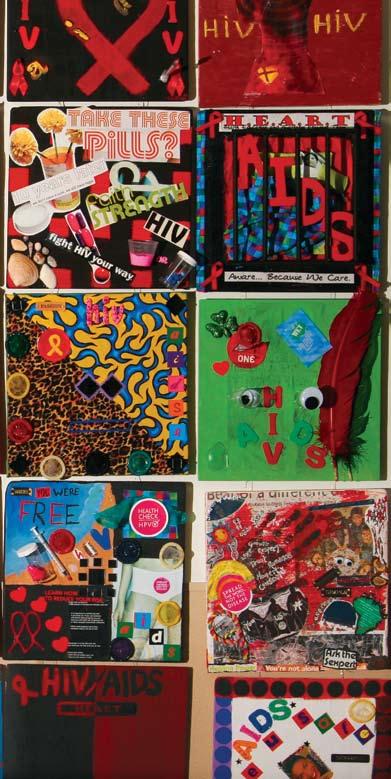
Lance Hogue’s first and foremost message to the students was the a BC rule: a bstinence, Be f aithful or Condomize. h IV is a sexually transmitted disease, and the surest way to get it is to practice sex without using a condom and with a partner whose health is unknown. a nother sure way to get it is through a used drug needle. There are several myths and false beliefs about h IV and how it spreads, which were unveiled during the program. you can’t get it from a toilet seat. you can’t get it from breathing or caughing.
Edward ruben, an elder in p aulatuk, responded after watching the youths’ video on h IV, saying that a IDs is a challenge to tackle as a people, just like his ancestors did with any other adversity. he said, “ young people need to be working as a team, like it used to be. We had to face our fears, big animals. This is another one of those things.”
29
It is not easy to discuss the use of condoms in a community like Paulatuk. There are a lot of taboos around sex. But the video, as well as the peace tiles mural, shows that the kids were actually mature, and ready to step outside of their comfort zone in order save their lives – and the lives of the people they love.
PHOTO: The HEART team and Lance put together this mural to express how they felt about the impact of AIDS.
In The News Tusaayaksani
Photo and words by Markus Siivola
From Bushcamp to Corporations: Aborginal Empowerment in Inuvik over 50 years
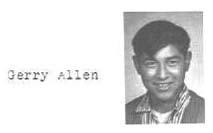

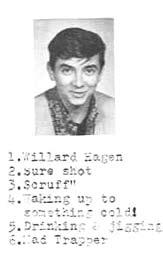


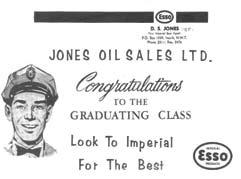

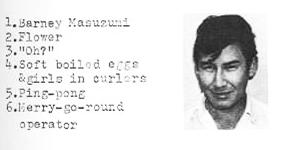
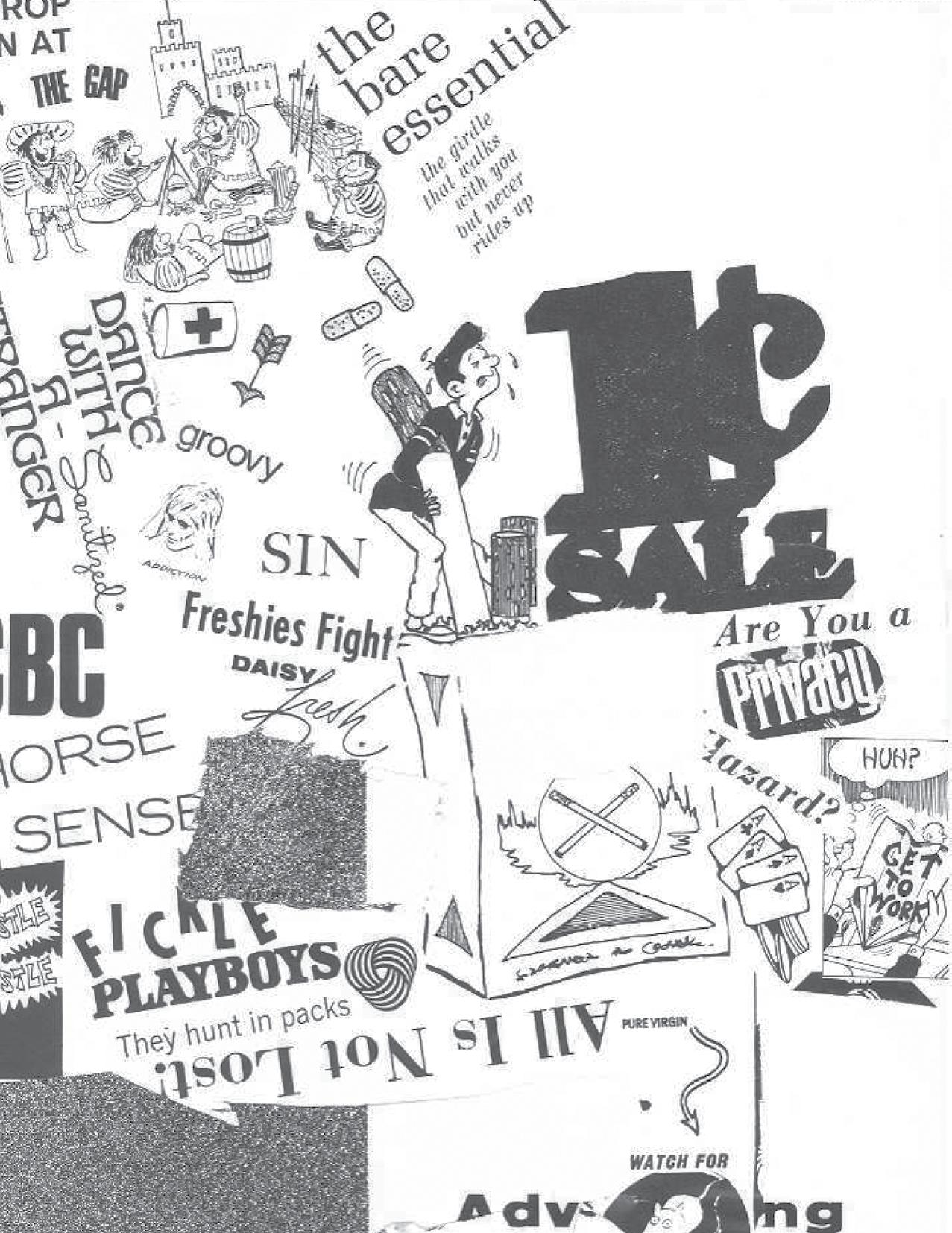
Inuvik’s 50th Homecoming Anniversary Special Feature A flavour of the day can be felt through this composite of yearbook pages from Inuvik’s schools in the sixties. Yearbook images courtesy of SAMS & SHSS
Building
Tommy Thrasher, Inuvialuit elder, took me on a winter’s foot tour around Inuvik. h is breath turned white as he pointed out some of the buildings he helped put up in this one-traffic-light town. “That’s the a nglican Church, I put up the steeple,” he said, “here’s sa M s chool, I helped build that too, and the Igloo Church, and look, there’s the post office. The third year I was here, this town was only as big as the post office,” he laughed.
The aboriginal construction workers would also set up tents along the river; as their population grew, the area became known as ‘ h appy Valley’ or ‘Tent Town.’

“We had to cut the bush to create trails, from Twin Lakes to the hospital,” said Colin. The area was overgrown with wild willow. “We made trails sixty feet wide, we cut it all the way to the airport. We didn’t have any powered chainsaws. n othing. We just used axes. I sharpened my axes all the time,” he laughed.
“Back then they thought pilings would last forever, but now with global warming…oh well, some of the buildings are gone now, I worked on these buildings and I’m still here.” Tommy has a mischievous smile, and I could see the pride that he felt to have been part of the construction of this town. “Back then it was called East Three, because it was at the third arm that branched off the Mackenzie r iver. I had just gotten married, we lived in a bush camp about 30 miles from Inuvik. I heard they were building a new town, and they were looking for construction trainees…”
That was 1954. Like many other aboriginal people who had moved to Inuvik for their first wage-earning jobs in the Mackenzie Delta, Tommy Thrasher’s life was forever changed. Before the new town was started, most a boriginal people still lived off the land and lived a nomadic but self-sufficient life. East Three was a “no man’s land.”
Colin too answered the same call to train as a carpenter. “When I was young, I trapped for my grandfather,” he said. “ h e raised me. I left home when I was eighteen, I never went back.” h is grandfather had always kept the money from selling the furs that Colin trapped, and Colin felt his first taste of independence by moving to East Three.
The first task at hand was to clear land to build on. There was nothing man-made in East Three, except for a few tents set up by the first construction team, made up of a small number of government officials and workers from the south.
When asked whether the building of Inuvik brought hope to the local people, Nellie Cournoyea said, “I don’t know if you would use the word 'hope'. It might have been the next big thing that was happening. It was the government’s proposition to move the town of Aklavik to another location because Aklavik was supposedly sinking. Well, we knew that a lot of people would never leave Aklavik and that it wasn’t necessarily sinking that badly.”
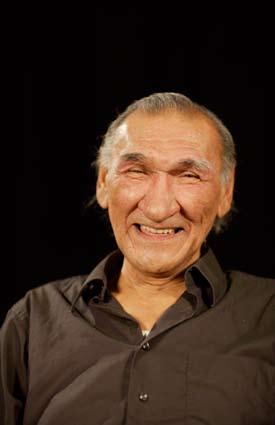
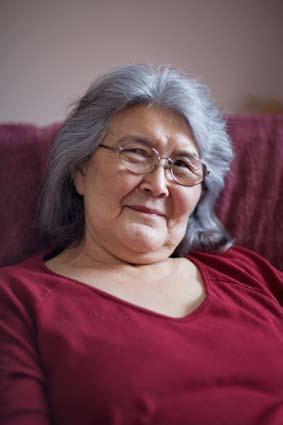
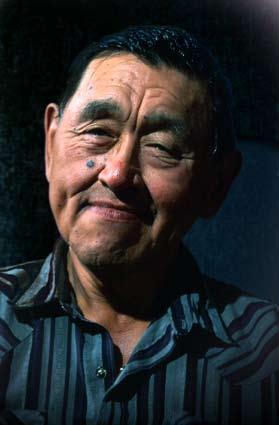
“Inuvik was planned within the Cold War era. The government was really looking for a place where they could build a very large airstrip. They were looking at different sites to find a place where they could find the gravel resources or foundation to put the airport.”
Employment became more important to aboriginal people as fur prices dropped. Colin a llen remembers continuing to return to the land with his family for all his holidays from work except one. h owever, while Colin made a good living as a carpenter in the beginning, he was told in 1972 that he needed certification as a journeyman to continue his work.
31
TUSAAYAKSAT SUMMER 2008
Colin Allen
Bertha Allen
ICRC Photo
Tommy Thrasher
“I had seven children and my wife,” he said, “I told them I am not going to Edmonton to take that journeymen training.” h e took up the job of janitor at the school then. This was a common experience for other aboriginal workers, who lost their jobs to qualified Southerners over time. n evertheless, Colin and Tommy are both nostalgic about the days of building Inuvik. “We built it, we were East Three,” said Tommy.
Settling
“ s ome of us came with our camping gear from muskrat camp,” said Bertha a llen, a Gwich’in elder who moved with her family to Inuvik around the same time as Colin. “ u sually we head over to a klavik, where there was a trading post, but this time, we moved all our gear to Inuvik. Employment went on after summer, then fall, and a lot of us never left.”
Bertha said the living conditions in the ‘tent town’ was challenging. About fifty families had put up tents, some as close as a foot apart. “We stayed in a small tent frame, about 10 by 12 feet for a couple of years, and then someone built a house and left their long tent frame. To me, that was like a real mansion, moving from a small tent to a longer tent frame!”
In fact, even as the town began to take shape over the first decade, with houses erected on both sides of the main Mackenzie Road, and the first school, hospital, office buildings and staff housing for government personnel were being built, living conditions for aboriginal people was not quite on par with that of southerners (personnel brought in to staff the rCM p, C p C, n C p C, Transport, n ational Defense, n ational h ealth and Welfare, Citizenship and Immigration departments.) a boriginal people eventually moved into 5-12s, the 512 square foot cabins that government employees long had access to, but still had to wait another few years before the utilidor would reach their homes.
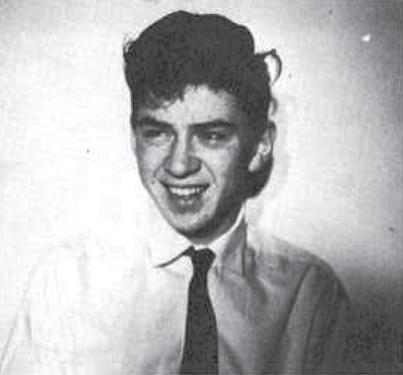
The utilidor was a unique two-way system meant to pipe sewage, fresh water and heating to homes in Inuvik. The pipes are housed in metal containers raised above ground so as to prevent melting the permafrost underground.
Bertha a llen had been one of the founding voices behind the first housing co-op in Inuvik. It was made up of both aboriginal people and people of other backgrounds. They ordered building materials from Edmonton to build their own housing. “We all helped assemble each other’s houses,” she said, “the men said, Bertha’s going to have the first choice of the house and lot that she wants, because she made the loudest noise.” Bertha would also become a champion of aboriginal rights, and native women’s rights, heading such as the n ative Women’s a ssociation, and other organizations that empower a boriginal n ortherners.
n ellie Cournoyea, Chair and CEo of the Inuvialuit regional Corporation said, “ you had the Canadian forces as well as government, and mainly Indian affairs thinking, so most of the housing was built for the government people who came into town and lived on the bases, they would have to be looked after the way they were in southern Canada.”
“a nd a boriginal people weren’t treated the same because it was presumed that it was their home and somehow they were going to make it by.”
of the many problems that this creates is the majority of the people coming in were Caucasian, and they appeared to be treated a lot better and with more respect than anyone else, and so you create a kind of

Resilience
In fact, the split became known as the ‘west side’ and the ‘east side’. “We were using chemical toilets,” Bertha a llen said. “The other part of town, the side with the hospital was lucky, they had flush toilets.”
“Even though we formed a co-op for housing, we didn’t have any utilidor on this side yet. Maybe 5, 10 years later, we finally had utilidor service, and one of the priests said to the little kids, come look here, look at what is going to happen to your poop! He flushed the new toilet, and it was so strange for the little kids to know that they don’t have to see their poop in the pot all the time,” she laughed.
h umour was a way to deal with adversity. a boriginal people in Inuvik began to agitate for their rights. The Indian Brotherhood was set up, and later, Inuvialuit and Gwich’in both pursued and won land claims. They also fought to preserve their culture and to build infrastructure for themselves.
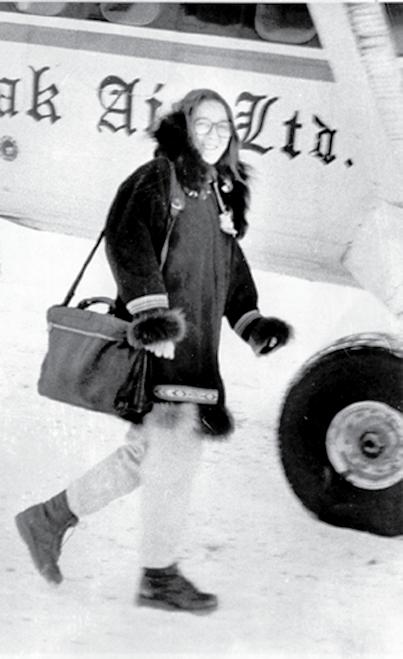
TUSAAYAKSAT SUMMER 2008 32
“One
racism. And people expressed what came out as dissatisfaction and anger. The only thing that was possible to do then was to find a mechanism to support the aboriginal people, as a society, because they weren’t part of that other society.”
Special Feature Nuitaniqsaq Quliaq
Historical photos left: Nellie Cournoyea (first female and first Aboriginal premier) and Noah Carpenter (first certified Inuvialuit doctor) are good examples of aboriginal empowerment.
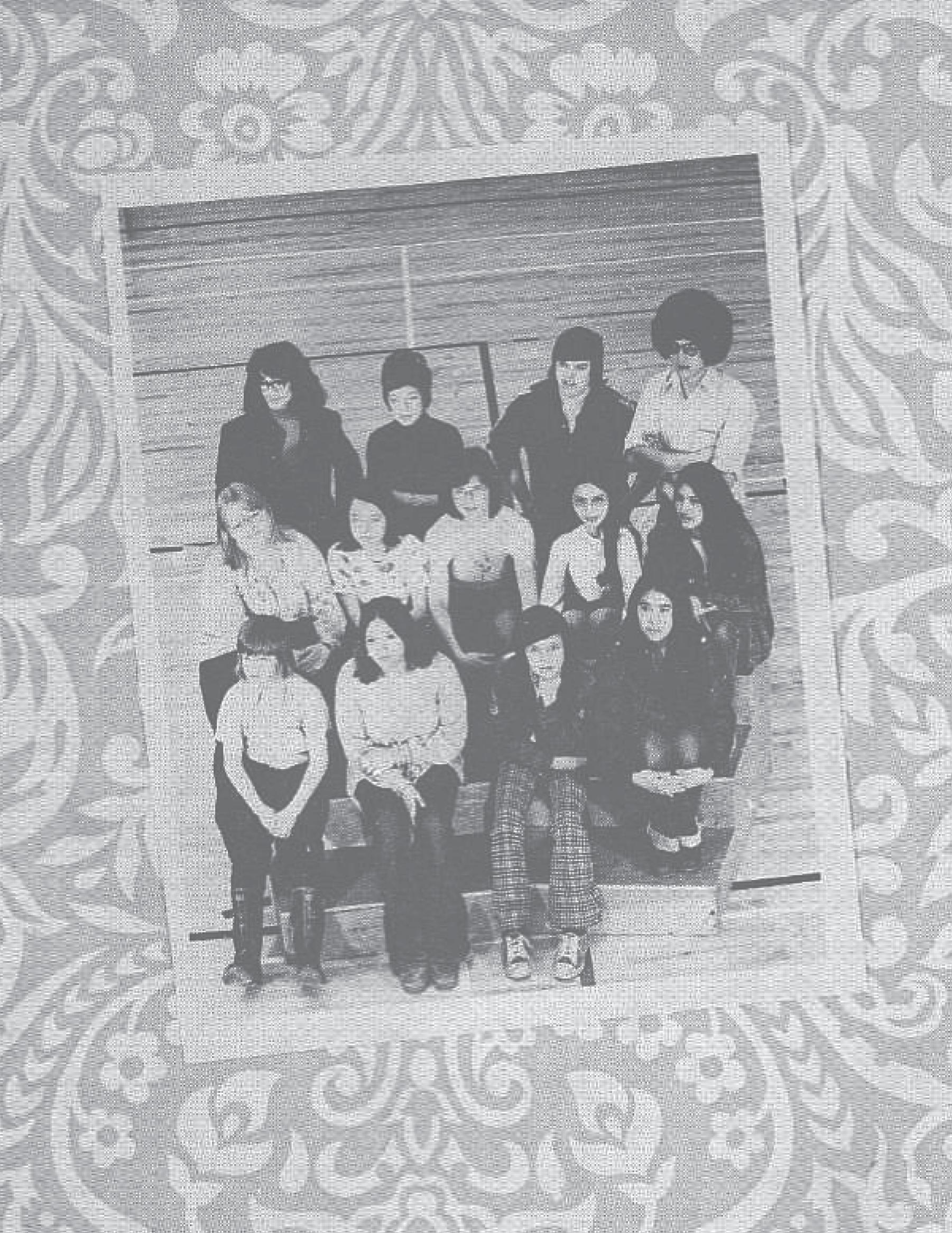
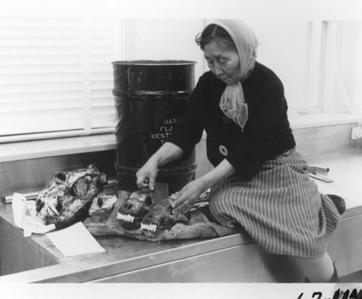
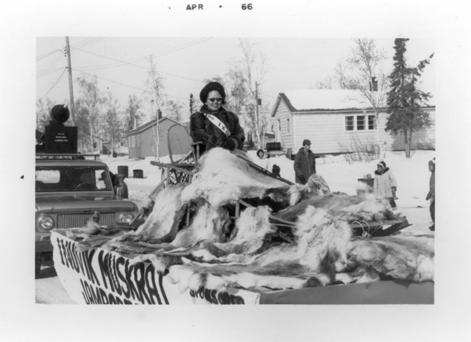
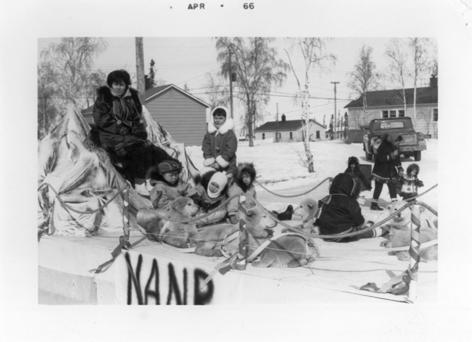
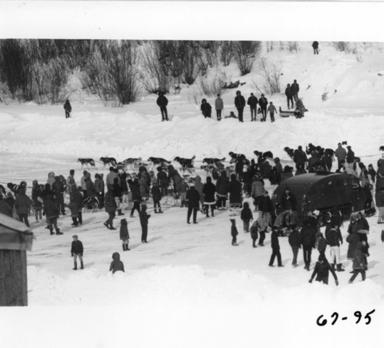
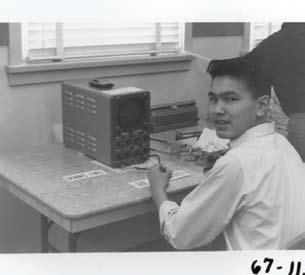
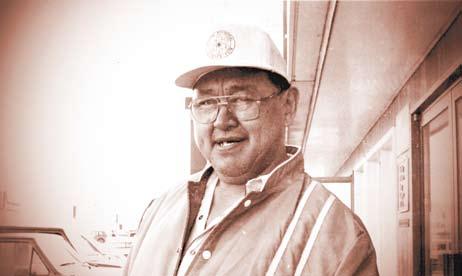
HAPPY 50th Anniversary!
Colin Allen as a young construction worker, standing on Mackenzie Road in the early days.
A lady working with bear skulls.
The first spring carnivals, now called jamborees.
Jamboree queen!
Parade time in the early 60s... All historical photos courtesy of ICRC
The research center.
Edward Lennie, a pioneer of bringing back a rctic s ports still remembers what it was like to hold practices in Ingamo h all. h e is proud of the n orthern Games Boys that he nurtured, who are in turn training the next cohort of athletes.
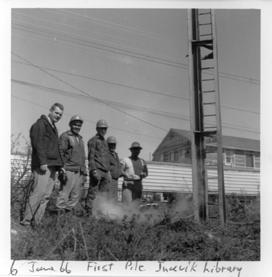
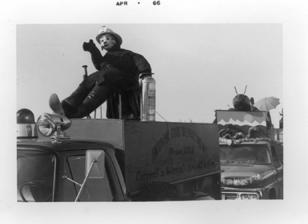
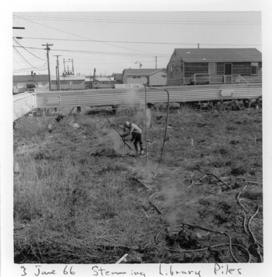
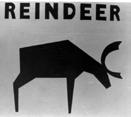
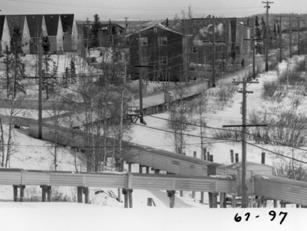
a boriginal people in Inuvik wanted to celebrate their gatherings in a sound structure that belonged to them, instead of an old hudson’s Bay building that was condemned. The ‘Ingamo’ in Ingamo h all friendship Center is a combination of the words ‘Indian’ and ‘Eskimo.’
Celebration
“We all live in harmony,” said Bertha. “We all belong to respective groups, but we’ve learned to live in harmony in small communities. Everybody works together. If there is going to be a big traditional dance, that’s just not for Inuvialuit or just for the Gwich’in, it’s for everybody. Everybody put their resources together, to put on a big celebration.”
n ellie is proud of the people like Edward Lennie, who brought back a rctic s ports by volunteering and teaching youth what he could about the traditions. “ n ow we’ve got major drum dance groups, and certainly arctic sports, which really began here, and are promoted all over the Arctic now. It takes people who are determined, who find a way to get it done,” she said.
s he looks back at the recent Inuvialuit history in the region. “They’ve evolved since the early whaling days in the 1900s, there has been a lot of changes in a short period of time. The religious factors, the DEW Line situation, the building of the town of Inuvik. Every ten years there was something for people to adjust to, to try to get the most out of the new opportunities.”
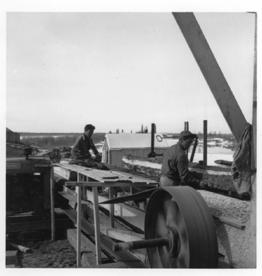
Inuvik also went through two oil and gas boom-and-busts in the seventies and eighties, and suffered economically when the Canadian forces base in Inuvik was closed down in 1985. More recently, there is anticipation that a boom will come in the form of the pipeline that might be built in the Mackenzie Valley. “Inuvik has never been able to define what kind of community it is, because we are always
anticipating some kind of economic base that we can rely on, over the long term,” she said. “Inuvik, as far as I can see, is thriving, wants to thrive, wants to be important and wants to take its place in society. There are a lot of people putting effort into it,” she said.
n ow celebrating its fiftieth anniversary, the town of Inuvik boasts a diverse and harmonious population of about 3,500 people, and continues to be the regional government and transportation hub of the Western a rctic. The Dempster h ighway (built in 1979), as well as n orthern-run air services, has brought tourists from all over the world to explore the unique culture and stunning nature in Inuvik and the surrounding area. The town is also host to some of the largest industry, arts, and entertainment events in the n orth. a boriginal people such as the Inuvialuit and Gwich’in have greater control over their assets and voices with the establishment and successes of their respective land claims corporations. s outherners who want to do business in the area now have to first consult its native owners. a rctic sovereignty also means that Inuvik is now strategically poised to be important once more.
“When Inuvik was first built, we would never see an aboriginal person who drove around in a truck, maybe a big gravel truck to build up the airport…and many years went by before you saw aboriginal people actually owning their own vehicles, and their own infrastructure. s o that’s good, the challenges, I think, have made a lot of people move forward,” smiled n ellie.
TUSAAYAKSAT SUMMER 2008 34
Special Feature Nuitaniqsaq Quliaq Inuvik in construction.
The infamous utilidor.
Nurses giving children medication.
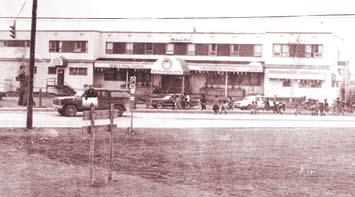
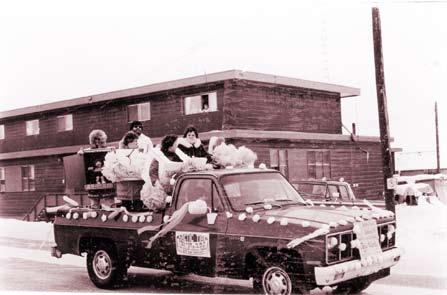
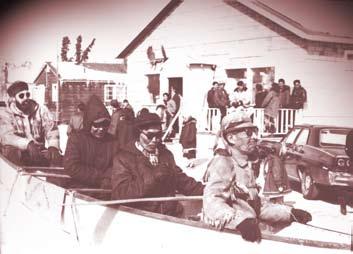
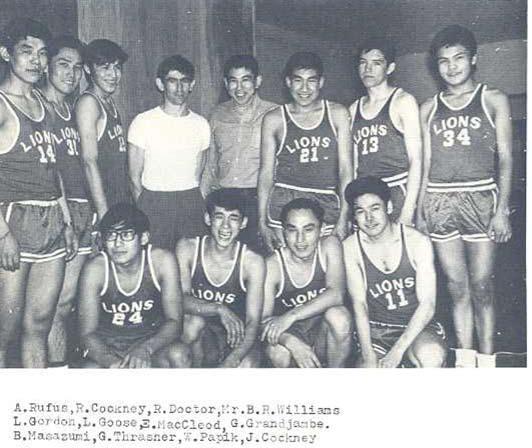
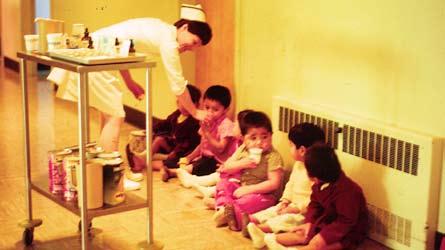
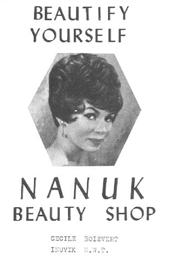
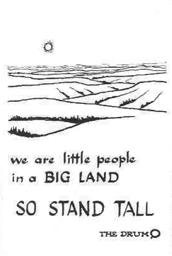
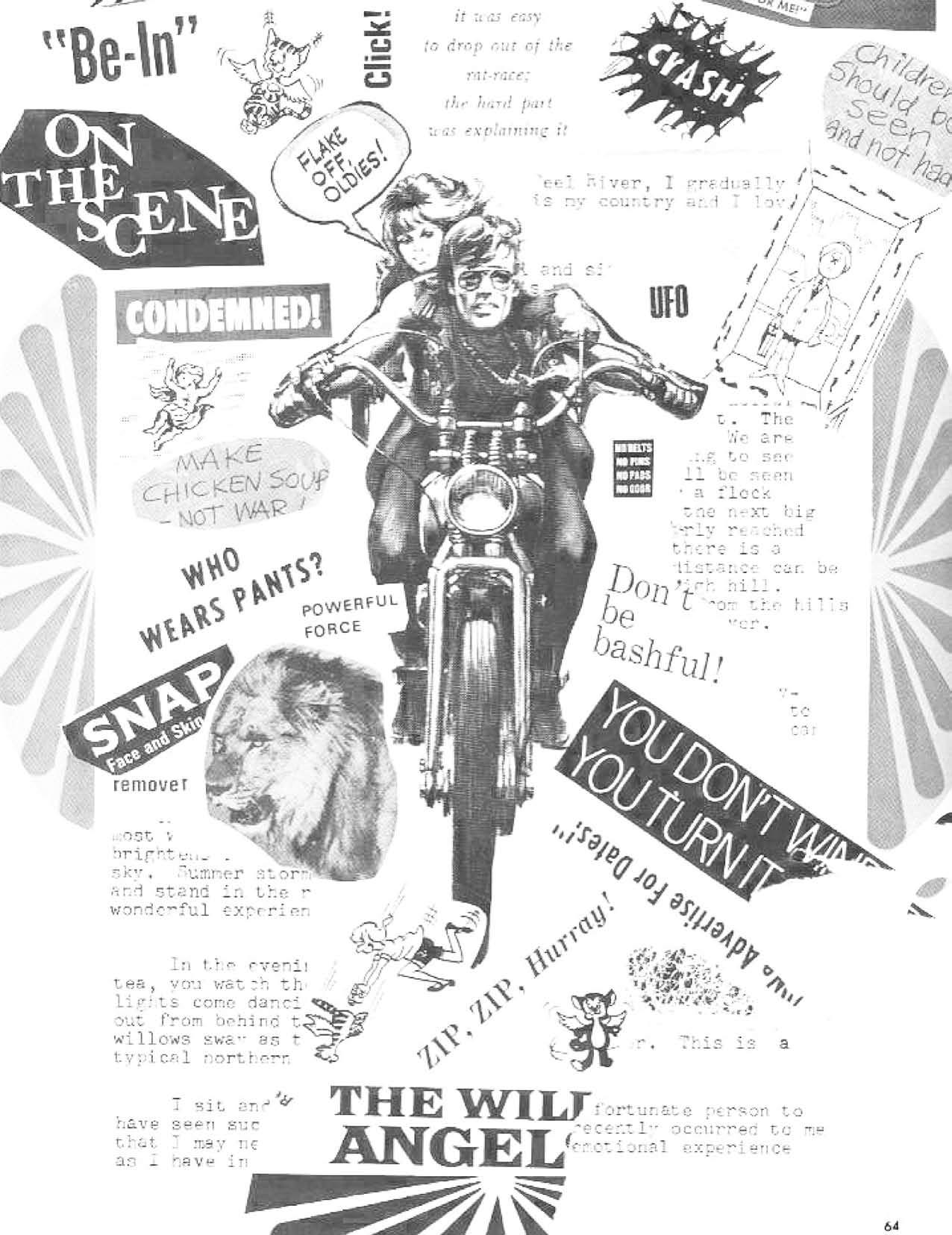 Paraders on a kayak pass by Slim Semmler’s store.
The LIONS basketball team
Trucks were decorated back then too!
The old Mackenzie Hotel.
Paraders on a kayak pass by Slim Semmler’s store.
The LIONS basketball team
Trucks were decorated back then too!
The old Mackenzie Hotel.
Grade Six students at Sir Alexander Mackenzie School sent us some very creative and awesome entries! We had a hard time choosing amongst all these great stories about your time out on the land. Here are the winners!
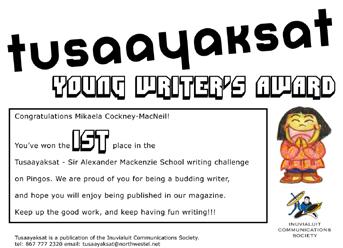
PINGOS
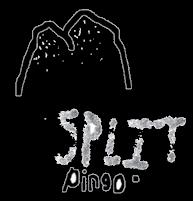
1st Mikaela Cockney-MacNeil
2nd Robyn Rinas
3rd Hailey Verbonac
4th Carina Saturino
TRAPPING
1st Robyn Rinas & Nicole Ellsworth
2nd Alison McDonald
3rd Hilary Charlie
We also used illustrations by Alison Burns
John Gruben
Darci Frost
Jozef Semmler
Matthew Skinner
Elena Joe
1st Pingos
By Mikaela Cockney-MacNeil
When you think ‘pingo’ and you don’t know what they are, you might think it’s a type of penguin. But really, it’s like a hill. The difference is, when a lake dries up or joins a river to go to the ocean, the moist ground left behind by the lake loses its moisture underground into the permafrost. There, it freezes and becomes an ‘ice core.’ After a few years a pingo will start to grow. As the ice core grows the pingo grows.
Pingos are like people. They have a lifespan. They start out very small and grow every year. But when they’re done growing, the ice core melts and shrinks.
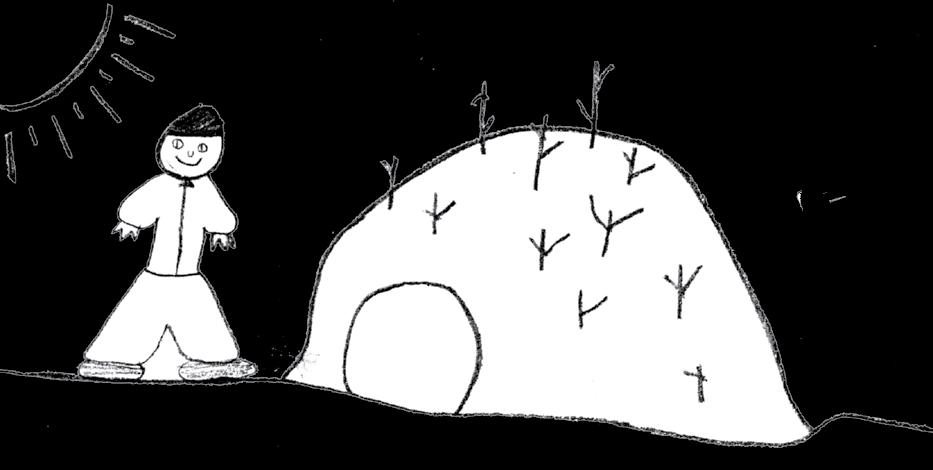
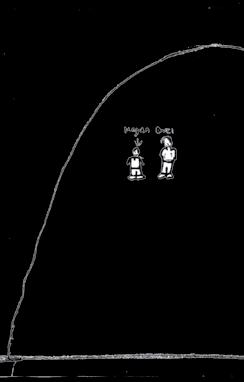
It is important not to drive skidoos, four wheelers, or anything like that because it takes pingos tens to hundreds of years to grow. They can only be found where there is permafrost. They can be found in Tuktoyaktuk, Alaska, Greenland and the Norweigen island of Spitsbergen, the Nertherlands, as well, near Zwaagwesteinde in the province of Fiesland, and also in the provinces of Drenthe and Groningen. The second largest pingo is in Tuktoyaktuk.
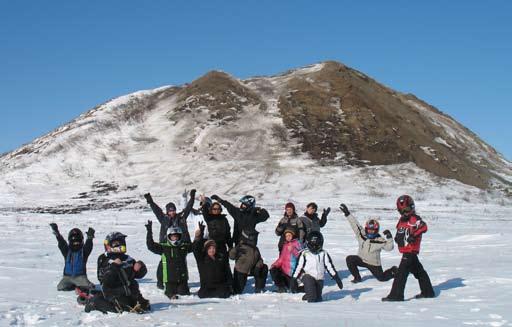
36
Grade Sixers from Sir Alexander Mackenzie School go with Parks Canada to learn about the Pingos!
2nd Pingo Pride
By Robyn Rinas
On April 9 th and 10 th, Mrs. Stringer’s and Mr. Murphy’s Grade Sixes went to Tuk to see the pingos.
The pingo process is, first the lake gets drained (naturally), and then the moist soil freezes. After that the permafrost pushes it together to form a big ball of ice. Last but not least the snow melts down and freezes with the ice underneath. So, the pingo grows larger.
In the summer, the snow on and around the pingo melts, and seeps through the pingo before freezing and turning into ice. This causes the pingo to grow.
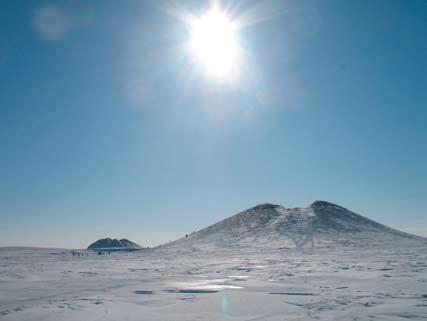
We should protect the pingos because they are not growing anymore. It’s not good when they are littered on or driven on. A way to protect our pingos is to not drive on them. Sleds, toboggans, and crazy carpets are ok. ATVs, skidoos, cars, trucks, dirt bikes, and things like that are damaging our pingos. Littering on the special unique hills that we call pingos is as bad as littering on the floor in your house.

The most dangerous way of killing our pingos is fires! Last summer, half of a pingo, almost the whole pingo, got burnt. People went to the pingo, built a fire, and when they were getting ready to leave, they thought the fire was out. But it wasn’t. The smoldering from under the fire didn’t get burnt out, and soon enough, when the wind came, it blew the fire right onto the pingo. Now that pingo can’t grow anymore, because of the fire.
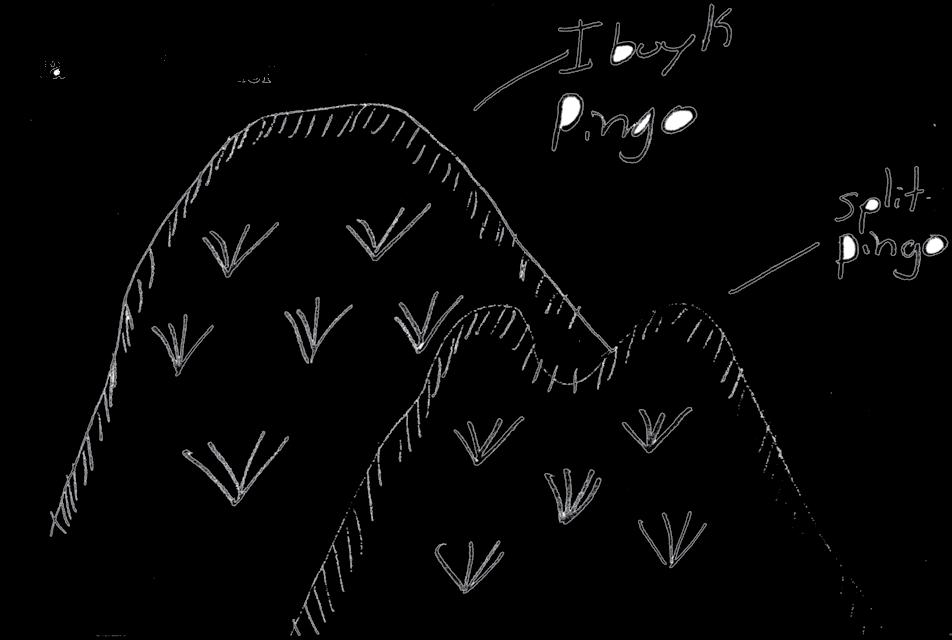
Pingos also die when permafrost becomes exposed and it slowly starts to melt. It stops from growing then.
3rd Pingos
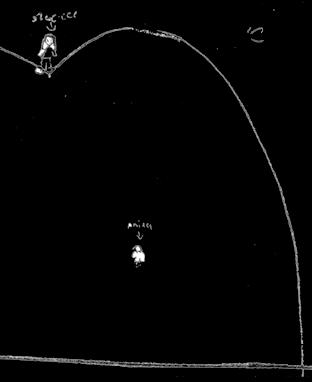 By Hailey Verbonac
By Hailey Verbonac
Pingos are made when a lake dries up and the moisture freezes and turns into ice. After a few years the ice builds up and turns into a small ice mound. The pingo gets bigger every year. The lifespan of a pingo is about 1,000 years, but that’s just a guess. No one is 100% sure. Pingos can be found in Tuktoyaktuk, Alaska, Spitsbergen, Holland, Zwaagwesteinde, Drenthe, and Siberia. Small pingos have rounded tops and bigger pingos have a cone-shaped top. Pingos are generally classified as hydrostatic (closed system) or hydraulic (open system.) The biggest pingo in the world is in Siberia and the second biggest is in Tuktoyaktuk. It’s really important to protect the pingos because they are vital to the environment, they might die if you skidoo or bike on them, but you’re welcome to walk on them.
Youth Speak Up Nutaqat Uqaqtut
Photos courtesy of Melinda Gillis
1st The SAMS Nunami Camp
by Robyn Rinas & Nicole Ellsworth
On April 17th and 18th, Mrs. Stringer’s Grade Sixes, along with Mr. Murphy’s Grade Sixes got the opportunity to go out to SAMS Nunami Camp, for two days and one night. We learned how to trap rabbits with snares, and we also learned how to trap muskrats. Here’s how to set a trap; 1st you get your trap. 2nd open the dog, which will be found on the right hand side. 3rd pull down on the spring, which is located at the back, this will separate the jaws. 4th you put your trap where your hoping to catch something. 5th go back to check your trap in about a day or two, you may have been lucky and caught something.
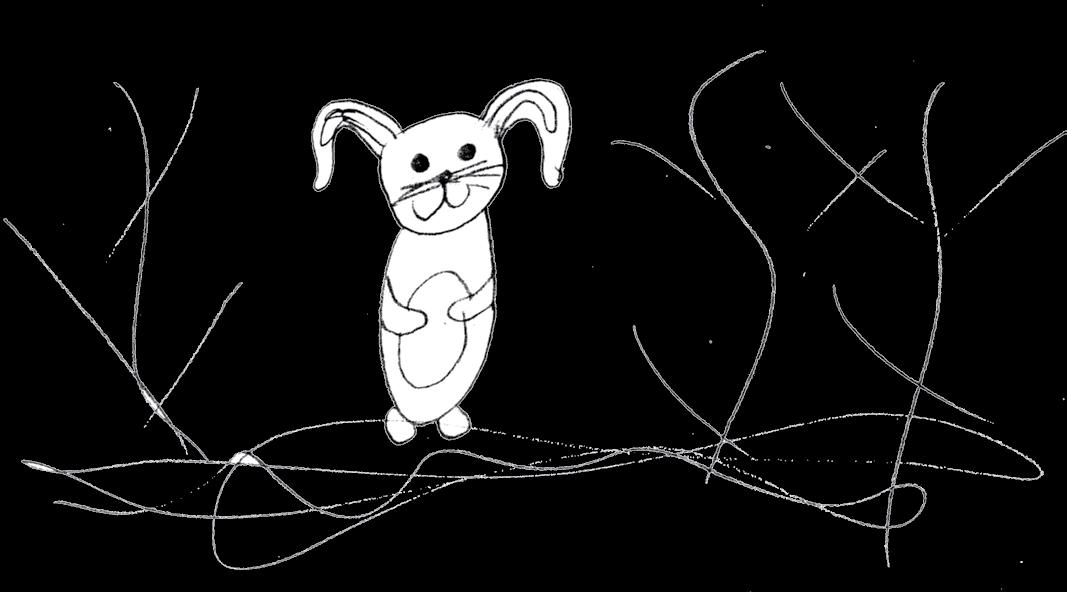
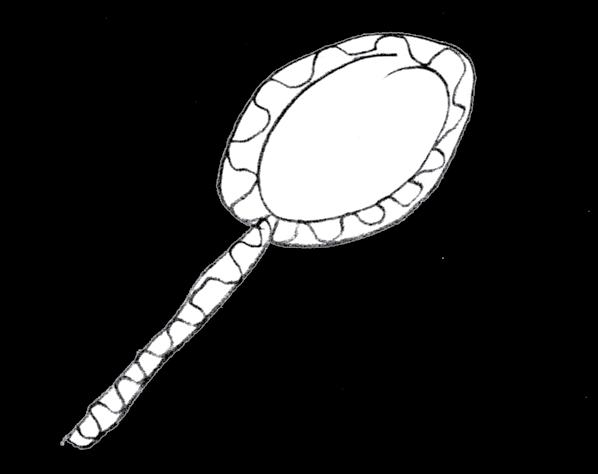
We also learned how to make a fire . Here’s how; 1st get shelter so the wind doesn’t blow out your fire. 2nd get dry sticks, or bark off a tree. 3rd you’ll need some matches. 4th pile up your sticks, and your bark if you got any. 5th to start your fire, get one match, light it, and then place it in between the sticks. If the match burns out, use another match.
We even learned how to make a Quincy. 1st you pile up the biggest pile of snow that you can. 2nd let the snow harden for about an hour or two. 3rd then go and get some willows about 20 cm long, 4th stick the willows on top of the Quincy. 5th dig the snow out to just the tip of the willows, if you go any further up, the Quincy will collapse. There you go your very own Quincy! That is what we did on the land!
2nd Trapping in the North
by Alison McDonald
Trapping was a very big tradition in the North and other parts of the world. It’s very important to have programs to teach other about trapping, survival skills and how to respect the land by only taking what we need. We learned how to catch food with traps and how to build a fire when out on the land. We saw how to set a 1 1/2 spring, 3 spring and watched how strong a conibear trap can really be when set. To build a rabbit snare, we took a piece of wire and wrapped it around our head twice. We twisted the end and put the other end of the wire in a loop to make a snare. We set in between tree branches so the rabbit could not go around the branches.
To build a fire we dug out a place in the snow to start the fire, we gathered dried twigs from a pine tree with green and black stuff on it that looked like moss on the dried twigs. We found a thick stick that could stand up to put over the fire to boil water. We filled an old coffee can with snow and put it above the fire with a stick. We lighted the fire but it didn’t start as quick as we wanted it to but it soon started. I thought it was great to learn about trapping on the land.
TUSAAYAKSAT 38
3rd The SAMS Nunami
Camp

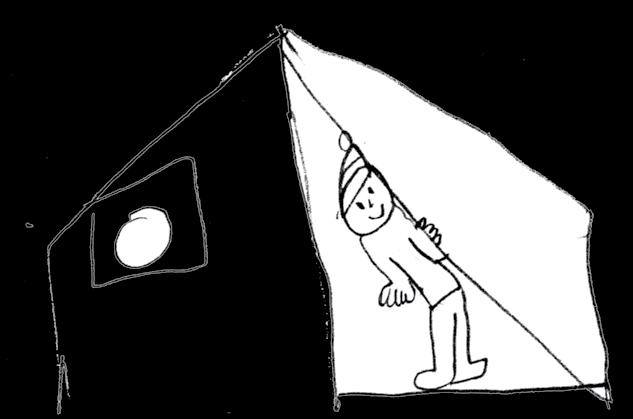 by Hilary Charlie
by Hilary Charlie
On April the 14th our class and Mr. Latour’s class had the opportunity to go to the SAMS NUNAMI CAMP. When we got there we met a man named Archie. While we were there we went to the Mackenzie River Main channel. Then Archie showed us how to set the 1, 1 1/2, 2, 3 spring traps, some of us had the chance to set some spring traps and then he talked about the conibear trap. Then he talked about how the conibear trap is a quick kill trap and and when the animal is trapped in the spring traps it sometimes chews off its own paw or leg. But Environment Natural Resources wants more people to use the conibear trap because it’s a quick kill trap and the animals don’t suffer. A really fun part of the camping trip was when we went out looking for muskrat push ups, also we got to make our own snares and set them. Then we got to boil water on our own. While I was on this trip they told us that we always have to respect the environment. I learned many new things on this trip and ways to set different traps. I am glad I had the chance to go on this trip to the SAMS NUNAMI CAMP it was so much fun.

39
Youth Speak Up Nutaqat Uqaqtut
Tom Mcleod’s First Book
Tom McLeod of a klavik had what he calls a “once in a lifetime” experience. h e was in Calgary and yellowknife this May for his first book launch. “It’s cool to have a book made about our travels” he said, “a nd I am thirteen.” Tom, who was known even as a very young boy to tell stories on CBC radio, is the author of The Delta is My Home. In his book, Tom takes us right to his home, showing us through photographs and anecdotes the life that a young boy leads in the Mackenzie delta.
“I used to be a high school teacher,” said Mindy, “and kids would ask me why are there no good books about us? I wanted to help people tell their stories, and for it to look stunning.” o ver four years, Mindy sourced out sponsors from local Indian bands, Inuit organizations and government. “It’s a huge partnership between organizations,” she said. The logistics of traveling all over the n orth to work with the storytellers is often complicated.
Mindy and Tessa Machintosh (photographer) had intended to go to Aklavik in order to work with Ian McLeod, Tom’s father, but the flood that happened in a klavik then meant that Ian was too busy helping people in town to work on writing. “That’s when we discovered that Tom was the storyteller of the family,” said Mindy.
Tom and his sister ocean took Mindy and Tessa all over a klavik. They would hunt muskrats from midnight till six in the morning (that is when the muskrats are most active) and then work in the day on putting words to paper. “Tom wrote his book right there on the floor, his voice carries through the entire story,” said Mindy.
Tom said he might write another book someday. “I’ve so much resource material to draw from,” he said. “I still tell stories on radio once in a while.” The grade 8 student had advanced onto doing grade 9 English in school.
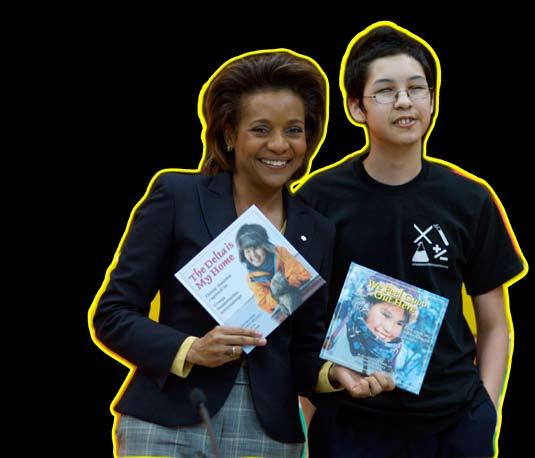
In the book, Tom and his family go on hunting trips and celebrate Tom’s unique background of being both Inuvialuit and Gwich’in. s idebars provide information about the history of a klavik, and the animals that are important to its people. Tom’s book is the first in a series of ten books, where Mindy Willett, editor and coordinator collaborates with aboriginal storytellers from across n WT. The other book that has been published so far is about the Gwich’in culture, Julie- a nn a ndre’s We Feel Good Out Here
o ther books in the series include a book on beluga whaling in Tuktoyaktuk, and another from u lukhaktok. Tom’s book can be found at book stores in Inuvik, as well as at the local and school library. Tom will also be hosting a creative workshop with youth at the Great n orthern a rts festival in Inuvik on the 13th of July.
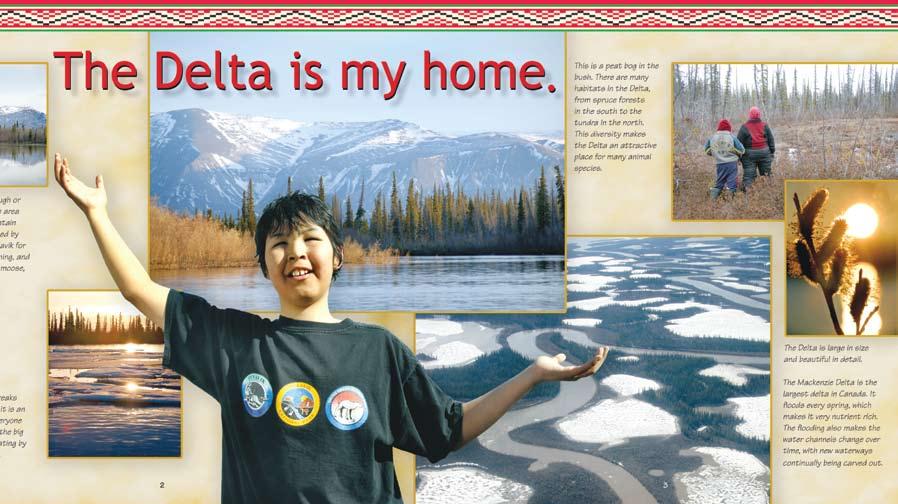
TUSAAYAKSAT SUMMER 2008 40
The book begins with a flood in Aklavik, where local people demonstrate the town’s motto of “Never Say Die,” entertaining visitors with doughnuts and trips on the land. Tom’s father Ian is a renewable resource officer, and it is clear that he has taught Tom to respect the land.
Youth Speak Up Nutaqat Uqaqtut
Tom presented the Governor General with his newly published book at the Youth Town Hall in Inuvik. Behind them is a spread from his book.
Arctic Rocker DEBUTS ALBUM

Leanne Goose, born in Inuvik, raised in a klavik and the s ahtu, has worked hard to establish herself as a renowned “a rctic rocker.” h er music, a blend of rock, country, and blues, is ever changing and evolving, but continues to reflect a life lived in the n orth. h er newly released album, “a nywhere” was created in the n orthwest Territories, and recorded in a small cabin in the woods of Whitehorse. “The music has to reflect the winter weather, the vast extremes, at one moment soft and sunny, and the next cold and hard and a pain in the ass when you step out the door.” h er new album, Leanne says, is exactly that - an effort to capture a rctic rock.
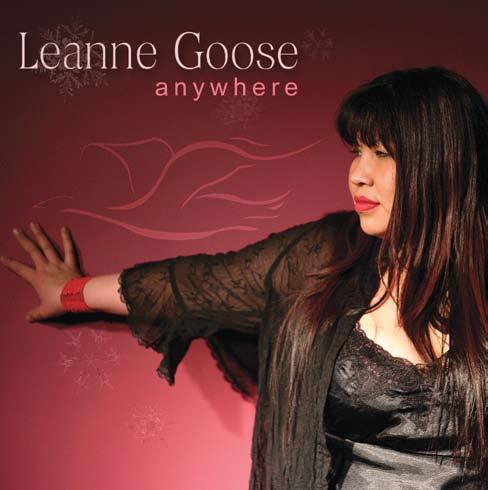
With a grant from the Canadian Council of the a rts, Leanne has designed a personal program to allow her to train with other experienced musicians, simultaneously studying classical music theory, piano, and the guitar in an environment of mentorship and collaboration. “ k nowledge of a livelihood built on the music industry can not be learned in a book. I want longevity in my career.” This longevity, Leanne says, will come from developing her stage presence, fostering her creative spirit, and never ceasing to develop as an artist. Learning to read and write music has helped her focus her song writing, and facilitate an assessment of her needs as a musician. “Most important,” Leanne says, “is to pay attention to your body and who you are as a creative person. s o many artists don’t do this.” Leanne says that being a mother is primary. With two sons of her own, Leanne’s motivation is not only for herself. “I want my children to see that it is possible to take life’s passion and make it whatever you want to make it.”
In fact, teaching seems to be Leanne’s latest passion. “Children who play music have better grades, and more confidence. I feel strongly about the teaching element, to foster music and build the creative spirit. We have tons of talent in this community, some just need a little push, others some hints and some can do it all on their own, but I want to be part of guiding and shaping that process.” Leanne’s music has encouraged her to learn to let go of issues with self-confidence, and given her a voice.
Words by Lindsay Trevelyan
‘Inuvialuit,’ ‘Mackenzie Delta,’ ‘Mad Trapper,’ people stop what they are doing, and they look, and listen.” This is the power of music, and something Leanne says is important to offer back to her home.
for now Leanne is going to keep learning and studying with her mentorship program. s he encourages her audience to keep an eye on the website www.leannegoose.com, as there will be new music soon. s he and song-writer and guitarist Laurie Mac n abb are gearing up for a new album. “I am excited, this is going to be quite a ride.”
41
“ Once I tell my audience where I am from instantly the ice is cut and people are locked in, as soon as you say ‘Arctic,’ ‘Inuvik,’
In The News Tusaayaksani
Leanne’s debut album Anywhere has received much acclaim since its release this spring.
Photos courtesy of Leanne Goose
Motherhood as an Inuk (in
Tusaayaksat asks Emma Dick and Sarah Tingmiak to share what it was like to be a mother in the Mackenzie Delta in the 1950s. Emma and Sarah both had 12 children each, while Sarah also adopted a child. Below is an edited transcript of our conversation.
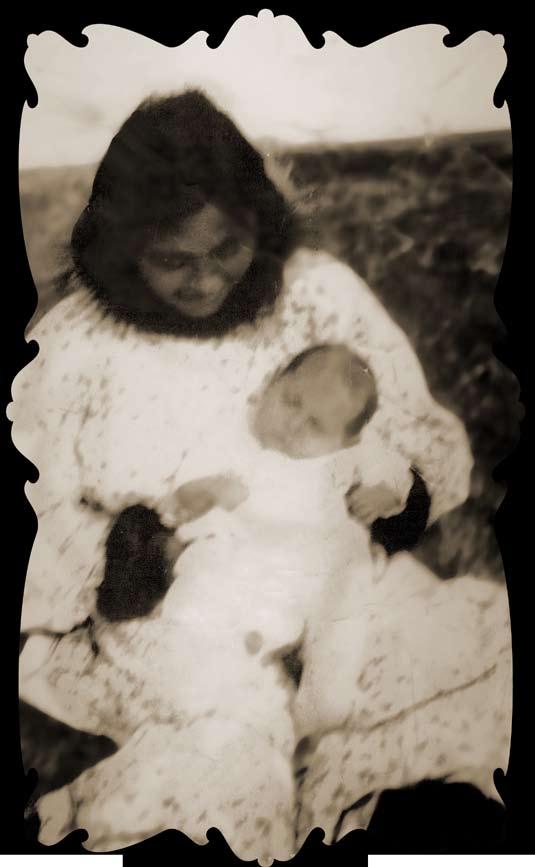
How old were you when you got married?
Sarah: I was 18.
Emma: I got married in ‘42.
What was it like to be a young women then?
Emma: Our grandmothers used to be really strict. You can’t go around with anybody until you get married. Our people were already religious before we were even born. We all got baptized in Aklavik and confirmed in schools and all that. I was seventeen years old and married when I had my first baby.
d id you get to choose whom you married?
Emma: I chose myself.
Sarah: My dad told me: you are going to get married. I didn’t like it.
Emma: Tell her about your first boyfriend.
Sarah: Yeah, my mom didn’t want him, he couldn’t trap.
d id you fall in love with your husband later?
Sarah: Yes, he’s a good guy. A month after I got married, I had a baby. Really fast. I had 12 kids, 11 with my husband (laughs). I was eighteen.
d id your husband like the first kid?
Sarah: He liked him better than all his kids. He’s good that way. My mum and dad took my first kid when she was about six.
Emma: There was not much shacking up in the olden days.
What was the average age then, when girls were getting pregnant?
Emma: 15, 16 years old…well, some of them were young, but it wasn’t all the same.
How did you know when you were pregnant back then? d id you ever use birth control?
Emma: We didn’t know about things like that. We didn’t even have doctors until the 60s, 70s. Today people can have only
TUSAAYAKSAT SUMMER 2008 42
the 1950s)
Sarah Tingmiak with her child Esther Joe.
Photo courtesy of Esther Joe.
one child, and then tie up their wombs. I knew one girl, in the early 60s, who took birth control pills. But I didn’t believe in it then. I had a baby every two years. And then when we got older it just stopped.
How did it feel each time you were pregnant again?
Emma: Good. You didn’t feel that you were losing your freedom?
Emma: (laughs) We need lots of people in this world. When Inuvialuit have babies, the elders used to be so happy for you.
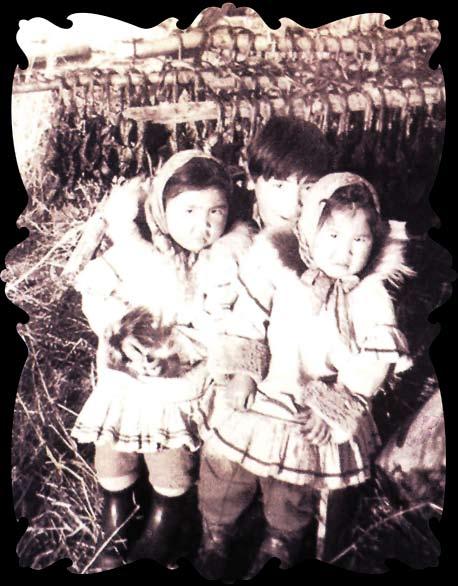
What was giving birth like back then?
Emma: We had midwives all over. Some of these ladies are very good. They go anywhere, to bush camps, whaling camps, summer camps. The first baby was really hard. I was in labor for two days I think. The midwife told me, the first one is very hard. But the second one is going to be better, less hard than the first, and the tenth baby will be just like nothing.
I delivered one baby in my life: Esther Joe, Effie Roger’s daughter. I was so scared. We delivered her at Hershel Island.
November 21, 1963, I think. Sadie Simon was the baby sitter, she took all the kids. When a woman’s having her pain, they don’t let the kids be around the house.
My goodness sake! A baby. We didn’t know she was pregnant. We didn’t know what to do. She said the water had already come last night. No water, gee, what are we gonna do.
Fix her up. We better ask the Lord to help us deliver that baby. We don’t want the baby to die. We said a prayer. We were young, too. I was around 39 or 40, still young. We had a good prayer. We asked the lord to protect us and help us to deliver that baby. So the mother wouldn’t die. We were so scared she might die.
She was in labour and finally the baby came. It was just like a mottled baby. Like the color grey. And I told Effie, I cut, I took the cord, tied it, and took the scissors and cut it.
I told Effie to grab a diaper, she was so scared. The afterbirth is gonna come, I told her, you take this, I’ll take the baby. As soon as the after birth comes, the mother is ok. I took the hot baby blanket we had on the stove and wrapped up the shivering baby. We put it in a box beside a furnace stove, where the warmth is. She’s alive today, and she is married! She always thanks me for delivering her.
Sarah: Me too, we delivered a baby in Sachs Harbor. I was scared, too.
Are there any rituals or medicine that people did back then?
Sarah: We didn’t have anything.
Emma: Only scissors, and you need thread, to tie it up. And you clean the baby’s nostrils and mouth out with a ptarmigan feather, to make sure there’s nothing like throw up in there, that it’s clean.
Emma: There are lots of doctors now, but when we went to the hospital then, we just had check ups once in a while when we are pregnant. We spent time in Aklavik, to wait for our babies to be born.
Sarah: When we had babies in the hospital then, they kept us for ten days. Now they leave the hospital in just a few days.
What happens after giving birth?
Emma: We didn’t have maternity leave (laughs.)
So life goes back to normal?
Emma: In a couple of days. We had the cooking to do, and the washing. In the olden days we had to wash our diapers with washboards. In 1950 I had my first washing machine. I was so proud of it. We even took it to bush camp with us.
e lder Story Innaum Quliaqtuanga
Emma and Sarah had to look after children, as well as skin and dry all the muskrats (behind the children) their husbands caught. (L-R) Sandra Ipana, Buck and Carol Dick.
Photo courtesy of Emma Dick
Sarah: After we skinned rats that our husbands caught we would start to wash diapers. There was always lots of work long ago. We were always busy, busy, busy until we go to sleep.
d id the men help?
Sarah: They are hunters.
Emma: They worked hard. All winter and spring. Muskrat season lasts until June 15th . They hunt all night, and come home towards morning.
Emma: It was a good living in the early days.
Sarah: Everything was slow.
Emma: Everything was so smooth. We would live on the land and then go to Aklavik for a holiday. When we came back home, we would work again.
Sarah: We had games, big celebrations at Easter, New Year, Christmas, all the kids got nice clothes, everybody got nice parkas, nice mukluks, nice mitts, and today— it’s not the same. We used to really get busy, no matter how many children you had you made good clothes for them. And when you go to Aklavik, you buy shirts, underwear, pants and socks for the kids. We were happy that our husbands let us buy all that stuff. Women didn’t know about money then.
Emma: In the earlier days we didn’t know about family allowance. We didn’t know about rations. Our husbands had to trap lynx, muskrats, beavers, and martens to make money off the land. When we got to Inuvik, we started working and finding out about money when we got paycheques.
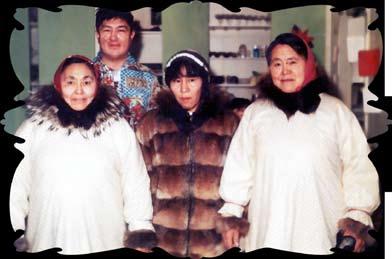
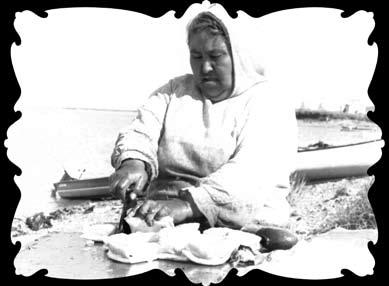
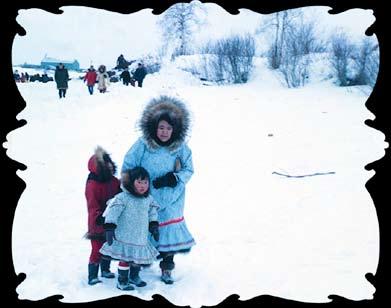
How did you take care of so many children?
Sarah: Our older kids start helping us.
Emma: We had a playpen for the babies. And swings, but we didn’t have strollers. We breastfed, but later there was ‘true
milk.’ It came in a big can and we mixed it. It was good milk. When the kids had bad colds we had babies’ medicine. We went to the doctor. Everytime there is a vaccine, they announced it on the radio, bring your child to get the shot. We bring them to town every time they have to get shot
d id you have time for fun?
Emma: We used to pack our babies around to dances. People helped each other, they didn’t ask for money. They were just willing to babysit. Today, you’ve got to pay the babysitter. Back then, we didn’t know about bingos, we didn’t know about gambling, and things like that.
d o you think people think differently about having babies now?
Sarah: A lot of young people are having babies now.
Emma: Lots of common law these days, lots of boyfriends.
Some young people have to give up their education because they are pregnant. What do you think?
Emma: Well, I think getting your education is more important than having babies. Go to school first so you can get a good job. To have a good job today, you’ve to have upgrading and go to college. Some young people have their babies first and then they go back to school, to university. I think it’s nice that they give them a chance like that. That’s nice. It’s not like back in old days when they didn’t have things like birth control, and nowadays you’ve a choice there. In our days, we didn’t have the choice. Now if you don’t want kids, you don’t have to have kids. You want kids, have kids. That’s your choice.
d o you wish you were born later so you could have had all this choice?
Emma: No, no, I was born in the 1920s and I am happy about it.
TUSAAYAKSAT SUMMER 2008 44
Emma Dick takes her children Velma and Sheila to a community gathering.
Hester Cockney, Emma’s aunt, cutting up maktak (whale blubber.)
Photos courtesy of Emma Dick & ICRC
With relatives: (L-R) Sarah, Elijah Allen, Allen Hunter and Emma.
Aakaunikmik maani uummarmi (1950ni)
Qanutun ukiuqaqpit uninikavik?
Sarah: 18tun ukiuniklunga.
Emma: 1942tuumi katitiqtuanga.
Qanuqituaaq taimani?




Emma: Taataavut pilukataurarnaitchuat. Tautchikuaqatiqarnaitchuat katitiqhaarnatin. Inuit ingilaraan. Ukpinganiqhuat anigaluaqtinata. Paaptaiqhimarugut iluqata. Aklarvingmi kamiuniqtulahivlutalu iliharvingmi. 17tun ukiuniklunga uiniktuanga nutarauranikama.
Ilipkuaqpit kihumik uiqaqtilaakraqnik?
Emma: Uvamnik uikraqtaaqtuanga.
Sarah: Aapangma uirakangni: uigihigin taamna huinagigaluariga.
Emma: Uqalautuung, angutautiqhaarnik.
Sarah: Aakangma huinagikanga naniriaqtulainman. Kinguvatigun tuvaaqatin piqpagiagutiviung?
Sarah: Ii, nakurniqraq angun. Tatqiqhiun naanman, nutarauraqaqtuanga. Qilaminiaq, 12nik, nutaraqaqtunga ilnik. Tuvaaqatimnin 11nik (iglaqtuq). 18tun ukiuqhaqlunga, Tuvaaqativik nakuarivaung nutarauraqhaan?
Sarah: Ii piqpagilhaakanga nutaqhaminin, nakuuruaq taitnaqhuni. Angayuqhaangma, 6 tun ukiuningman pikangak.
Emma: Hiniqhatigipialaitchut taimani.
Qanutun ukiunikaming, nararihaaruvat arnaiyaat?
Emma: 15-16 tunluuni ilangitkii, nutauruat, taitnalhainallaitchut pangmatun inngitchuq
Qanuq narihaaqtilaqhi ilitchuriraqpihiung ? Narihaarnailanik maratchinik uuktuaqhimavit.
Emma: Nalurugut taitnahinik .taimanikii taaktiitchugut uva taatinipaluktugut 1970ni1960miluuniin.Pangma ingmiktigun ihumamiktigun irniuliqhut nutaqhiyaiyalahivluting .Ilihimagiga arnaiaaq nutaqhiyailaqtuqtuaq marahiqtuqhuni.1960ni kiaq.Ukpiringihatka aglaan uvanga.Nutaqhiuqhimarunga malruk ukiungnik akunaliklugit nutaqatka.Taima ahiin nutaqilailaklunga irnillailaktungnga.Qanuq ihumagiviung taimani.
Emma: Nakuuruq. Itna ihumalaitpit tavra ituaqtualiqhirunga aimaugaliqhirunga. Niuqsik (igalqtuq) Inugiaquhuugivut inuit maan nunaptingni. Inuvialuit quyatchaguuruat nutaqhimata arnat. Utuqanaat quyahukpauraruuruat.
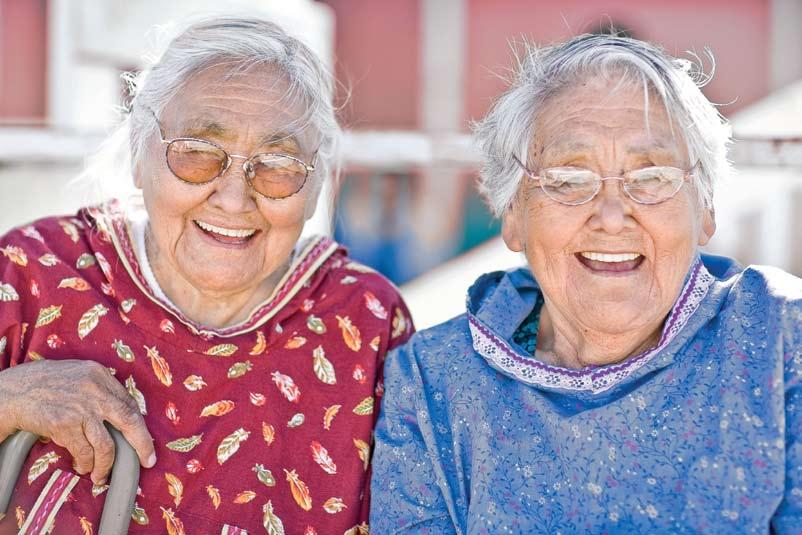
45
Tuhaarakrat apiqrurarait Emma Dick, Sarah Tingmiarlu aakaunikmik maani uummarmi 1950ni. Emma, Sarahlu 12nik nutaraqalaaniqhuak. Sarah aglaan tiguaqhuni atauhimik. Ataani quliaqtuangak.
e lder Story Innaum Quliaqtuanga
Emma Dick and Sarah Tingmiak at Aboriginal Day celebrations.
Qanuqittuaq taimani irniruni?
Emma: Irnipkairiqaqtuaguut Taimani. Ilangit-arnat ilihimapiaqtuat iripkainimik. Humunliqaaqtua piaqtuat, Aulaaqturvingnun, qilalukiavingnun, upinaraqhivingnun. Hivulirmi iriniruni hapirnaqtuq malrungnikiaq irnihuktunga. Tuglimik iriniguvik nakuuhiruq hapirnarniangitchuq hivuliqtun, Qulitun irniuruvik huitchurigiagutihigin. Niuqsik, Atauhiaqlugu irnipkairunga inuuguraqhama, Esther Joe, Elizabeth Aviuganam panianik, Iqigaluaqtunga, irnipkakaqput Qikiqtarrungmi. Naniriaqtungnaqhiman 21, 1963mi Sadie Simon luuni nuttaqhiqiruaq nuttaqhat aniiqhuarutikangi, Arnaq irnihulirman nutaqhat tamaanitilaitkait iglum iluani.
Arraa! Piipiuraq. Naluniqhugut narihaaqtilaanganik, nalupqihuaqhirugut, imriqhianingniqhuaq unuami.
Qanuqivita tavra, imainmiruaq.Hanaiyarikput
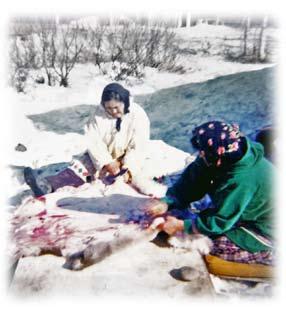
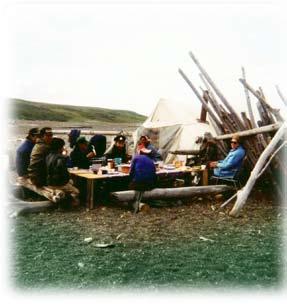
ahiin piipiuraq qinganga igianngalu qargim huluranganik, ilua halumapquvlugu iluluqungilugu.
Inugiakhirut taaktit. Taimani aniarvingmukapta ilaani qimilriuruugaatigut narihaaqapta. Aklarvingmun utaqiyaqturuuruagut, irniniaruutiptingnun aglaani.
Sarah: taimani aniarvingmi irnikapta qulini uvluni itchuuruaguut, pangm ahiin qilamik anipkaqtiruuhigait.
Huhuvihi irnianikaffi?
Emma: Taimani havangihaalaitchugut (iglaqtuq) . Taitna inuniaqalagaqtugut.
Emma: Malrungni kiaq aimalakhuta, kukiuhauraraqtugut, iqaqrivlutalu. Ingliaraan ulugviktitaqlugit makkat iqarihuukavut. 1950timi iqaqrihiniqaatunga, Kamatchayaaqtunga. Aulautimivlugu aulaaqturviptingnun.
arraa ingiqruqta aapaptingnun ikayuqhuluta irnipkaiharupta. Piipiuraq tuqutqungitkikput. Qinraqtugut. Nutauvluta, 39-40tun luuniin ukiuqaqlunga. Nakuuruamik qinraqtugut. Ingiqruqtugut irinipkailautaruhuta. Aakangalu iqipiahugruktugut tuquniarahuivlugu. Irnihuliqhuni piipiuraq anihulirataqtuq. Piipiuraq aglakulaaq anikami. Effie uqalautigiga, kipilagu, Qiliqhaaqlugu qalahia, halihingnik kipigiga.
Uqalautigiga Effie makamik tiguhiin iqivailuni. Alraanga hamma anihiruq, ilvit piung tamna uvanga piipiuraq pihiiga. Alraanga anipqauraqman, aakanga. Nakuuruq. Unaakhiqtaq ulikruaq ingnirvium haniani pivlugu puuqlugu ahiin piipiuraq uularruaqtun. Tavra ahiin kigiunauramun ilivlugu ingnirvium, hanianun inilaklugu piipiuraq. Inuuruq pangma uinik hunilu quyanaarugaanga pangmapak anipkaqamni.
Sarah: Uvangaptauq irinipkairhimarunga Ikaahungmi.Iqilarma. Angatkulahuuvat iliaraan nakuuqipkainiaqhuting ingliaraan.
Sarah: Taitnahiitchauguut.
Emma: Halihitualuuk, ivalukrqmik, qilirutikramnik.Halumaqlugu
Sarah: Aaqaqhuta tuvaqatipta kigvaluktanginik makiqihauraraqtugut. Ingilaraan havaakrauruaguut. Ituataitchugut aptala, aptala, aptala, aptala, hinikharniarutimnun aglaan.
Angutit ikayuruuvaat?
Sarah: Anguniaqtit.
Emma: Havak pauraruuruat. Ukiupahugruk upinrakraqtutilaanu. Kigvalungniarniq June 15mun aglaanittuaq. Unuapaiqlugu anguniaruuruat, uvlangurataqtilugu. Taimani inuuniqniarniq nakuuruaq.
Sarah: Hukaitchuaq ingilaraan.
Emma: Hunaliqaa piaktuatun ittuaq. Aulaaqturvingni uumarmi itkaluaqapta taima ahiin Aklarvingmugaqtugut.
Utilginapta aimaviptingnun havakhauraaqhillgilluta.
Sarah: Piuraruuraguut Atanrum tuquviani, Ukiutchiamilu, qitchirvingmi, nutaqqat anuraatchiaqhuting, iluqating kamitchiaqhuting, atigitchiaqhuting, aitqatitchiqhutinglu,
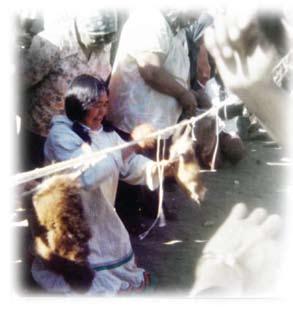
TUSAAYAKSAT SUMMER 2008 46
Sarah and Emma fleshing a caribou hide. Sarah at a good woman contest skinning muskrat. Lunch at bushcamp.
Photos this page and next courtesy of ICRC.
uvlupak ahiin atlanguqtuq – taitnaingaiqhuq. Aptalaatchaguuruaguut, nutaraugaluaqhuta. Anuraatchialiurugivut. Aklarviktuni ahiin, tauqiqhurnaqtuq qaliruanik kamiklungnik, ilupaanik, atulaanik, nutqqat tauqhilahimatigut hunikliqaa. Taimani arnat kiinauranik naluruat.
Emma: Taimani nalurugut famililaunik. Naluruguluuniin akilaanik tigugarnanik, Tuvaaqativut naniriaqturuuruat, niutuuyiq, kivgaluk, kigiaq, qaviachiqniklu kiinauraningniaqhuting uumarni. Inuuvingmukapta havakanagutirugut tavra ilitchurivaluktugut kiinauranik akiliuhiaqtaliqapta.
Qanuqlugit inugiaktuat munarivigi, nutaqhahi ?
Sarah: Angayukliit ikayuachiaqhuta.
Emma:Avaluraqaqtuat nutarauravut tavra piurarvingat. Angilihaaqhutinglu, qatautchikanik paniqtaamik immunikluta Iluqata miluktititchivluta, aquvatigun ahiin paniqtamik immunikhuting? Angiruanik qatautchikalgit. Aklavalugu immirmun immuliuqhuta. Arigaa mamaqtuq immuk. Nutaqavut nuvakhimat marahiqaqtuat, taatiliarutihuukavut. Iluqating kapipkaqtitchuuruat, ilichuripqaruukait nalautitigun, nutaqqahi qaritchutihigi kapipkariaqhigi. Inauramuutihuugivut kapinaqhimata.
Aliahunginiq iniqaruvihiung?
Emma: Piippiravut amaaqlugi mumiaruuruaguut, Inuit ikayuutihuuruat qinauraqhiulaitchut. Pagirihuurut akiilaaqhuting. Pangma akilaaruting pagilaiqhut. Taimani, pingkunik haaptarnimik naluruaguut taitnahinik naluruaguut.
Inuit Atlagiagutivarrung irniniq?
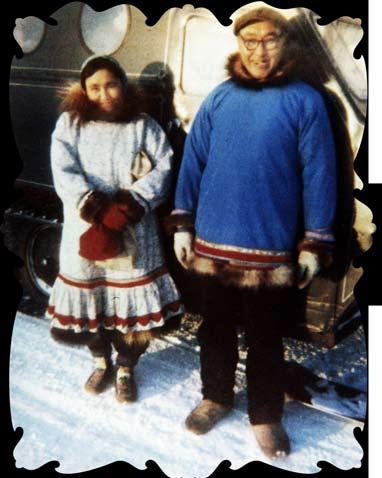
Sarah: Inugiaktut niviaqhiat iriniuqtuat pangma.
Emma: Tautchimiittuat katitiraluaqhating inuguiakhirut, angutautilgit.
Ilangit inuit ilihangairaqtut ilaani narihaagaming, Qanuk ihumatigiviung?
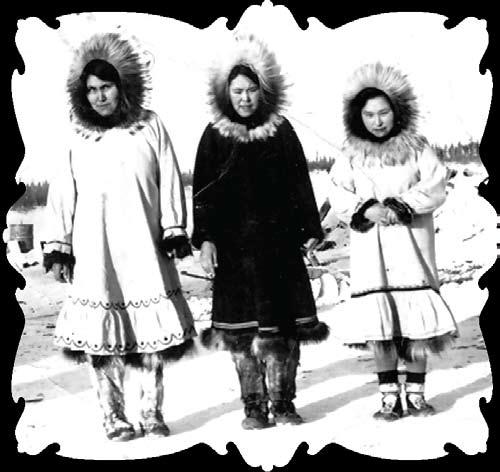
Emma: itnali ihumahurunga iliharniq pinarnaqhilhaaqtuq piipiuraqarnimin. Ilihaqaruhi havaanalautarumauhi. Havaanalautiqarukuvit ilihaqpaurarin qutchiktuani iliharvingni. Ilangit piipiuraqaqaaqhuting utiruurut iliharvipangnun.Ihumakama quyagihuugitka ikayuqliqtuat taitnahinik. Ingliaaraatun inngitchuq irniyailaqtuliqhut maratchinik, pangma ahiin ihumamiktigualiqhut. Inuuhiptingni, uvaptikualaitchugut.
Pangma ahiin nutaraqarungitkuming, nutaraqangilahivluting. Nutaraqarukuvit nutaqiurin. Ilipkualarutin ihumapkualarutin.
Pangma kihian anihukaluaqpiit ilipkuaqtuarnamik?
Emma: Naaga Naaga, 1920ni animaruangaa quviagiga.
47
e lder Story Innaum Quliaqtuanga
Sarah and her husband, Rufus.
As young women: Hester Cockney, Emma Dick and Lucy Inglangasuk.
Photo courtesy of Duane Smith
Keeping the music strong
yellowknife - Wading through all the running, jumping, racing and leaping, it’s easy to forget there’s more to the a rctic Winter Games (aWG) than just athletics.
from its inception in 1970, the Games have been a celebration of n orthern culture, as well as n orthern strength, agility, and endurance.
a nd few Games have shown off as much of that culture as the 20th Games this year in yellowknife.
Leading the charge were the a klavik Drummers and Dancers, who brought the sounds and movements of the Delta to representatives from around the n orth.
If you ask them, they’ll tell you how important it is to represent this aspect of Inuvialuit culture.
“We have to keep our culture alive,” says s hayla a rey, 19, who was at her second Games. “We have to pass on how our elders lived.”
But performing is only one way to keep traditions strong. There’s a teaching component as well.
Onstage, the group isn’t satisfied to just show you Inuvialuit culture, they want you to understand it was well.
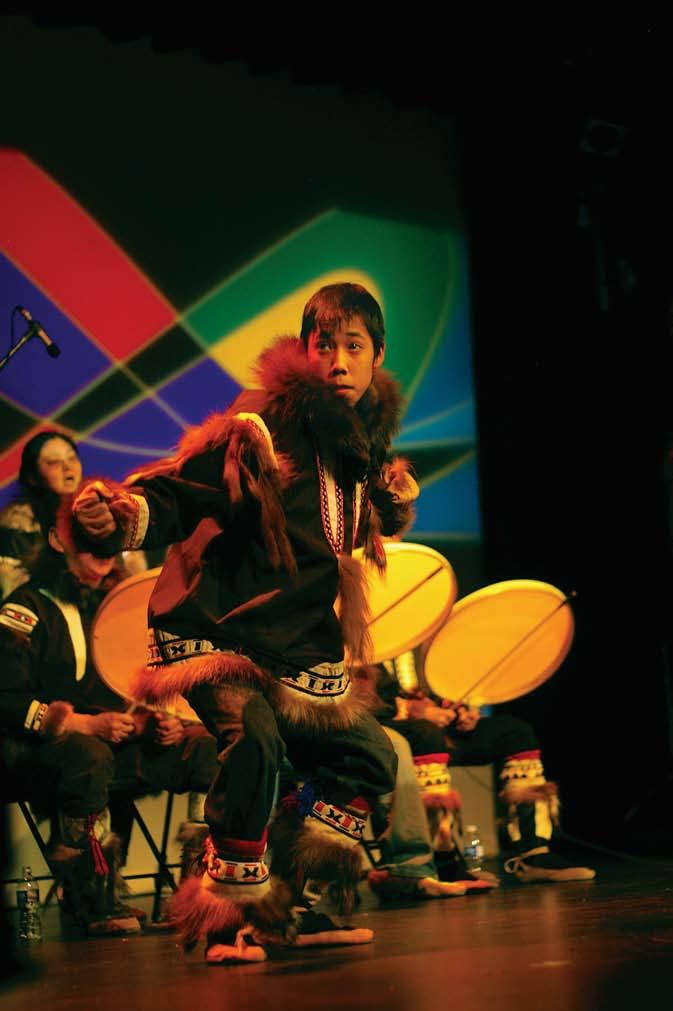
TUSAAYAKSAT SUMMER 2008 48
During a performance at the Tree of Peace, Dean Arey describes the different songs and dances, what they represent and why they are important. According to their official bio, the drummers have been doing just that since the 1900s.
Words by Adam K. Johnson
Special Feature Nuitaniqsaq Quliaq
Aklavik drummers and dancers get around at AWG
The Aklavik Drummers perform at the Arctic Winter Games 2008 Cultural Stage at the Northern Arts and Cultural Centre in Yellowknife.
Storming the Games
o ne song represents the animals of the Delta, such the dancing of the loon – imitating their movements –and another honours elders.
for the last song, a rey throws out an offer to the crowd, which was greeted heartily.
“ you’re welcome to come up and try the Inuvialuit way of drum dancing.”
a s the drumming moved from the soft to the hard beats, members of other cultural contingents took the stage to try their hand at some new movements.
f ans in attendance at the cultural gala at the Tree of peace were treated to more than just drumming, however. a duo broke off from the rest of the group briefly to show off their skills in other areas.
a lexander Gordon and John s emple, both from a klavik, pulled out their acoustic guitars and played a few old-time country and rock 'n' roll favourites.
“We played 'That’s a lright' by Elvis presley and 'o h Boy' by Buddy h olly,” among others, says Gordon, 16.
Both say they’ve had a great time at the Games, and look forward to taking in more.
“It’s awesome,” says s emple, 15. Dean a rey says the experience was a blast for his kids, and hopes to take in a couple more Games if he can as well.
“[The youth] are having a great time, they’re meeting other cultural participants and enjoying the Games.”
“It was just great.”
Inuvialuit youth find fun, friendship and a few ulus at the Arctic Winter Games
When he got off the plane in yellowknife, u lukhaktok’s a lex a khiatak had one thought on his mind. “ swimming,” he says with a grin during a break at a rctic s ports. h e’s sitting on the stage of Ecole st. Joseph, a school in one of yellowknife’s suburbs. In a truly a rctic moment, the power has just gone out, but athletes are continuing the kneel jump by the yellow glow of the gym’s emergency lights. The 20th arctic Winter Games have just begun, and Inuvialuit athletes in a rctic sports are just settling into things.
for a khiatak, the trip was a chance to get a taste of different living in a community of 20,000, rather than 400 – a chance to meet new people, and take in new experiences. These just happen to include a wave pool and a big movie theatre.
o f course, he was there to compete, too; even though things didn’t work out how he liked in triple jump.
“I came in dead last,” he says, shaking his head... but still managing a smile.
The 20th a rctic Winter Games in yellowknife drew thousands of athletes, volunteers, and spectators to venues around the n WT capital.
The anniversary was a homecoming, once again bringing the Games to the city where it all started in 1970, when then-prime minister pierre Trudeau showed up decked out in furs to kick start the first-ever Arctic Winter Games.
originally, the contingents were the n WT, yukon, and a laska, but grew to include russiayamal, n orthern a lberta, n unavut, Greenland, s aami, and n unavik-Quebec.
a nd as organizers and a khiatak pointed out, it’s not always about competition.
The Games were begun as a chance for n orthern athletes and performers to compete at their own level. a s many are from small communities without major training facilities, the Games have never been just about elite athletics – it’s always been a mix of personal and cultural exchange as well. Inuvialuit youth at the Games tend to agree.
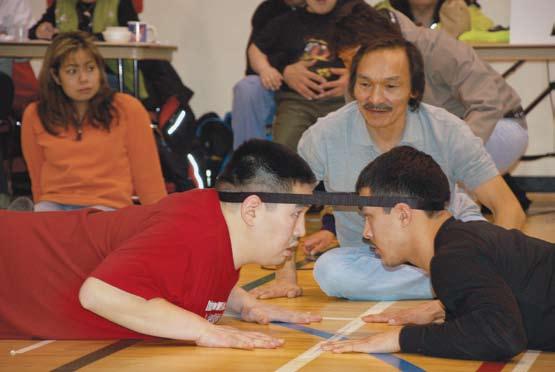
Jerine kotokak, from Tuktoyaktuk, says the trip was a great chance to meet new people and stretch out her legs in sports.
o n the last day of a rctic sports, kotokak is horsing around with her teammates, climbing the ladders fastened to the gym walls and swinging from ropes attached to the ceiling. s he even takes a chance to steal this reporter’s camera for a moment and capture some of her teammates.
49
Adam K. Johnson photo
Photo by Jennifer Obleman
Gary Oheena takes on Pilo Rasmussen of Greenland in the head pull during the 2008 Arctic Winter Games in Yellowknife.
Though she prefers to talk about her team’s movie choices (on College road Trip: “I left halfway through. It was so boring.”), she also came away with a silver ulu in the kneel jump.
“I have some family here so it’s good to see them too,” she says.
Before the event, coach Christina Elias said she didn’t want to single out any of her players, but thought she had a “good team.”
“I think it’s going to be a good Games.”
a nd for some, it was.
Chad Memogana, from u lukhaktok, had one of the strongest male showings at the Games for Team n WT. h e took gold in the triple jump, as well as being honoured with a sportsmanship award.
“I expected everyone was going to go as far as me,” he says of the triple jump competition. “In the end, they were all about a foot behind me.”
Tusaayaaksat caught Memogana just after the sledge jump, where he leapt over around 80 sledges. h e hoped this would be a medal showing, but it was not to be. h e was crowded out of third by Greenland’s Edgar Markussen.
The 16-year-old junior male competitor was a drum dancer before friends convinced him to try his hand at Inuit Games. Memogana was quick to point out that, on top of meeting new people and competing, the Games – and a rctic s ports in general – have an important cultural purpose.
LOOKING TO THE FUTURE Former Inuit Games athlete takes on new challenges
a nother strong performer was fort s mith’s Veronica McDonald. The 13-year-old finished second overall in the junior female category. She took home a gold ulu in the kneel jump, a silver in the triple jump and a bronze in the a laskan high kick.
s o how do two girls from the southernmost community in the n WT end up on the Inuit Games team?
“My mom holds a couple of records,” says Melanie p hillips, also from fort s mith. “ s he helped coach us.”
a s preparation gets underway for the 21st a rctic Winter Games in Grande prairie, a lta., at least one Team n WT a rctic sports athlete says we haven’t seen the last of him.
After his very first major competition, Memogana says he thinks the a rctic Winter Games are going to become a habit.
“My first time coming here and getting a gold medal, I’m happy with that,” he says. “ n ext time I’ll try out for open male.”
“We’ll see what happens.”
If you take a close look at the roster of Team n WT’s Dene games team at the Arctic Winter Games, you might find an unexpected inclusion. John stuart Jr... from Tuktoyaktuk.
Which begs the question: how does a guy from Tuktoyaktuk become a Dene games athlete?

“That’s actually the first time that’s been asked,” the 28-year-old says with a chuckle outside the Dene games tent in yellowknife. “I can’t compete in a rctic sports anymore; I can’t kick and I got no more power events.”
In 2005, he was introduced to Dene games. To his surprise, he liked it, and joined Team n WT in 2006 for the 19th a rctic Winter Games in kenai, a laska.
“I didn’t do so well,” he says of those Games, as he was new. But this time he came to win. In the tent beside yellowknife’s city hall, stuart’s team took on Team a laska in the hand games tournament. a nd the atmosphere couldn’t be more removed from an Inuit Games competition.
Gone is the quiet and concentration of the one-foot high kick, replaced by the thumping howl of dozens of Dene drummers and singers cheering their teams on. The tent is electric with the pulsing beat, and the NWT players dance, hide, bluff, and choose against the American team.
With one false choice, however, the game ends with an a laska victory, and song and celebration is replaced with disappointed silence in a heartbeat. “We’ll get it back,” stuart says after the match wraps up.
Even without a win in the hand games, stuart says his team has done well. “It’s been really good,” he says. “a s a team for open male, we won bronze for pole push.”
“The team has been excellent. There’s really good team spirit and we all know each other now.” h owever, stuart wasn’t able to medal in his strongest event – finger pull – due to injury.
“My wrist got twisted and the pain shot up to my elbow,” he says.
“It hurt like hell.”
stuart’s team would eventually take bronze in the hand games.
TUSAAYAKSAT SUMMER 2008 50
“The sports we do used to help our elders survive,” he says. “At least that’s what my elders told me, that you used to have to do this before you could go out hunting for days on end.”
Nuitaniqsaq Quliaq Special Feature
John Stuart Jr. of Tuktoyaktuk stands up during the hand games tournament at the 2008 Arctic Winter Games.
Adam K. Johnson photo
This year’s Inuvik Petroleum Show
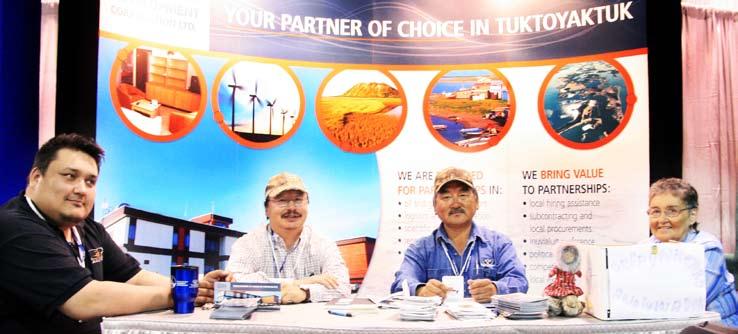 By Anne Crossman, editor of Permafrost Media
By Anne Crossman, editor of Permafrost Media
“Mackenzie Gas project: o ur s hared future with the pipeline” was the theme for the 2008 Inuvik petroleum s how (I ps). This was year eight for the show that feels like that Energizer Bunny – incredibly optimistic and it just keeps going and going and going.
This year was a bit more biting than other years though. s peaker after speaker talked about their frustration with the length of the process of getting a decision for the Mackenzie pipe. It was almost – not quite – like everyone was saying “let’s get a decision one way or another, for pity’s sake.”
Inuvialuit leader n ellie Cournoyea lead the call to everyone to lean on every person involved in the hearing process to move that forwardfaster. fred Carmichael continued that call. This was fred’s last I ps as president of the Gwich’in Tribal Council but he gave an impassioned plea that basically said, “Get on with this!”
from the opening remarks right through to the closing, those in the audience applauded the loudest when the subject of the hearing process call to action came up. It does continue to be a bit unclear, however, where the focus needs to be for that action. Clearly, the federal government is one place where frustrations should be aimed.
There was an international flavour this year both with presentations on a rctic sovereignty and a description of the regulatory process that will go on in a laska for their proposed project by Drue pearce, the us federal co-ordinator for the a laska n atural Gas Transportation projects.
There was r alph k lein, the former premier of a lberta talking about what careful budgeting when you don’t have much can do for you when the money starts rolling in. a nd there was the very funny and very approachable r ick Mercer who kept the evenings very merry with his tales of TV making.
The theme of training and some of the successful programs was really good to hear this year. preparations are certainly underway. Judy s elamio and Max kototak of the Beaufort s ea p artnership’s working group on traditional knowledge had a presentation on how important it is to take that knowledge into consideration when any decisions are being made.
Things shifted to transportation with the yukon’s minister of transportation a rchie Lang, Jim stevens of the G n WT and Carmen Loberg, the president and CEo of n orTerra – the parent company of Canadian n orth, nTCL, and other n orthern companies. n orTerra is owned jointly by the IDC and n unasi Corp. There was talk of roads, air traffic, and barging.
There were Northern business success stories, including Northwind Industries, owned by Kurt Wainman. While he is waiting for the pipeline, his company has not been idle. He told the crowd of 300 or so people that Northwind has been making ice roads this past winter and he expects to be doing so again.
While there was some grumbling about the lack of decisions, there was also enthusiasm from the industry producers who seem to be able to keep a smile on their faces and an optimistic view of the future – a glass half-full bunch. s ome of the regulators actually seem to want to be helpful – good to hear. o ur politicians want to see this project move along. n orthern businesses are mostly hanging in there albeit with their fingernails in some cases.
The recent huge land sales both in the Beaufort s ea and the central Mackenzie Valley tell us that the interest is still there. Canada is a fine, stable, and secure country in which to do business and, in these times, that is a major, major asset.
The practical, straight-talking n ellie and the passion of fred have kept this dream alive for many years now. I echo their message “let’s get on with this and stop fooling around.” Gentle and polite are not words that we should be living by on this file.
51
Christopher Yapp photo
Representatives of the Tuktoyaktuk Development Corporation, including elder Lucy Cockney, hosted a booth at the Inuvik petroleum show.
Bureaucrats Experience the North First Hand
Hands on experience:
how often do our communities have the ears of twenty senior bureaucrats from the Government of Canada? This a pril, the communities of Inuvik, Tuktoyaktuk and p aulatuk took full opportunity when ITk (Inuit Tapiriit k anatami) organized an ITk Inuit a rctic Tour for these officials with the help of Inuvialuit regional Corporation (I rC), with the goal of getting these officials to witness first hand the living conditions and the needs of people in the n orth.
The tour began in Inuvik, where government officials were presented with an update on current issues of concern from the I rC. Questions on issues such as governmental deficiencies in Inuvialuit Final a greement (I fa) implementation, climate change research support and community wellness funding were posed by IRC to the officials. It was the first time traveling above the Arctic Circle for most of the officials, except for Trish Merrithew-Mercredi, (Regional Director General, I naC - n WT region,) who had lived in a klavik and Inuvik before. The communities made sure to receive the government officials with true northern hospitality.
The officials were treated to a feast and drum dance in Tuktoyaktuk (many even learnt some drum dance moves!) and were taken out to Thrasher Lake in Paulatuk for a delightful ice fishing derby, complete with ‘eskimo doughnuts’ and caribou soup.

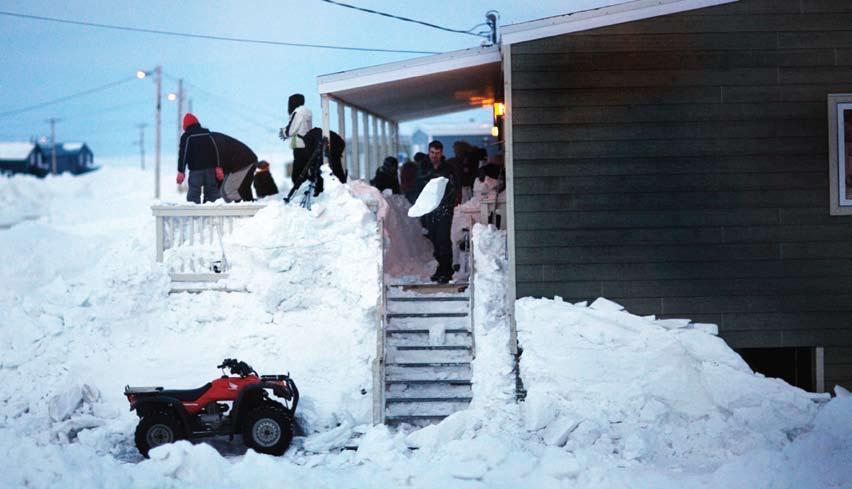
At the official town council meetings, hamlet officials and community members adopted a more serious note. Community members also came out in full attendance to voice their concerns about the challenges they and their families faced, living in isolated communities in the far n orth.
robert Gruben, Tuktoyaktuk Community Corporation Chair and Merven Gruben, hamlet mayor expressed frustration over the delay in getting a gravel road built between Inuvik and Tuktoyaktuk. “There is a lack of funding, maybe even vision by government,” said robert, “we cannot keep asking and have nothing happen. our closest gravel source is 20 kilometers out of town, it has been seven to eight years since we’ve had a major haul of gravel for construction.”
Elder Lucy Cockney spoke about how legal
Nellie Cournoyea, Chair of IRC, reminded the government officials that very often governmental doctrines and programs do not translate into financial or resource solutions to help the communities, and that often departments in different levels of government pass the buck when it comes to taking responsibility. “It seems that often there is a lack of attention to issues as they come up, and people in the communities are getting tired of it. r ight now we seem too dependent on government. h ow do you pull together different government departments to get something passed?” s he also wanted government accountability regarding the delayed Joint review p anel (J rp) decision on the Mackenzie Valley pipeline.
TUSAAYAKSAT SUMMER 2008 52
red tape prevents liquor smuggling from being eradicated in the communities. “We all know who it is, and we call the RCMP, but they don’t come in to help us catch them.”
Special Feature Nuitaniqsaq Quliaq
At Nellie’s request, bureacrats from Ottawa helped elder Mary Evik shovel out her porch, which was several feet deep in snow.
The tour included a visit to Angik School’s science class.
made. s ally L. Thornton, executive secretary to the Treasury Board s ecretariat spoke on behalf of all the officials. She said, “We hear the immediacy of your needs,” and also accepted that all departments are collectively responsible for the ‘embarrassment’ of bureaucracy that prevent solutions such as the J rp decision from reaching the North more efficiently.
The same urgency was heard in the voices of people who attended the special council meeting in p aulatuk, as Community Corporation Chair Gilbert Thrasher and his staff relayed similar issues faced by their isolated community. Community members and elders spoke out on issues of mental health support, housing, transport, education, energy and day to day challenges such as the unaffordable cost of bringing fresh groceries to the communities, issues that southern policy makers are usually not exposed to.
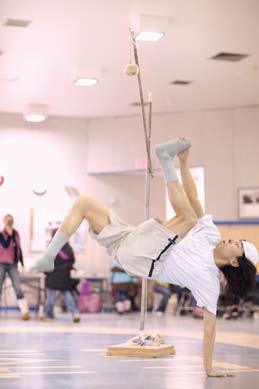
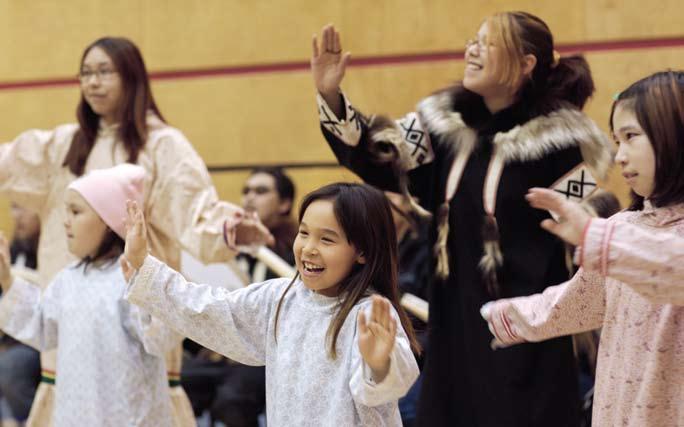
robert Clarke, assistant deputy minister at the public health a gency of Canada, came away from the tour with a renewed sense of purpose. The tour experienced two small hitches, once when part of their luggage was ‘bumped’ to a later flight, and another time, when their accommodations in one of the communities ran out of water. “It really helped for us to see the logistical challenges people have in these harsh conditions, it was real life,” he said. When asked whether the bureaucrats will be able to help the n orth given what they have seen, he replied, “ u ltimately in a democracy, politicians are the ones who make the decisions about programs and funding,
but we certainly have a lot opportunities to influence and to be creative, and to put ideas forward and design programs.”
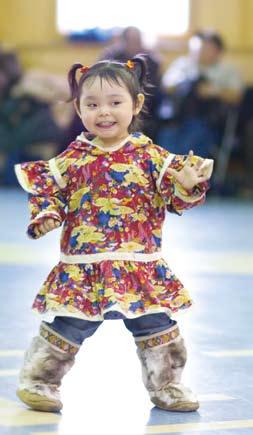

h e also felt a sense of bonding with his fellow Canadians in the n orth. “It was a lot of fun, especially when we went out on the land and got a chance to experience what we heard about. We had never been out in skidoos and sleds, and the drum dancing, it was wonderful.”
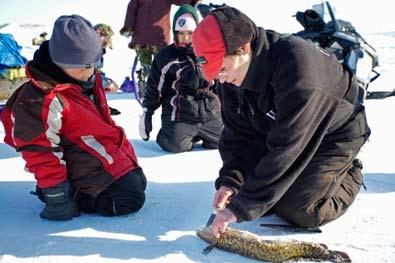
53
“Collectively people have to start asking questions,” said Nellie, “when they put these bodies together, what are their deliverables?”
Trish MerrithewMercredi responded that government is actively planning in advance so it can act quickly once the J rp decision is
Paulatuk’s drummers and dancers put on a robust performance.
Anne Thrasher shows a child how to clean a fish at the derby.
Matthew Anikina shows off arctic sports.
Dee Dee Nasogaluak delighted the visitors with her drum dancing.
Northern National Parks: Canada’s Window on the Western Arctic
What is Parks Canada all about? It’s about more than protecting parks for the future or ensuring that people can visit national parks. Every national park has unique stories to tell—stories about the land and the people who lived and travelled through it. Parks Canada is about making sure that each park has a chance to tell its story to everyone.
But what about the majority of Canadians who don’t visit? How do we fulfill our obligation to help them learn about national parks?
Parks Canada’s mandate is in three areas: protecting these special places for all time; helping visitors to enjoy them safely; and public education. It is important that all Canadians learn, or have the chance to learn, about the unique stories each and every national park and national historic site has to tell. The Western Arctic national parks are a legacy of the Inuvialuit Final Agreement, a gift from the Inuvialuit to the people of Canada. We think it is important that Canadians know this. It is important for people also to know that the parks are co-operatively managed.
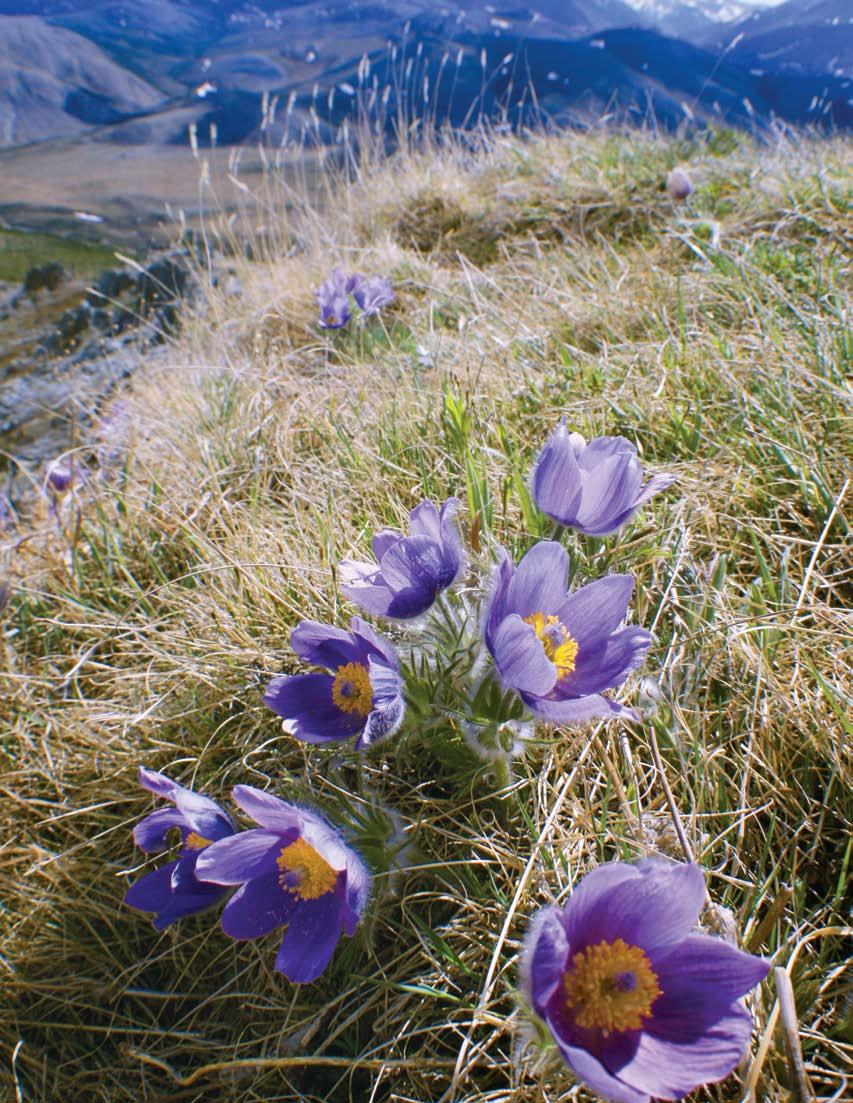
Telling all Canadians about the parks to people who may never visit is a challenge. Parks Canada does this through its website and through national promotion including facilitating television documentaries. Nationally, the website receives 10 million visitors a year.
By Pat Dunn
Photos from Parks Canada
This is one of the best ways for people to find out what is special about national parks. In the past 10 years, 8 documentaries about the Western Arctic national parks were created with Parks Canada assistance, and then aired on national television.
Parks Canada also works to tell the stories of parks and sites through schools, where students are learning about Canada. What better way to find out about Canada than by learning about the parks and historic sites that have been created to tell Canada’s best stories? The Parks Canada in Schools website – The Teacher’s Corner – provides an increasing number of resources to teachers who are telling these stories to their students.
Everyone visiting our parks registers with Parks Canada before they go. At that time we also provide a short presentation on what is significant about the park they are visiting. This orientation is provided now to all visitors to the Western Arctic national parks, as a way of helping visitors stay safe, and to help them know what to do to help protect the park while they are in it.
Parks Canada guides its activities through the Parks Canada Charter: We are guardians, we are guides, we are partners, we are storytellers. Parks Canada is about making national parks relevant to all Canadians.
TUSAAYAKSAT SUMMER 2008 54
Nuitaniqsaq Quliaq Special Feature
Parks Canada website visitors
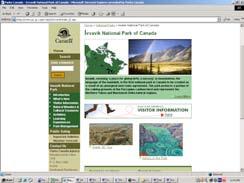
(2006 figures)
p arks Canada’s website works quietly away in the background, providing information on our national parks 24/7 to thousands and even millions of people.
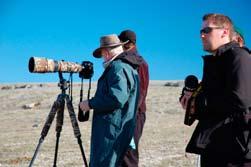
Parks Canada national website: 10 Million
Ivvavik National Park website: 26,000
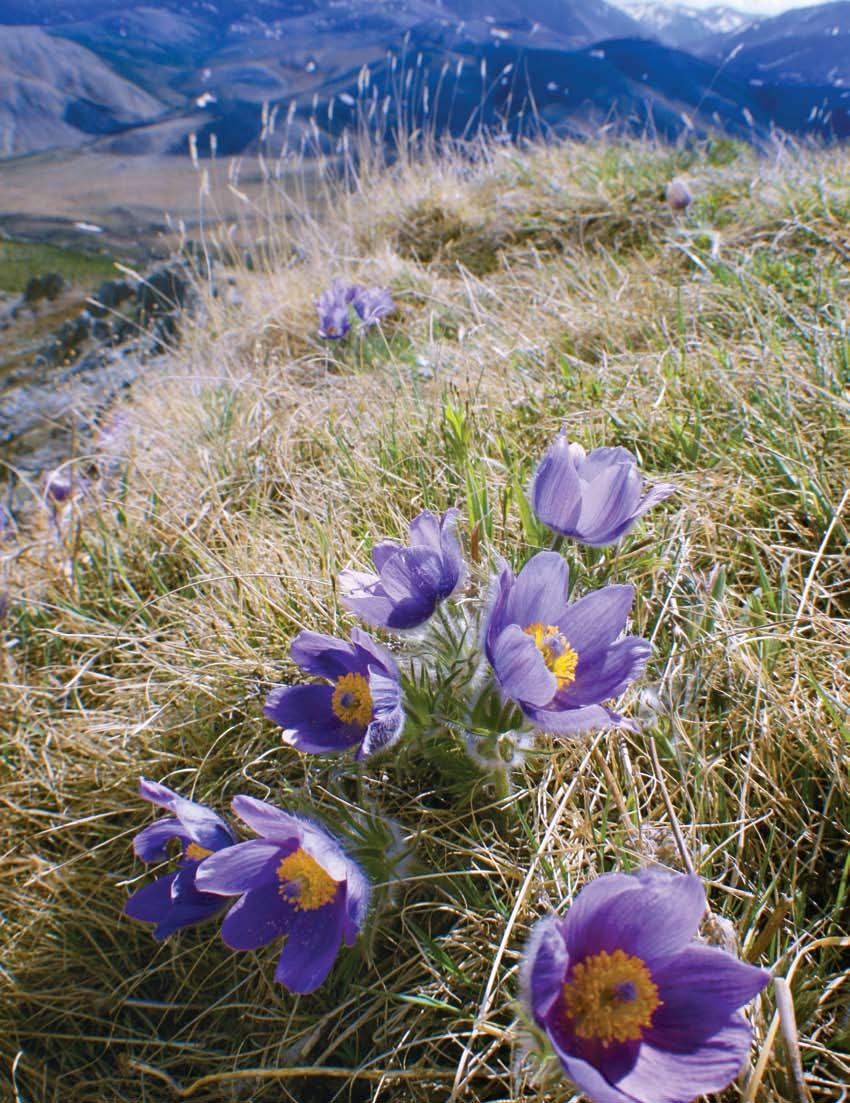
Aulavik National Park website: 9,000
Tuktut Nogait National Park website: 22,000
The main stories and themes of the Western Arctic National Parks
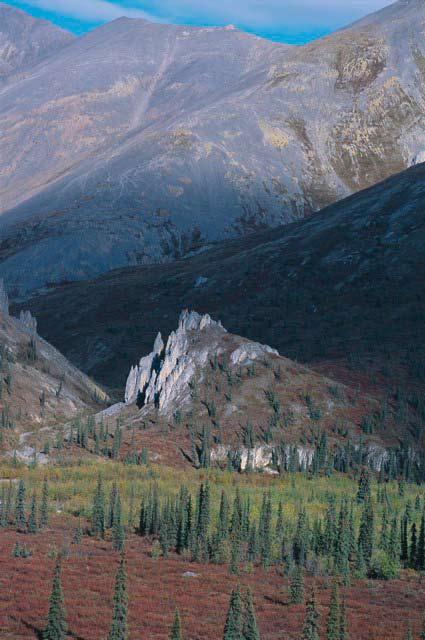
Ivvavik National Park: Canada’s first national park established as a result of an a boriginal land claim.
people have traveled through what is now Ivvavik for thousands and thousands of years. In the past century people also panned for gold there. There are many claim posts along the firth r iver in Ivvavik n ational p ark.
Aulavik National Park: the place people Travel, where people travelled along the Thomsen hunting muskox, and later, salvaging wood and metal from the site of the wrecked Investigator at Mercy Bay.
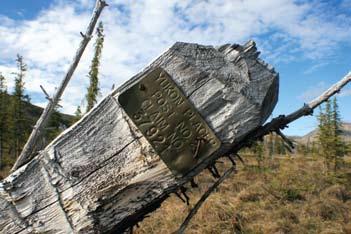
o ne important goal for establishing Ivvavik, aulavik and Tuktut n ogait n ational p arks was to protect the calving grounds and important habitat of different caribou herds – porcupine in Ivvavik, Bluenose in Tuktut n ogait, and peary in aulavik. Visitors and non-visitors alike are interested in a rctic wildlife. o ur guides will show you a bear stomp. a bear stomp is a trail made by generations of bears walking, each bear putting its foot in the footprint of the bear that came before, till a line of bare spots is created.
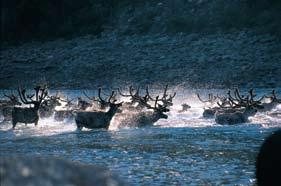
 Ivvavik fall colours
Ivvavik fall colours
Speaking o ut at
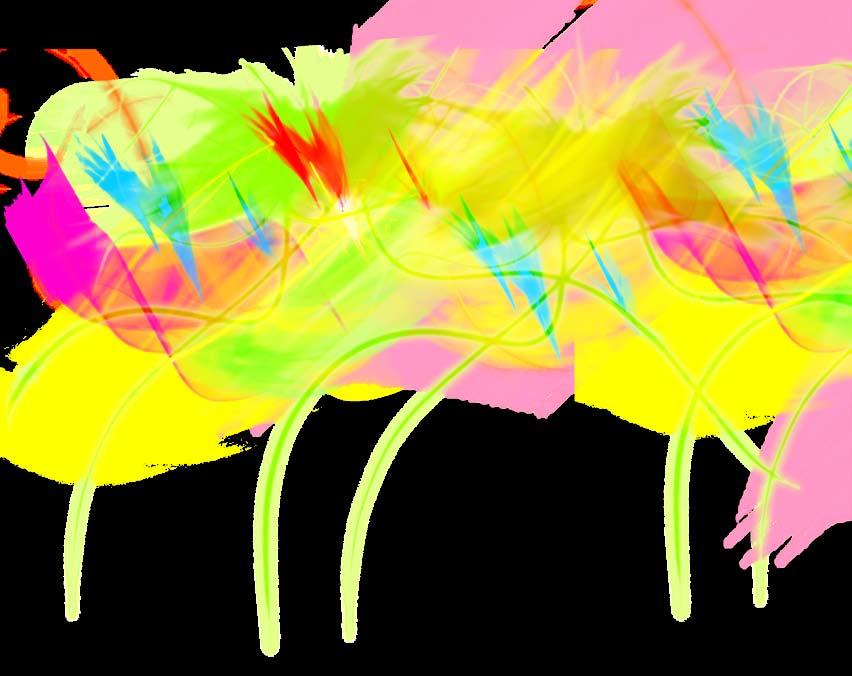
Every youth that you see here is courageous. They represent some of the youth who spoke up at the youth Town h all this a pril about their dreams, frustrations, solutions, and fears, all while under the pressure of speaking to a full audience at the s ir a lexander Mackenzie s chool hall. Their audience was made up of youth of all ages, from Inuvik and its surrounding communities; leaders, educators, adult and elder community members, and of course, the Governor General Michaelle Jean, who had wanted this forum to happen so she could listen to the voices of n orthern youth in this region, and help make them heard. s he told the youth present, “I want to hear about your dreams and your aspirations. I want to learn about the challenges you confront. I also want to reflect upon your unique capacity to make a difference.”
Cameron McDonald kicked off the forum, bravely admitting that he was nervous but inspired to speak in front of her Excellency. The student council president of s amuel h earn s econdary s chool headed the five-person youth panel. He eloquently described his love for living in the n orth, where “it’s great to play sports with the sun high in the sky at 2 am.” h e then voiced concern about global warming affecting his home region, and listed activist communities such as a rcticVoice as possible ways to educate a southern audience.
The rest of his panel members – Jessica h ailey, a ndrew f air, Taisha Blake, and Britney Lucas Cockney expanded on how they dealt with opportunity lost and grasped as n orthern youth.
Many more voices spoke up at the three microphones positioned around the gymnasium. s cott Boudreau asked the panel about peer pressure at the high school, where he would soon begin his first year. Jessica h ailey reassured the audience that cliques in her school are less judgmental than those in southern schools.
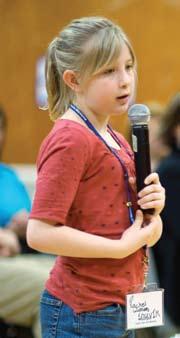

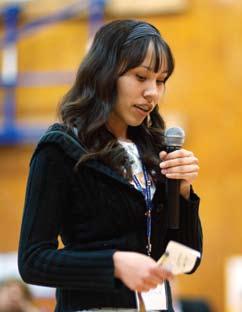
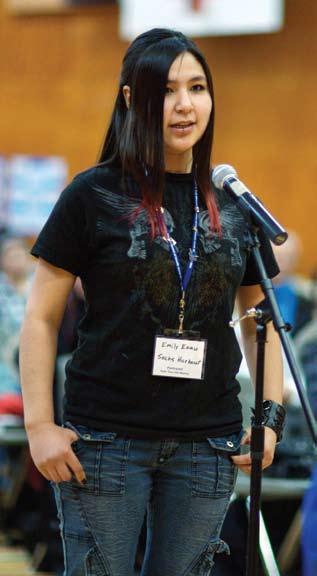
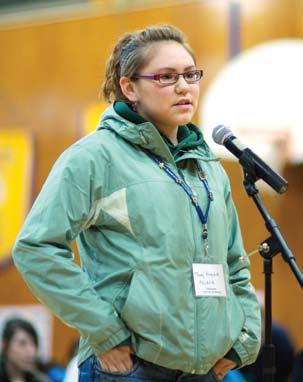
“o ur school is smaller and the groups are smaller. There are always people who do things that are not appropriate, but in our school there’s not a lot of differences between the groups. Down south there’s a lot of judgment just based on how you look, but here we’ve such small groups that you’ve got to know everybody.”
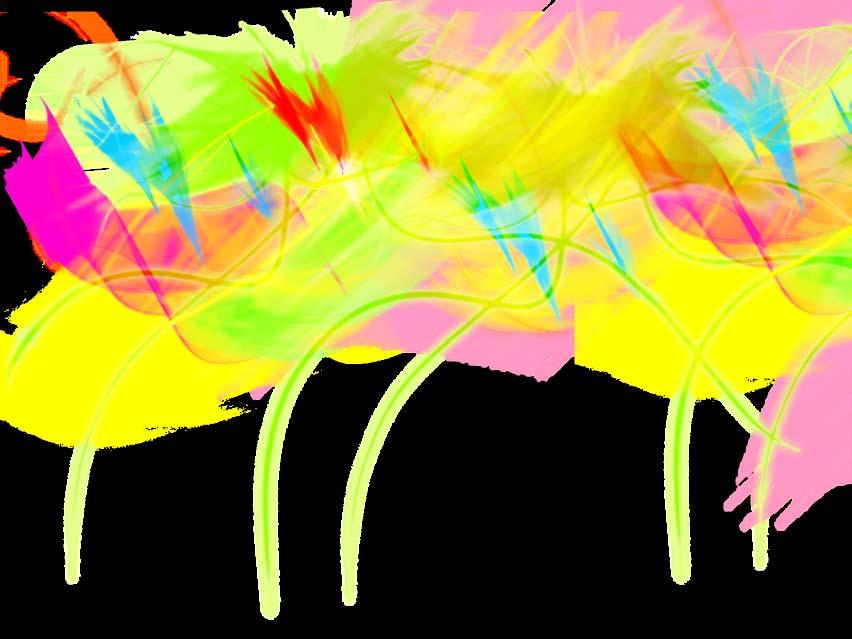
TUSAAYAKSAT SUMMER 2008 56
youth Town Hall
The dynamic of issues being brought up, and solutions or advice shared back and forth between the audience, youth, and panel continued throughout the night.
Youth of all ages, from a variety of backgrounds had ONE uNITED VOICE: They wanted MORE, from their schools, their communities, and their parents. And they were ready to give more too, to work for the oppourtunities they wanted.
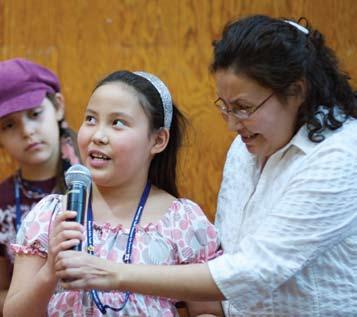
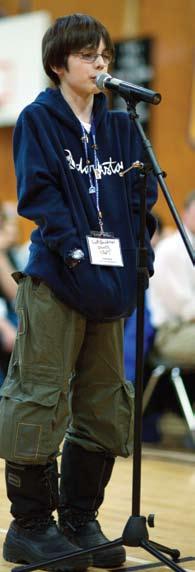
Encouraging youth as they came up to the the microphone, the Governor General stressed, “I am proud of people for coming up with confidence. These questions are very important. Why can’t it [education and opportunities for youth] be the same quality? It is important to say this must change.”
youth were also not afraid to ask weighted questions. Emily Esau wanted to know whether the proposed gas pipeline is the only alternative for money needed to fund programs in the n orth, and n ellie Cournoyea, CEo of I rC, explained the balance pipeline proponents hoped to find in order to both advance local people and to protect the environment.
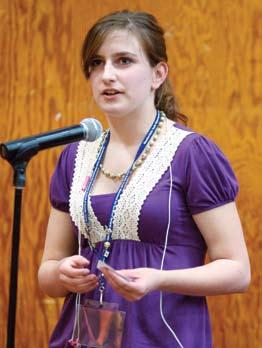
Chelsea Jacobson from Tuktoyaktuk asked why smaller communities like Tuktoyaktuk received less funding and had less programs compared to a larger community like Inuvik. s tudents wanted more arts and culture programs, as well as for french immersion to continue at the highschool level. They also wanted high schools with more choice in curriculum, and extracurricular activities, and at the very basic level, for it to be possible for smaller communities to provide students with education up to Grade 12. Community members such as ruth Wright said that any community member can contribute to the youth by volunteering. s he had started a cooking class, a recycled art club, and was helping students with difficulty in reading.
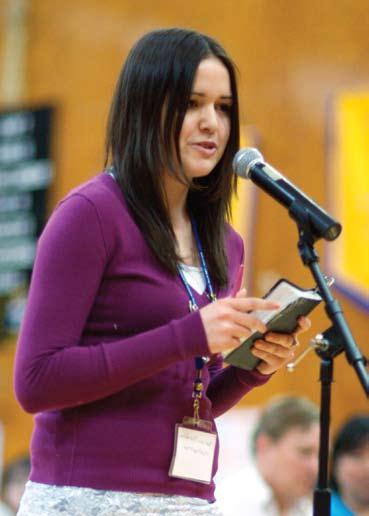
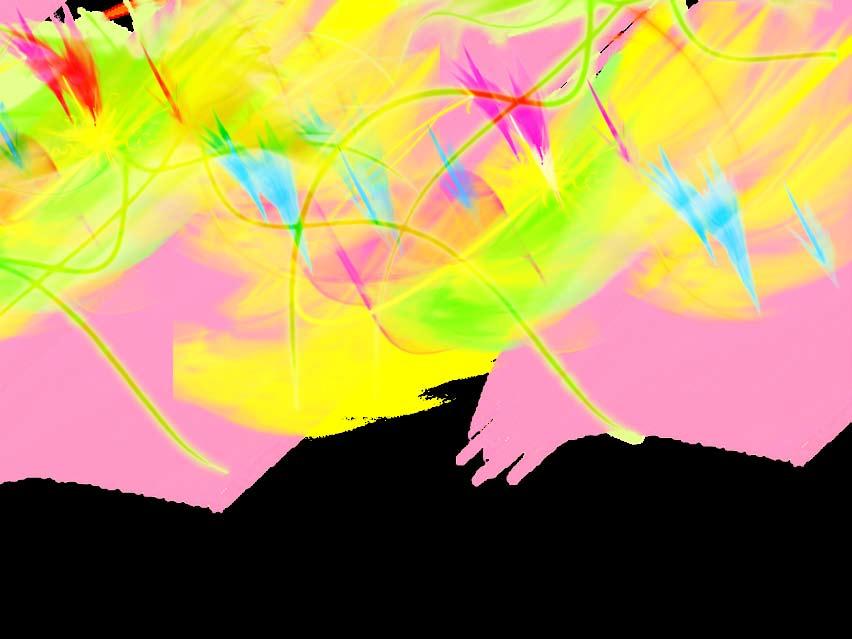
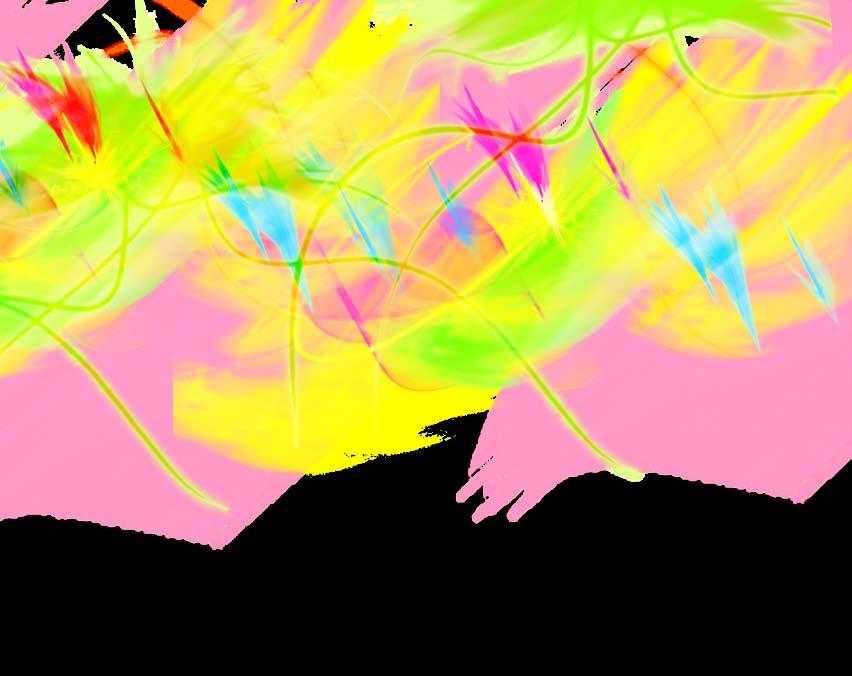
Youth were determined not to let the limitations of their isolated communities become limitations to their dreams. “Smaller populations are a reality,” said Ashton McLeod of Ft. McPherson, “but is lack of educational opportunities also to be a reality?”
Youth Speak Up Nutaqat Uqaqtut
This youth wants to have more involvement in decisions about climate change. >>
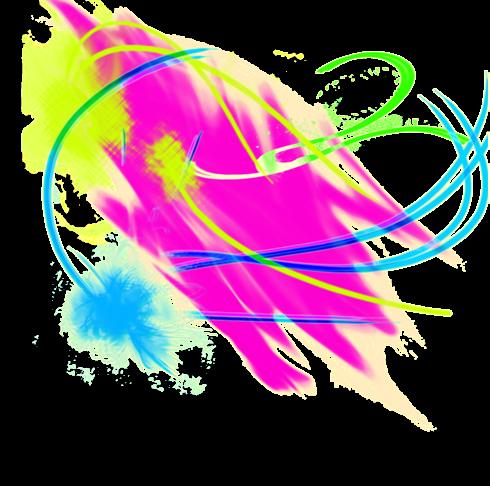
Breaking Stereotypes
Elizabeth h unter, a youth from Inuvik, made an impassioned speech that stayed with the audience. “I don’t want to be stereotyped anymore,” she said. “I don’t think kids of the n orth should be seen as bored, suicidal people who are always drunk and have nothing else to do… I don’t know what I can do to change people’s views of n orthern youth but this is how I am going to try – yes, we’ve to find more things for ourselves to do, but some of us do it very well, we find productive things to do, there are teenagers that go out on the land with their grandparents,… they go out jiggling in the winter time, young teenage boys learn how to whale…and they go muskrat trapping. Girls learn how to sew and how to cook meals…we’re always out skidooing. s o many kids like having a good time in the n orth, but not everyone in the n orth drinks. I have many friends who stay away from drinking. We choose not to do it and still have a good time.”
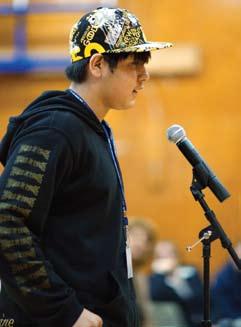
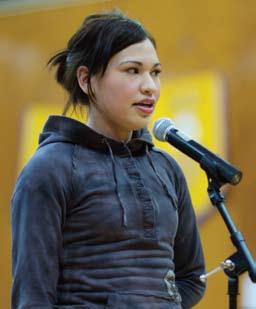
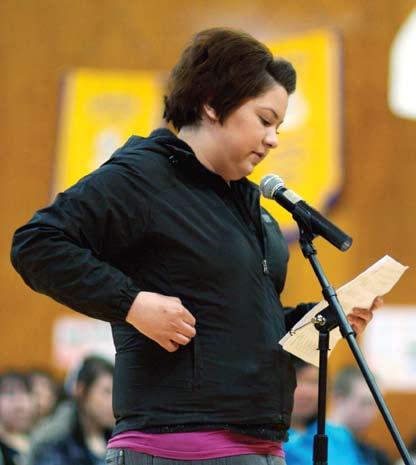
Top: Elizabeth Hunter wants to see stereotypes smashed. She believes Northern youth have potential and are trying.
Left: Ashton McLeod wants to have the same oppourtunities as youth down south.
at the end of the night, the Governor General was visibly moved by all the heartfelt voices that opened up to her. s he praised the youth for their “appetite” for more, even as they are facing the challenge of being caught between a traditional way of living and a more southern way of life. The youth Town h all concluded on a high note, as Michaelle Jean urged youth to overcome any fears that might be holding them back, citing she too was once stunned to arrive in Canada as a refugee from h aiti, and had to adjust to language, cultural differences, and an unconventional family structure. s he reminded youth that they could be anything they wanted to be, and to remember that anybody who tries to tell them different is wrong. “Be passionate and chase your dreams. s ometimes it’s hard, but don’t be afraid. Culture shock is good. Don’t let anyone stop you, use your cultural assets,” she said.
TUSAAYAKSAT SUMMER 2008 58
““The amount of death that goes on in the North is insane. But I think there are teenagers who are trying. We need more resources… All the youth from the North have potential, they just need the chance to show it,” she concluded, to cheers and immense applause from everyone present. The president of the student council echoed her plea, saying that the ‘new stereotype’ should be “youth in Inuvik are productive, helpful, and all around good.”
Youth Panel Speaks Up
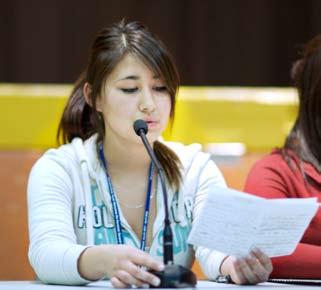
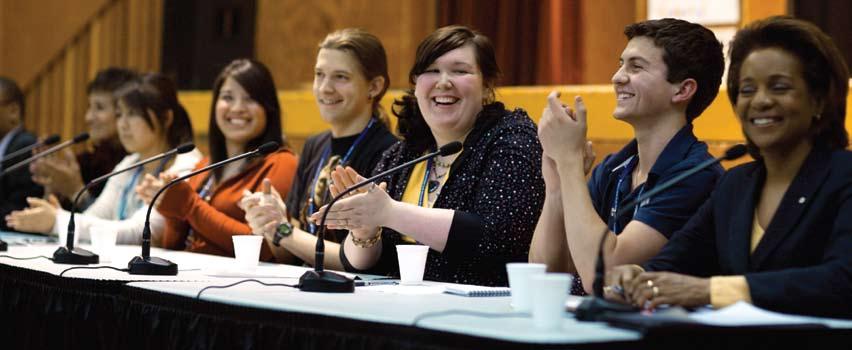
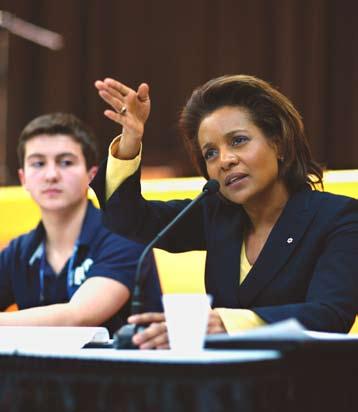

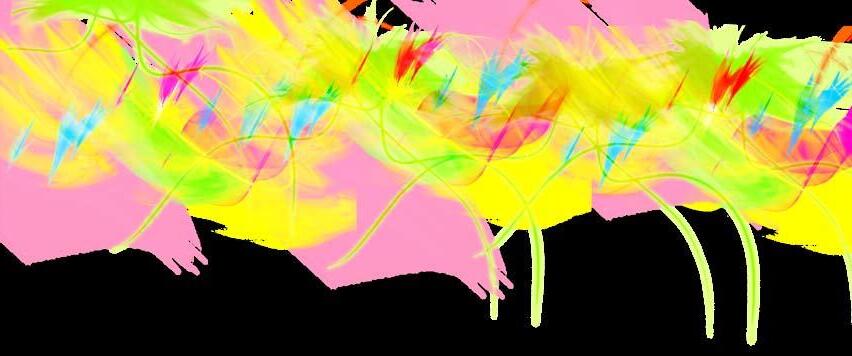
Jessica asked the Governor General how to help youth who lacked motivation, and to get parents and community members involved in their future. a ndrew, who was born in Inuvik and just accepted into the u niversity of a lberta’s s cience program, spoke of how living in an isolated community can still be full of benefits – “being minutes away from absolute wilderness,” and “we might live far from the south, but students selected for opportunities to travel are selected many more times.”
Taisha believed in the potential of youth in Inuvik, and plans to go for training in makeup artistry in Vancouver after graduation. s he wanted to see more opportunities for artistic students. s he said, “If we offered more creative programs such as photography and filmmaking, for students who are creatively inclined but not interested in sports…it will help students stay out of trouble.”
Britney is only fourteen, but already vice-president of the student leadership council and has represented n WT premier floyd roland in youth parliament. s he said, “ you have to be in school to get these opportunities.” s he continued, “I like school… most days,” making the audience laugh knowingly, but stressed that it pains her to see only “half” of the school population present on Mondays.
59
Visit the Governor General’s website www.citizenvoices.gg.ca to engage in more youth dialogues, and learn about art and mentorship opportunities!
You have to be in school to get these opportunities.
Youth Speak Up Nutaqat Uqaqtut
The Youth Panel: (R-L) Cameron McDonald (next to Michaelle Jean, the Governor General), Jessica Hailey, Andrew Fair, Taisha Blake and Britney Lucas Cockney. Britney
Rising Up for Inuit Education
Mary Simon ‘hears the sound of rolling thunder’ at National Inuit Education Summit
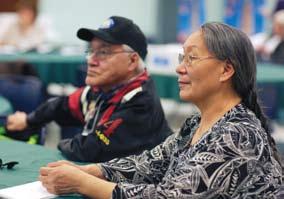
The summit was conducted in a variety of languages, including Inuktitut.
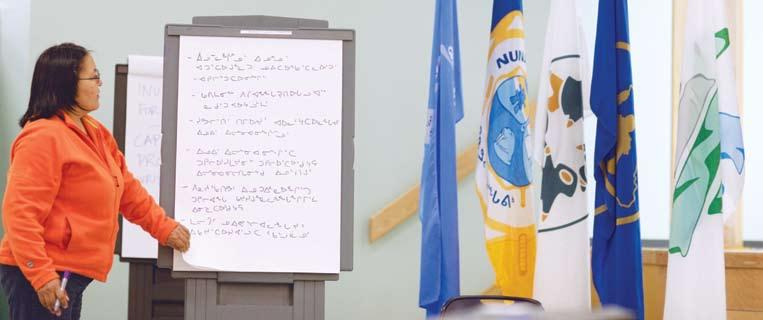
Inher closing address to the n ational Inuit Education s ummit held in Inuvik this a pril, n ational Inuit leader Mary s imon, president of ITk said, “If people ask us back home if we heard anything new at the Education s ummit, I will say, ‘ yes, I heard the sound of rolling thunder.’ That is the sound, in n unatsiavut, in n unavik, in n unavut, and in the Inuvialuit region, of Inuit rising up to reclaim our role as stewards of our children’s education. Through our land claims, Inuit have taken back the stewardship of our land and our resources, and now, we have our eyes firmly set on transforming our education systems. We must build on our successes.”
o ver the course of the summit, 75 summit delegates spoke out in different Inuit dialects, and in English about their hopes and frustrations regarding Inuit education. four research papers released by ITk provided a foundation upon which delegates discussed capacity building; building post-secondary success; investing in what to teach and how to teach; graduating bilingual students; mobilizing partners in education; and collecting and sharing information. Inuit education is at a crucial point: studies show that less than 25% of Inuit who started school graduate, a significantly lower proportion compared to other Canadians.
a n issue of resounding urgency is the loss of Inuit language. Inuit educators hope that an Inuit Language protection act can be passed in Canada, but say that they are determined to carry on the language regardless.
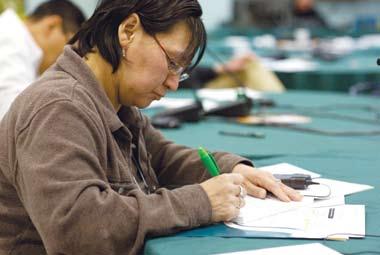
There was a general consensus that the language needed to stay relevant. n ew vocabulary has to be developed so that the language can reflect modern ways of living.
“There used to be about 140 aboriginal languages, and now there are only three that might survive. I am really concerned about it, because I believe your culture is tied to your identity,” said Mary Simon. “The language has to grow, it’s like what the Governor General said, if you don’t have a word in your language, take the English word and incorporate it into yours. Most languages have done that.”
This first ever National Inuit Education Summit was marked by the participation of h er Excellency the r ight h onourable Michaelle Jean, Governor General of Canada, who delivered the summit keynote address. Mary said that the Governor General’s impassioned speech was “truly inspiring, and captured the essence of what we are working to achieve – collectively – for our children and youth.”
TUSAAYAKSAT SUMMER 2008 60
“ In The News Tusaayaksani
Molly, a teacher from ulukhaktok takes notes.
In her speech, Michaelle Jean spoke of what she heard from youth at the Youth Town Hall event the night before. “Contrary to popular opinion, Inuit and Northern youth are not apathetic and unwilling to learn. They simply want the same opportunity as their counterparts in the south. And I think we all have a responsibility to make their wishes come true, for the future of the Arctic and I’ll really say, for the future of Canada – it depends on our ability to establish necessary conditions for all students to flourish."
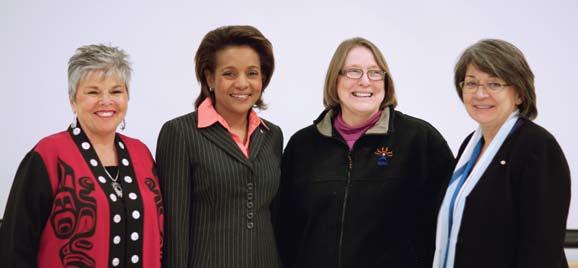
"a nd this is why your decision to discuss a national education strategy is so important. Together we must change the startling statistics that less than 1/3 of Northern youth finish high school, even though they make up more than ½ the population. The key to turning the tide, and the students told me this last night, is when encouragement comes from parents, from families, from teachers. This really motivates students to succeed.”
During the summit, Inuit, their partner organizations, and government representatives made significant progress towards establishing a national committee to develop and implement a national strategy on Inuit education.
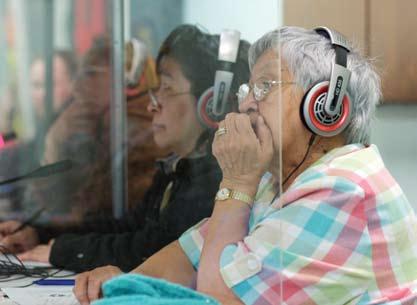
Mary s imon said, “I am very excited about the Inuit Education accord. Everyone’s agreed to this draft. o nce it’s signed, we are going to set up the n ational steering Committee, which will start to bring it all together. I hope within a year we’ll have developed a n ational Inuit Education strategy. We have to have big plans, we have to think big, because otherwise we won’t get it. people who think big really make things happen. We’ve done that in a lot of other areas, and we need to do that with education.”
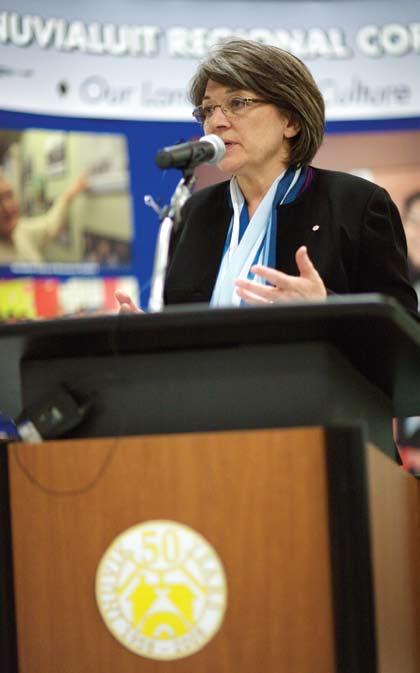
61
Top: Mary Simon encouraged Inuit language educators and policy makers to make the language more relevant to modern life.
Bottom: Elder Rosie Albert and Mary Inuktalik from ulukhaktok translate for the audience in real time as speakers make their presentations.
Working together for education: Roberta Jamieson (president of NAAF), Governor General Michaelle Jean, IRC Chair Nellie Cournoyea, and ITK president Mary Simon.
Pautuktit Native Women’s Association president said her organiziation will continue working to contribute towards the protection of language.
Curious Minds:


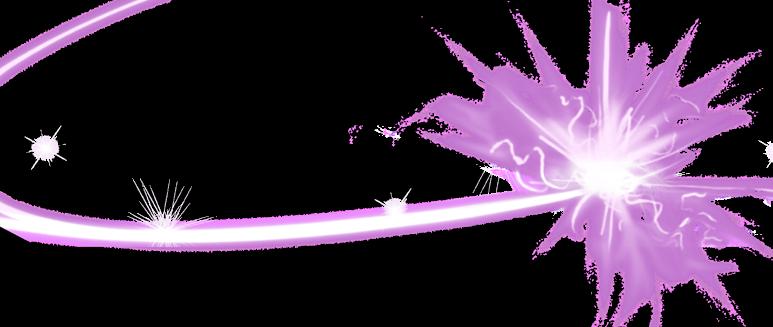
Children from Tuktoyaktuk excitedly crowded around Michaelle Jean, governor general of Canada, because they heard she can perform magic (details in story).
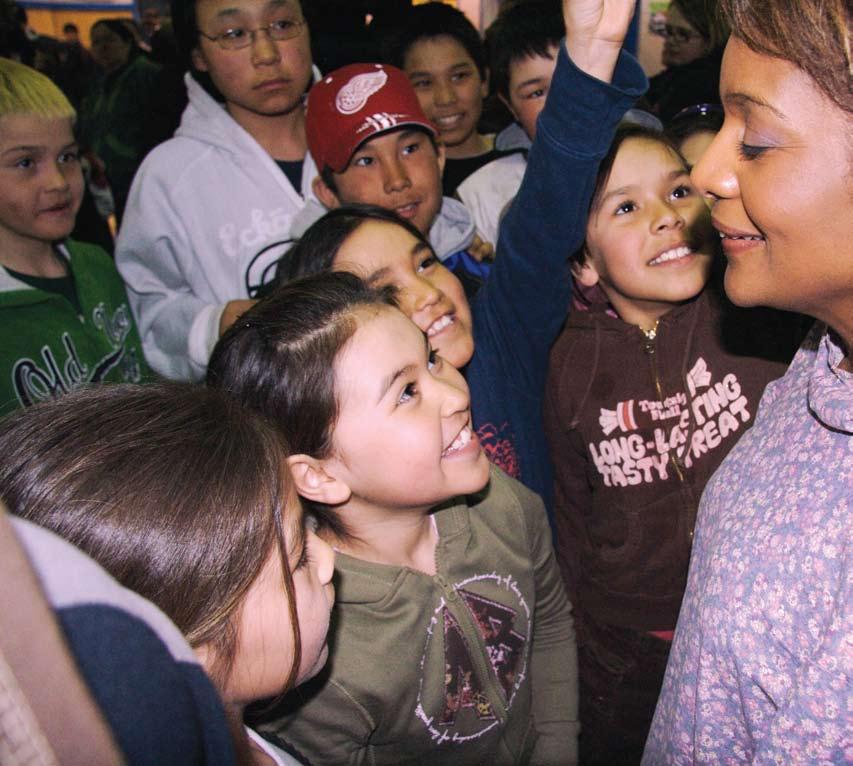
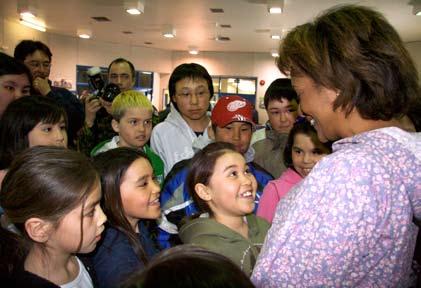
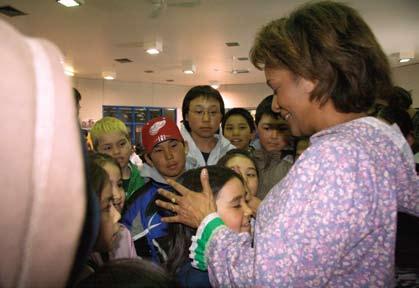
TUSAAYAKSAT SUMMER 2008 62
“Which one’s the governor general?” a young girl giggled as she asked me. We were in k itti h all in Tuktoyaktuk, where the doors had just swung open to minus-thirty degree weather outside. The Governor General, Michaelle Jean, and her entourage of staff, security personnel, press photographer, and videographer were making their official entrance. admittedly, her Excellency Michaelle Jean is so down to earth and casually dressed that it would be hard for the girl to guess she was the VI p a lso, Inuit northerners usually have more urgent priorities than who’s who in government, especially after having experienced many boom and busts caused by government decisions. n evertheless, two nights ago, I had witnessed the empowering effect the Governor General had on youth who attended the youth Town h all in Inuvik. I knew that the young girl might be shy to approach the Governor General, but that it would be a good experience for her.
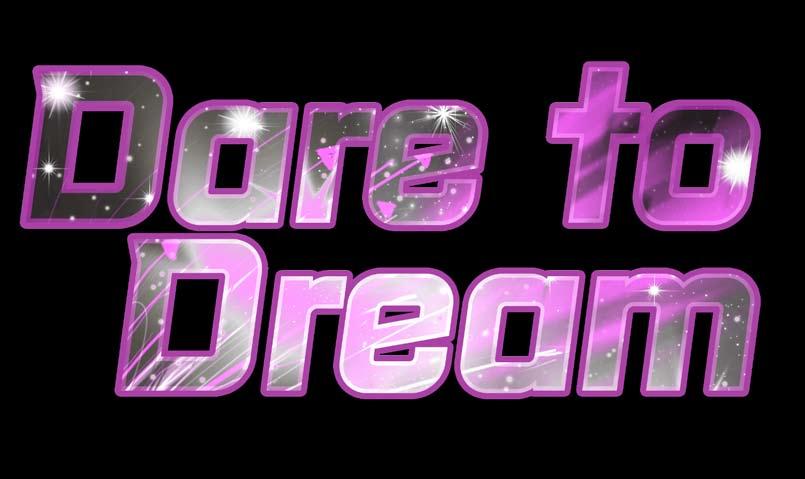
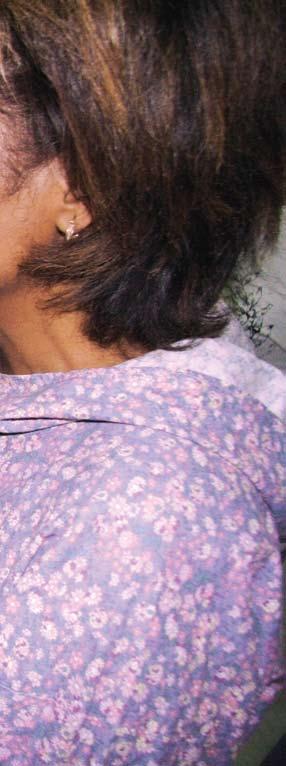
63
“I think the message they [youth] must receive from us is don’t be afraid to think big. We need to encourage our children to reach for the stars, they have the potential, they are intelligent, they are beautiful, they have the energy, they can make it.”
Michaelle Jean
Words and photos by Zoe Ho
“
s he’s magic,” I said. “When she touches you, you will start glowing like stars, like fireworks!” The girl eyes widened, and she giggled, “ really?” There was an unprecedented turnout at k itti h all. Everyone in Tuktoyaktuk, young and old, were curious and excited to welcome the Governor General to their community.
They could not wait to hear and see why Inuvik cannot stop gushing about her. Even children were given the day off from school to come to Kitti Hall. Although this was the fourth day of her five-day official visit to Inuvik and Tuktoyaktuk, the Governor General had already participated fully in community events, visiting the Gwich’in Wellness Centre, awarding n ellie Cournoyea with the Governor General’s n orthern Medal, hosting a youth Town h all, working with elders and community leaders, encouraging Inuit educators at the Inuit Education s ummit, and hanging out with youth at the Inuvik youth Center.
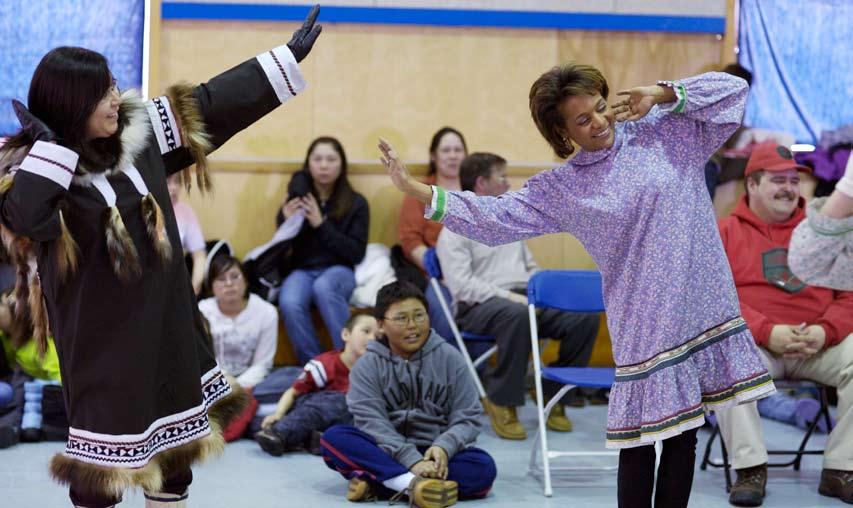
s he has also climbed onto the blanket toss with elder a bel Tingmiak to take a turn, and drum danced with the same rhythm as Inuvik’s elders and children. There was a storm on this day, but it did not stop her from carrying her message to Tuktoyaktuk.
Michaelle Jean began her speech, reiterating to Tuktoyaktuk her gratitude and delight expressed in Inuvik, to be once more “at the edge of the world,” to “visit this region filled with treasures,” and to get to know people “with a history of endurance, resourcefulness, and wisdom dating back thousands of years.”
“I know the full measure of determination and courage it took for you to preserve your stories, traditions, cultures, and languages, as you found yourself suddenly thrust into a completely different world,” she said, “o ne thing is clear, the n orth is at a turning point in its history and development. It is urgent that you prepare your youth to take the lead in developing your resources, in all aspects of society.”
s he then spoke directly to the young people in the room. “Dare to dream big, make those dreams a reality. s eize every opportunity and do so with confidence and pride in who you are.”
“What is your dream? To become a doctor, mechanic, pilot, sculptor, architect, cook, carpenter, engineer, truck driver, or even Governor General? Why not?”
The room was hanging onto her every word. a s she had everywhere else on this n orthern visit, Michaelle Jean had broken down barriers, becoming a human who cared, instead of just an official figure to everyone in the room.
s he was once “born in the poorest country in the a mericas, h aiti,” she had “never imagined, that one day, she would “have the immense privilege of crossing the a rctic Circle to stand before you now and tell you how proud I am of you.”
TUSAAYAKSAT SUMMER 2008 64
The Governor General is not shy to say “I love you, I am proud of you,” to everyone she meets, especially youth. “She’s so personable and takes time for everybody,” said Jackie Jacobson, MLA of Nunakput and homeboy of Tuktoyaktuk.
TUSAAYAKSAT SUMMER 2008 64 Special Feature Nuitaniqsaq Quliaq
“She redefining the role of governor general, she’s really raised the bar.”
s haring culture: The Tuktoyaktuk Drummers and Dancers showed Michaelle Jean some movement dances.
after her speech, the Governor General enjoyed a demonstration of a rctic sports by Craig Gruben and Matthew a nakina. s he then donned an atigi (traditional parka cover) and joined in the drum dance with the Tuktoyaktuk Drummers and Dancers. s he even managed to invite Jackie Jacobson, n unakput ML a , and hamlet mayor Merven Gruben to dance with everyone.

“We were dancing and I haven’t drum danced for 40 years,” said Merven. “It was really good. Everybody just fell in love with her, I think.” Merven was also glad the Governor General had promised to take the concerns of his community to Chuck strahl, minister of Indian and n orthern affairs.


a s always, the Governor General makes time to speak to everyone she could before leaving for the next place on her agenda. s he even showed the drum dancers a h aitian dance. The delighted drummers and dancers declared her an honorary member of their group. a n hour later, as she is really about to leave, a group of youth swarmed up to her, led by Ruby Nasogaluak, the young girl whom at first did not know who the Governor General was.
one of us: The Tuktoyaktuk Drummers and Dancers declared Michaelle Jean to be a great dancer, and immediately made her an honorary member!
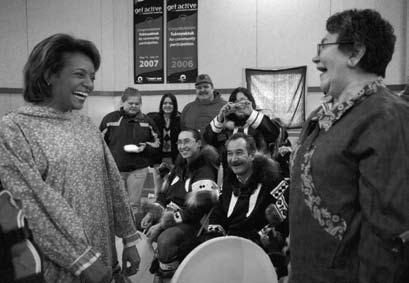
“She’s really passionate in the way she talks about the North and the way she talks about the youth. The youth that you’re seeing today is our future, not only the Inuvialuit, but all the youth of Tuk. Like she says, dream big!”
“Are you magic?”
She asked the Governor General. “I heard if you do magic on me, I’ll light up.”
Eunice Nasogaluak enjoyed the Governor General’s sense of humour.
Michaelle Jean recovered from her surprise quickly and jumped into the role of dream collector and magician, creating Harry Potter worthy sound effects, her fingers dancing around the child’s head.

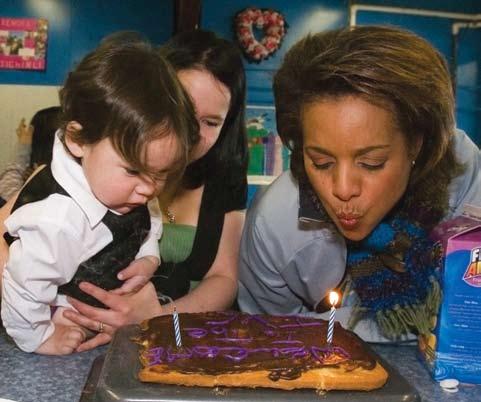
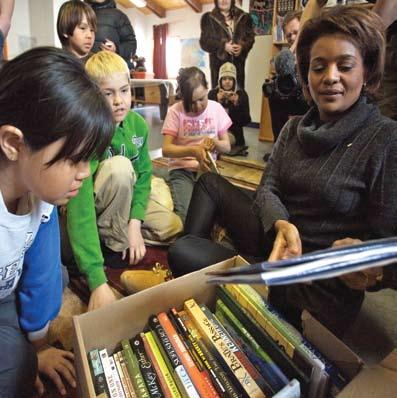
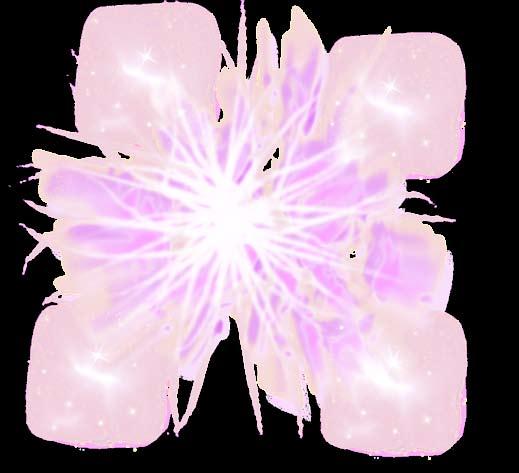
“What are your dreams?” she asked, “What do you want to be?” The rest of the children all wanted their turn and the Governor General willingly performed her magic for every last one of them. Later, when asked about the dreams she had collected, she said, “it was nice…a lot of them said it’s graduating.”
Tuk youth Chelsea Jacobson said although she did not think much of the visit before she met the Governor General , the visit now “meant a lot to me and a lot to the community.”
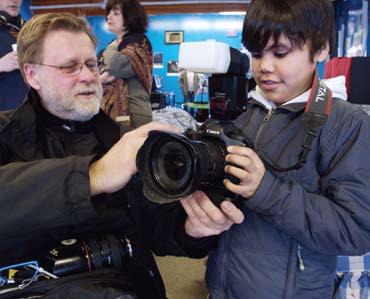
“ s he just showed all our communities that she really cares and she is just perfect for the job. When she was sitting down with all the kids at the youth center, reading books and singing them a little song, it was so cute.”
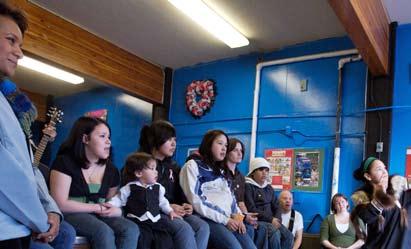
TUSAAYAKSAT SUMMER 2008 66
66 Special Feature Nuitaniqsaq Quliaq Michalle Jean reads with youth at the Tuktoyaktuk Youth Center.
“She told us to just go for it and to dream big, and she believes in us and is rooting us on, and it makes me want to…and I am sure it makes all the kids want to just go for their dreams and just do it!”
Inuvik’s highschool students were happy to meet the Governor General as she sends off students for the summer on board the Amundsen program.
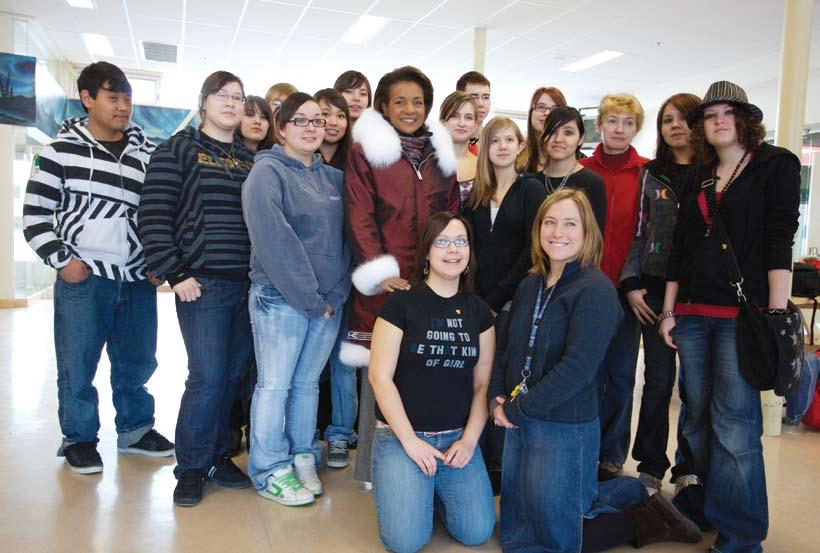
>> Drum dancing in Inuvik:
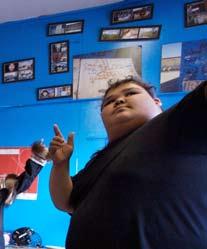
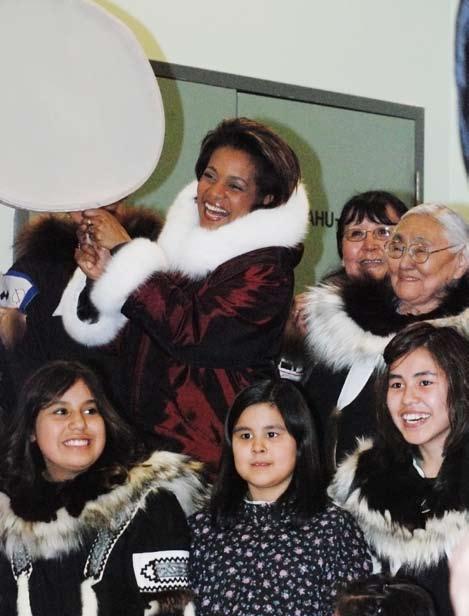
Wearing a parka made specially for her by Jessie Colton, Michalle Jean delighted the community by participating fully in drum dancing, even getting on the blanket toss with Abel Tingmiak!
<<Meeting new friends:
(L) Shannia Jacobson Blake was happy to take pictures with Canadian Press photographer Fred Chartrand’s camera.
(r) The results: Shannia’s picture of the governor general and Tali Warrington’s son blowing out the candles on a cake Tali made for the occassion.

67
<< proud moment: Trista Arey and Bonnie Jacobson of Inuvik’s youth center performed for the Governor General. Jordan Maring (not pictured) also drum danced.
photo above by phil Morin: www.inuvikphotos.ca
Northern Medal Awarded to Nellie
Inuvik, a pril 14th, 2008 - The congratulatory speeches were full of respect and admiration. n WT Commissioner Tony Whitford saluted n ellie Cournoyea’s achievements, before she went on stage to receive the n orthern Medal from her Excellency the Governor General. h e said, “ you are the most worthy recipient…you have devoted your life to serving the public and have remained your entire life in the n orth to serve.” The Governor General described n ellie as “our bright n orth star, guiding us like a promise…of hope,” and said she believed it was “high time the s outh heard a little about the n orth…the extraordinary things that are happening here. That up here, there are people with vision, courage, and daring” like n ellie, who sensed when the n orth was at a point of change in history and economic development, and has seized the opportunity to do good for the people of the n orthwest Territories, and its aboriginal peoples.
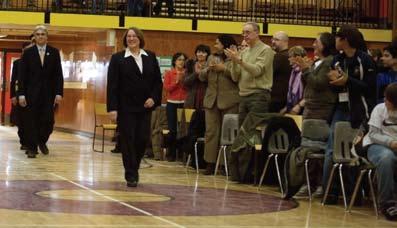
n ellie Counoyea, currently CEo and Chair of I rC, is known for her dedication to the advancement of n ortherners since the days of landclaims negotiations. She was also the first woman premier of the n orthwest Territories, as well as an active volunteer for Inuit arts, sports and culture.
n ellie accepted her medal humbly, taking it as an opportunity to thank the people who have helped her. “I know there is a lot of talk of leadership,” she said, “but it’s a position. It doesn’t matter the most, it is the people who are around and contributing, helping to reach a goal that matter.”
The Inuvialuit leader also took the chance to address youth present, “Everyday’s a new day, there’s new life, new ideas, something new –happens to someone, some where, that’s inspirational…o ur society is made up of not only one Inuit group, we all have different dialects, different styles and respect each other.”
“We all need each other, not one person can figure out how we are all going to live and survive with a lot of the changes being made. It’s an exciting time, we can overcome any challenges and difficulties that are in our way together.”
The Governor General awards the n orthern Medal once a year to a northerner who has made an outstanding contribution to the strengthening of Canada’s northern communities, and who promote a greater awareness and understanding of the n orth. The last recipient of this award was Inuit environmental activist s heila Watt-Coultier.
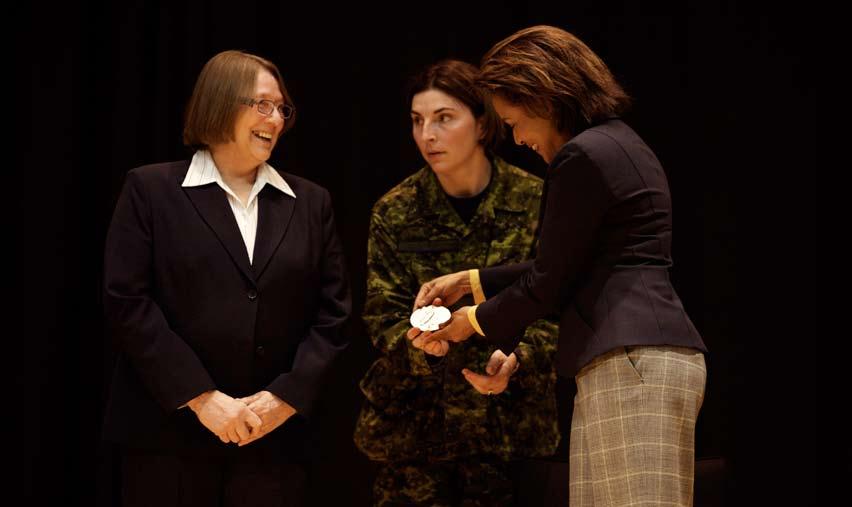
TUSAAYAKSAT SUMMER 2008 68
“Itdoesn’t matter where you’ve come from, it’s so important to realize that everyone has been born into this world to do something. You can’t just say that you’ve the great privilege of being a human being and then waste it.”
In The News Tusaayaksani
Nellie Cournoyea, CEO of IRC receiving the Northern Medal from her Excellency, Governor General Michaelle Jean in the hall of Sir Alexander Mackenzie School.
Nellie is welcomed by a standing ovation as she enters the hall.
InuvialuitDaywas celebrated on June 5th this year, marking the 24th year since the signing of the Inuvialuit Final Agreement (IFA.) Elders, adults and children alike rejoiced in their celebrations of having a landclaim agreement that protects their land ownership and traditional culture, as well as social and economic development. More children than ever were drum dancing this year! We look forward to celebrating the 25th anniversary of the IFA next year.
Inuvialuit Day 2008
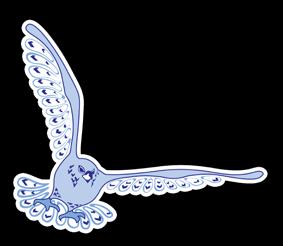
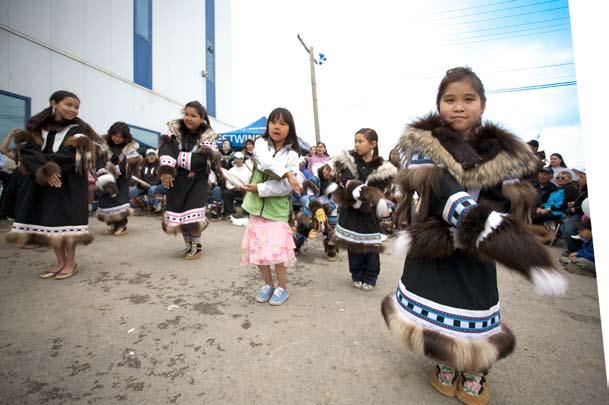
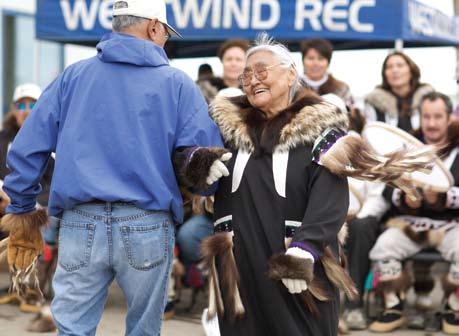
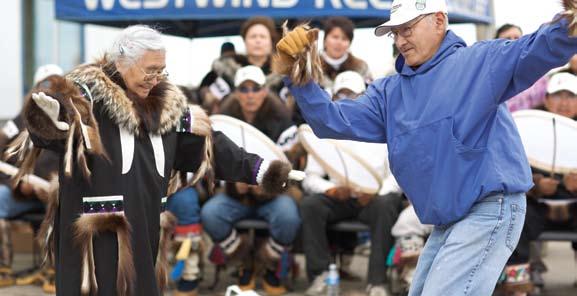
69
In The News Tusaayaksani
Elder Sarah Tingmiak and her son Abel danced with sheer joy with the accompaniment of the Inuvik Drummers and Dancers.
More youth than ever are picking up the art of drum dancing, and taking their part in performing on Inuvialuit Day outside the IRC building.
Photos by David Stewart
Healing Support for Residential School Survivors
Words by Simon Routh
This past June, Inuvialuit regional Corporation (I rC) organized its third tour of the Inuvialuit communities to give information to beneficiaries about the residential school settlement.
The evening meetings talked about how former students and their families can access counselling and other health supports, how former students can get compensation for abuse, and how everyone affected by residential schools can tell their story through the Truth and reconciliation Commission (TrC).
Starting in Aklavik on June 4 and finishing in Ulukhaktok on June 25, each meeting was chaired by John Banksland, a director of the n ational residential s chool s urvivors s ociety and a former student who spent 16 years in residential school.

“This process is something new. It’s something new for Inuvialuit, it’s something new for Canada,” John said. “We’re traveling to all of the communities to help make sure Inuvialuit are able to get information and get involved.”
The meetings included representatives from the Independent a ssessment process (I ap) and the Truth and reconciliation Commission.
s eetal s unga and Viola Thomas traveled to the region to present information on the Truth and reconciliation Commission, which will allow anyone affected by residential schools to share their experience, in private or in public, with the Commission. The TrC will also provide funding for communities to design their own community events.
I rC Chair n ellie Cournoyea is working to have one of the seven national Truth and reconciliation events in the Beaufort Delta region.
“If you look at the former students who came from the Beaufort Delta, the Central a rctic, and the s ahtu, they make up a greater number than anywhere else in the n orth, and the large majority of them went to school in a klavik and Inuvik.”
The TruTh And reconcIlIATIon commIssIon (Trc )?
The TRC will work for five years to allow former students and their families members to share their stories and to educate all Canadians about residential schools and their impacts.
The TRC will hold seven national events.
The TRC will provide funding for community events, designed by communities.
The TRC will support ways of permanently honouring former students (Commemoration).
Jeffery a mos, the resolution h ealth s upport Worker for the Beaufort Delta region, and n irrie k istan, a counsellor based in Inuvik who has worked with many former students, started the meetings by explaining that anyone who was affected by residential schools could get counselling. Jeffery also talked about his work to find elders in each community who can provide traditional cultural support— another program that former students or their families can access.
Linda Denis, from the I ap s ecretariat, talked about how former students who suffered sexual and serious physical abuse can seek compensation under the I ap, but also said that the process is a complicated one and having a lawyer is recommended.
a former student who went through an earlier version of the I ap, Margaret Carpenter was part of the s achs h arbour, Tuktoyaktuk, and u lukhaktok meetings, and spoke about her experience of the process.
“It was very
Margaret, “but at the end, I felt so much better. I had been carrying that story around inside me for so long. After my hearing, I shared my story with my family, so that they would understand too.”
Former students can get information about the residential school settlement and healing programs by contacting Brenda Ittungna at 867-777-7016 or Jeffery Amos at 867-777-7024 (collect calls accepted).
What is...
The IndependenT AssessmenT process (IAp)?
The IAP provides compensation for sexual abuse and serious physical abuse.
The IAP is not like going to court.
The IAP offers compensation for things that a lawsuit would not and is much faster than a lawsuit.
Former students do not have to pay any lawyer fees if their application is not successful.
There are many lawyers who can help former students with the IAP; here are some you can contact:
Len Marchand (toll-free: 1-877-385-8665); Laura Cabott (toll-free: 1-877-456-3105).
TUSAAYAKSAT SUMMER 2008 70 In The News Tusaayaksani
hard,” remembered
An historical photograph from All Saints Anglican Residential School (Aklavik.)
ICRC photo
Canada’s Apology: what it means
 By Rosemarie Kuptana
By Rosemarie Kuptana
June 11th, 2008
is a historic moment in the history of Canada. prime Minister stephen h arper issued an apology to the victims of the residential school system. Inuit leaders representing the four Canadian a rctic regions, as well as Inuit survivors of the residential schools were in attendance in the h ouse of Commons to receive the apology as official representatives of the Inuit communities in Canada. There were an estimated 3,500 Inuit who attended federal residential schools. Tusaayaksat asked rosemarie kuptana what it was like for her to hear the prime Minister's words.
AsI sat in the House of Commons Gallery on the day of the Apology, I sat in great anticipation, and amid thunderous applause as the Prime Minister entered. My friend and colleague Martha Flaherty and I sat together. Our national Inuit Leader, Mary Simon is on the floor of the Commons. There seems to be thousands of people – every seat is taken up in the House of Commons. I see many people I know and have worked with over the years. The Chair of the Truth and Reconciliation Commission, the Hon. Harry Laforme stops and talks with Martha and I. I wave at Merle Carpenter, from my home town!
Some people were hugging; others had been overtaken by the emotional and deeply moving event in our day and opening crying. I had never seen the House of Commons in this state of reverence.
I was deeply moved as the Prime Minister delivered his speech in English, French, Inuktitut, Cree, and Ojibway.
My eyes welled up with tears as Stephen Harper apologized on behalf of Canada to me as a former student. He spoke to my very soul. I remember my mother and father, as the PM apologized to the parents. The Apology for me was opening old wounds, ones that I would rather forget. I know that one must address and go through deep pain to begin healing.
I would move on. I had forgiven Canada a long time ago and took my work to the national and international stage to fight for the fundamental human rights of Inuit and Inuvialuit. Working for the rights of Inuit allowed me to forget my own hurts.
It was a magnificent day in Canada.
I am deeply saddened by those who passed away before they heard the apology from Canada. They too are remembered and acknowledged in the Apology.
On this day, I was a very proud Inuk Canadian.
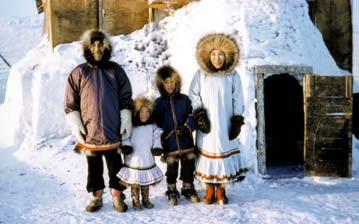
The government of the day did the right thing by beginning to address this important unfinished business between Canada, Inuit, First Nations, and Métis peoples.
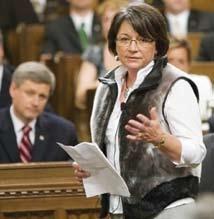
The Apology is one of the most significant milestones in our evolving relationship with Canada.
Inuvialuit and Inuit have land claims agreements with Canada which contain certain provisions for economic, hunting, training, royalty rights and so on. In the span of fifty years, we have made governance arrangements with Canada – this was the right thing to do. Now it is time for us as a people to turn our energies to addressing the social issues in our communities.
The Apology and Settlement Agreement provide the foundation to begin addressing the social problems in our communities, such as drug and alcohol abuse; the North badly needs a treatment center to address addictions. We need to provide parenting skills training, proper housing, and ensure that our young people are educated. Mary Simon stated in her speech that 16% of Inuit graduate from high school today. That is a dismal average – and who will provide the personnel for the institutions that govern us in the future?
The residential school issue is not a black and white matter.
It is not easy to understand unless you have walked in my shoes.
I have suffered through the same disorders that soldiers in wartime experience when they come back home. I was not allowed to speak my mother tongue, separated from my family and culture, and my children are products of the intergenerational issues associated with being residential school.
The Apology was an important step to the evolving relationship of Canada and Aboriginal Peoples; it is a step that will allow our relationship to “come of age”. The residential school package overall is critical to the human development of Inuit and Inuvialuit.
For instance, in the Inuvialuit region the first residential school was opened in 1926 and the last one closed in 1997. This is one of the most enduring and widespread operations of residential schools in Inuit history. Today one in three Inuvialuit are survivors. Now we have the choice to move on and address the social problems so that we may experience a “quality of life”.
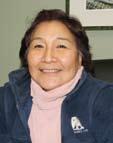
Special Feature Nuitaniqsaq Quliaq
ITK photo
Mary Simon in the House of Commons, during her speech following Canada’s apology to residential school students.
Rosemarie Kuptana
Rosemarie as a little girl, posing with her family.
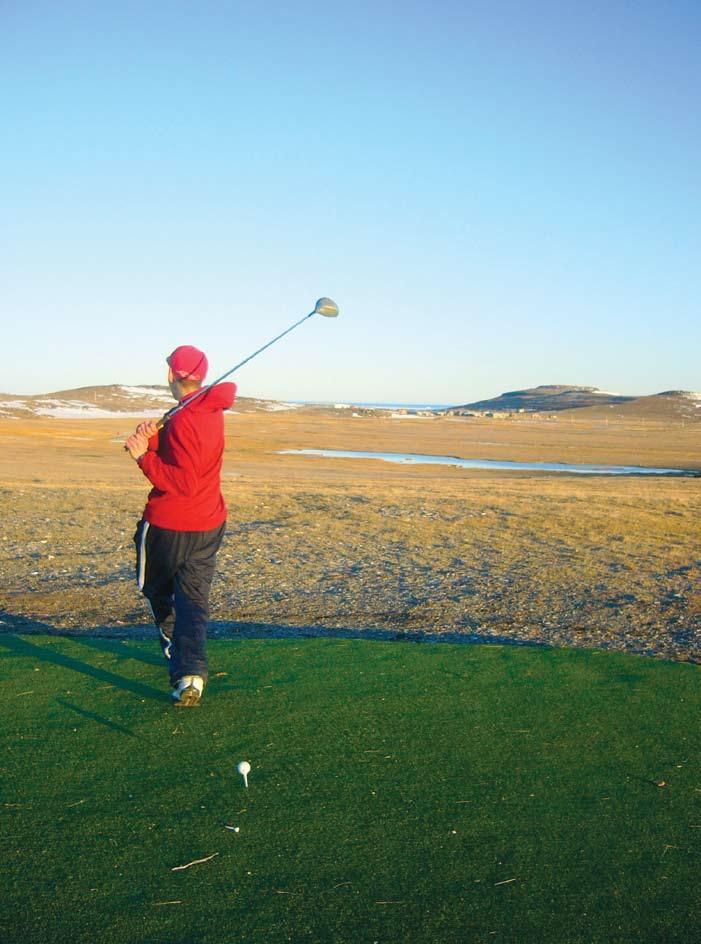
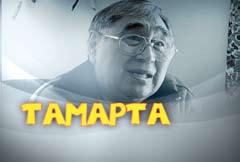
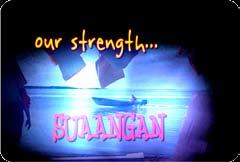
TUSAAYAKSAT SUMMER 2008 72 PO Box 1704 Inuvik NT X0E 0T0 Canada Post Contract 40049465 SUAANGAN To h ave s trength s outhern f eed (M s T) Tuesdays at 9pm and 12am northern feed (M s T) sundays at 6:30pm Tuesdays at 9pm and 12am fridays at 2:01pm Tamapta a ll of o ur p eople s outhern f eed (M s T) Wednesdays at 11:30am northern feed (M s T) sundays at 3:30pm Wednesdays at 11:30am and 8:30pm Thursdays at 3:30pm and 10pm InuVIk CaBLE ChannEL 12 & BELL ExprEssVu ChannEL 269 saTELLITE SUAANGAN AND TAMAPTA ARE IN RERUN SEASON! Here is the schedule: Golfing, at the top of the world. BILLY JOSS GOLF TOURNAMENT Summer, Ulukhaktok Tusaayaksat Inuvialuit News + Culture




























 Jumping for joy: Cole Elias, Lane Voudrach, Isabelle Hendrick, and Skyla Kagyut are part of the kindergarten graduates who sang a song about how fun it was to be going from kindergarten to grade one.
Words by Lindsay Trevelyan
Photo by Zoe Ho
Jumping for joy: Cole Elias, Lane Voudrach, Isabelle Hendrick, and Skyla Kagyut are part of the kindergarten graduates who sang a song about how fun it was to be going from kindergarten to grade one.
Words by Lindsay Trevelyan
Photo by Zoe Ho






























































































 Paraders on a kayak pass by Slim Semmler’s store.
The LIONS basketball team
Trucks were decorated back then too!
The old Mackenzie Hotel.
Paraders on a kayak pass by Slim Semmler’s store.
The LIONS basketball team
Trucks were decorated back then too!
The old Mackenzie Hotel.








 By Hailey Verbonac
By Hailey Verbonac



 by Hilary Charlie
by Hilary Charlie





















 By Anne Crossman, editor of Permafrost Media
By Anne Crossman, editor of Permafrost Media













 Ivvavik fall colours
Ivvavik fall colours
























































 By Rosemarie Kuptana
By Rosemarie Kuptana





